Seeking the ideal wood for a durable, eye-catching fence? Wondering which species stand the test of time? Dive in and discover the ultimate fencing solution to define your property!
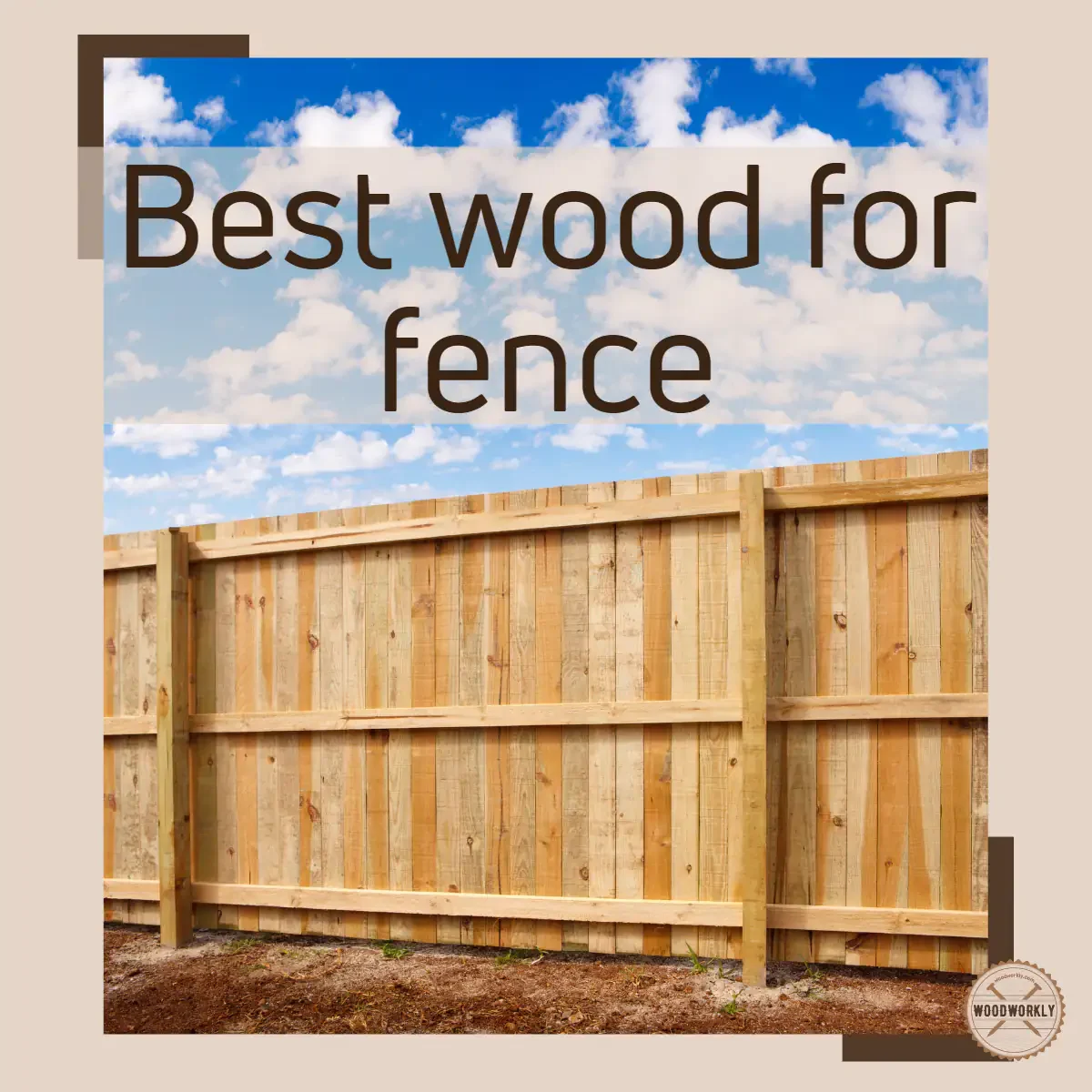
Have you ever been captivated by a neighborhood fence, perhaps due to its natural wood grain or how it enhances the landscape?
Now picture that fence as your own, serving both visual and functional purposes. The choice of wood is crucial for durability, aesthetics, and value.
As a homeowner, builder, or someone keen on property improvement, picking the right wood is key. Curious, I researched woods best suited for fences.
So, Here’re the Best wood for fence,
- Pine
- Redwood
- Spruce
- Cedar
- Sweetgum
- Cypress
- Black locust
- Osage orange
- Douglas fir
- Ipe or Brazilian walnut
- Bamboo
- Balau
- Oak
- Teak
- Composite
- Pressure treated wood
In this blog post, we’ll explore the best wood for fence by taking top wood options for fences and discuss their benefits and drawbacks, so you can make an informed choice and achieve the fence of your dreams.

Let’s dig in!
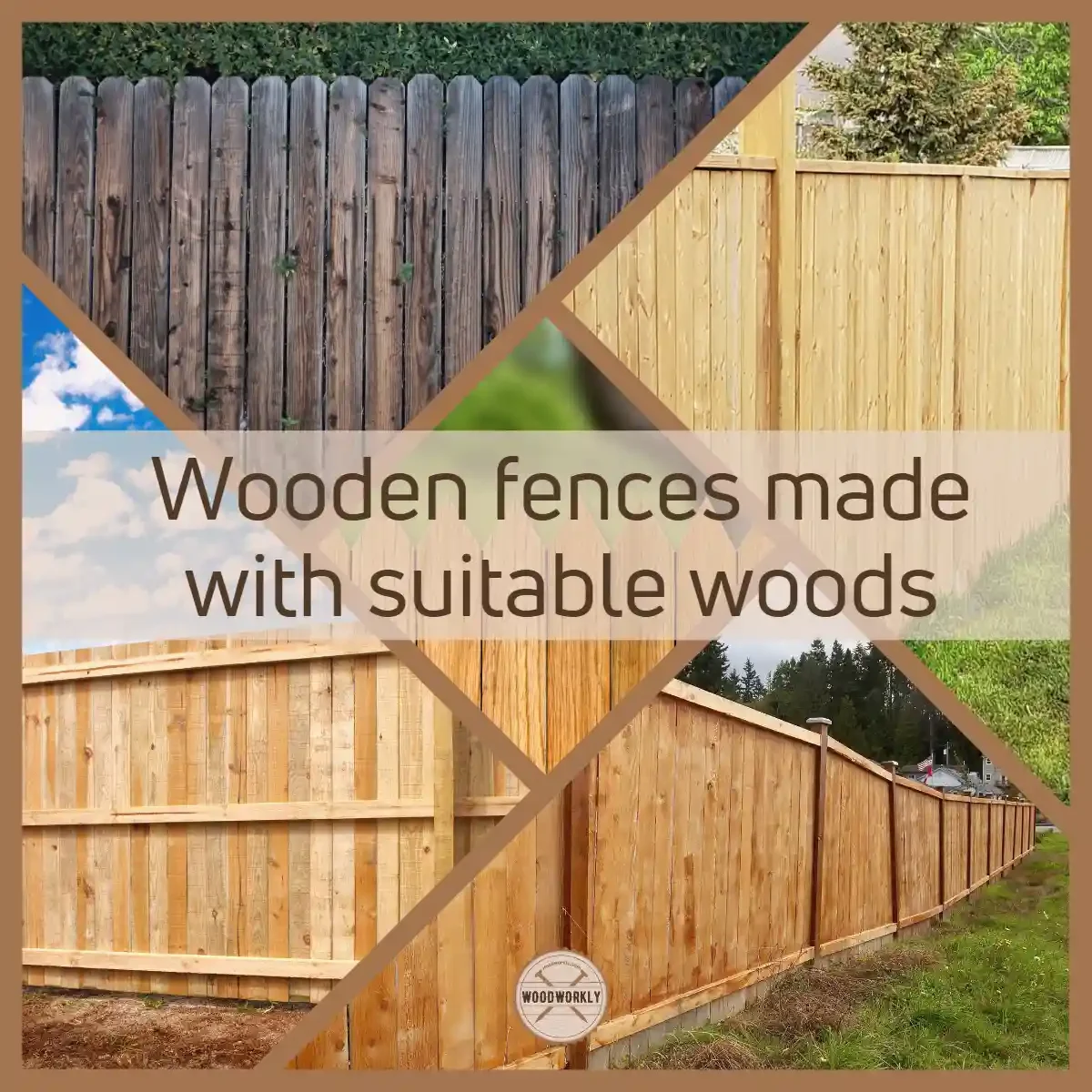
Things To Consider When Choosing The Right Wood For Fencing
- The durability of the wood
- Appearance of the wood
- Climate and your local weather
- Workability of the wood
- Maintenance of the wood
- Cost of the wood
- Local availability of the wood
- Sustainability of the wood
So, let’s discuss each of the above factors separately to get a good view of the things you should consider. This will make your selection a lot easier.
1. Durability Of The Wood
The lifespan of a fence hinges on the wood’s inherent resistance to decay, insects, and weather.
For outdoor projects, it’s essential to choose wood that can withstand elements like rain and snow.
Durable species like cedar, redwood, or pressure-treated pine are ideal, as they have a proven track record of enduring harsh conditions.
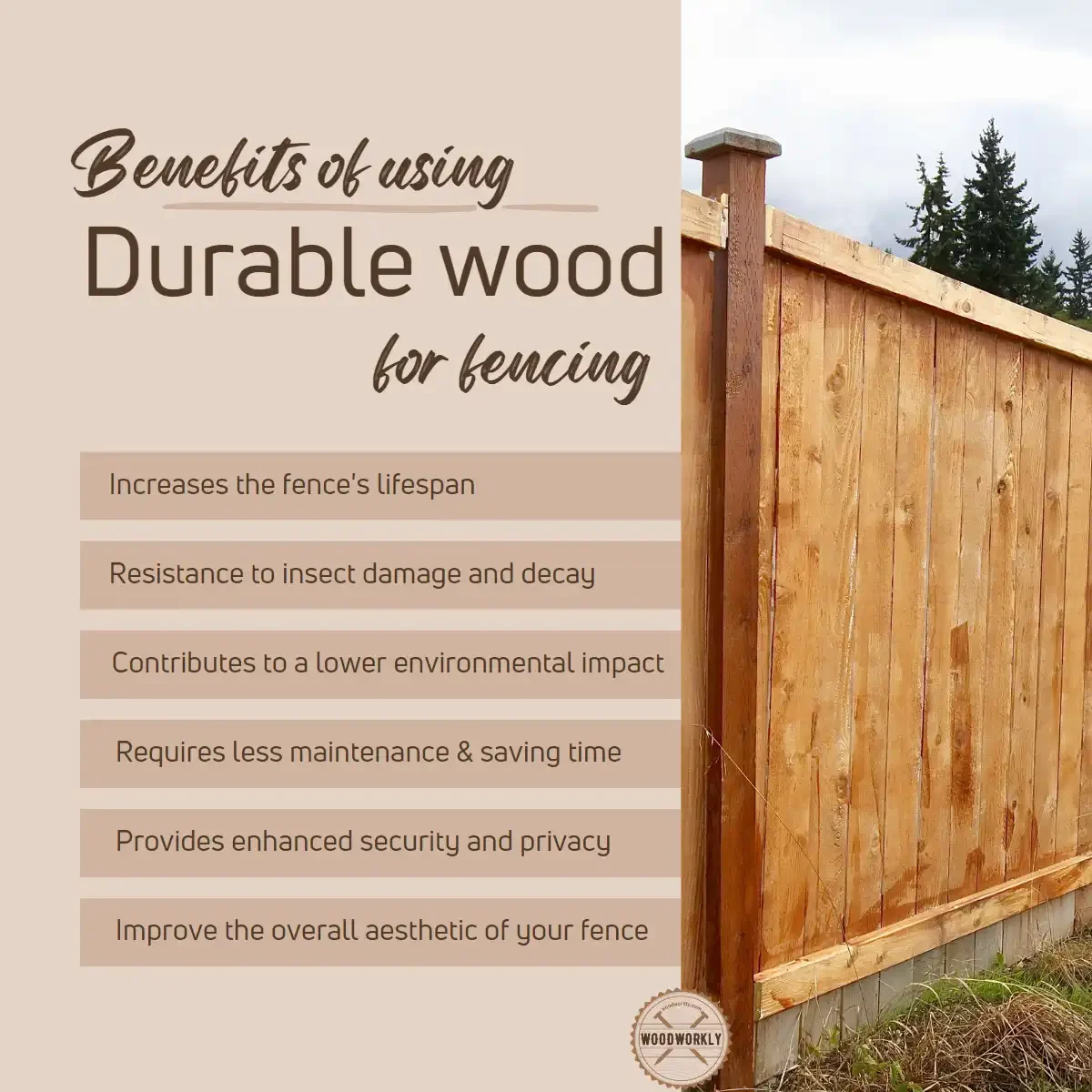
2. Appearance Of The Wood
A beautiful fence, often the first thing noticed and sometimes even seen as a reflection of property wealth, is highly valued.
The visual appeal is vital, with each wood species offering distinct grain patterns, color, and texture.
Consider how the wood’s look will complement your property and age, like cedar or redwood developing a silver-gray patina, while options like pressure-treated pine might need staining for upkeep.

3. Climate And Your Local Weather
The ideal wood for your fence significantly depends on your local climate, as different species suit different environmental conditions.
Cedar and redwood are optimal for humid climates, offering moisture resistance, while pressure-treated pine adapts well to various weather conditions.
It’s important not to replicate choices made in other states or countries with differing climates.
Consider your area’s temperature extremes, moisture levels, wind strength, and climate variability.
Consult local professionals for advice on the best wood choice for your region’s specific weather conditions.
Check out Best Methods to Protect Outdoor Wood Furniture!
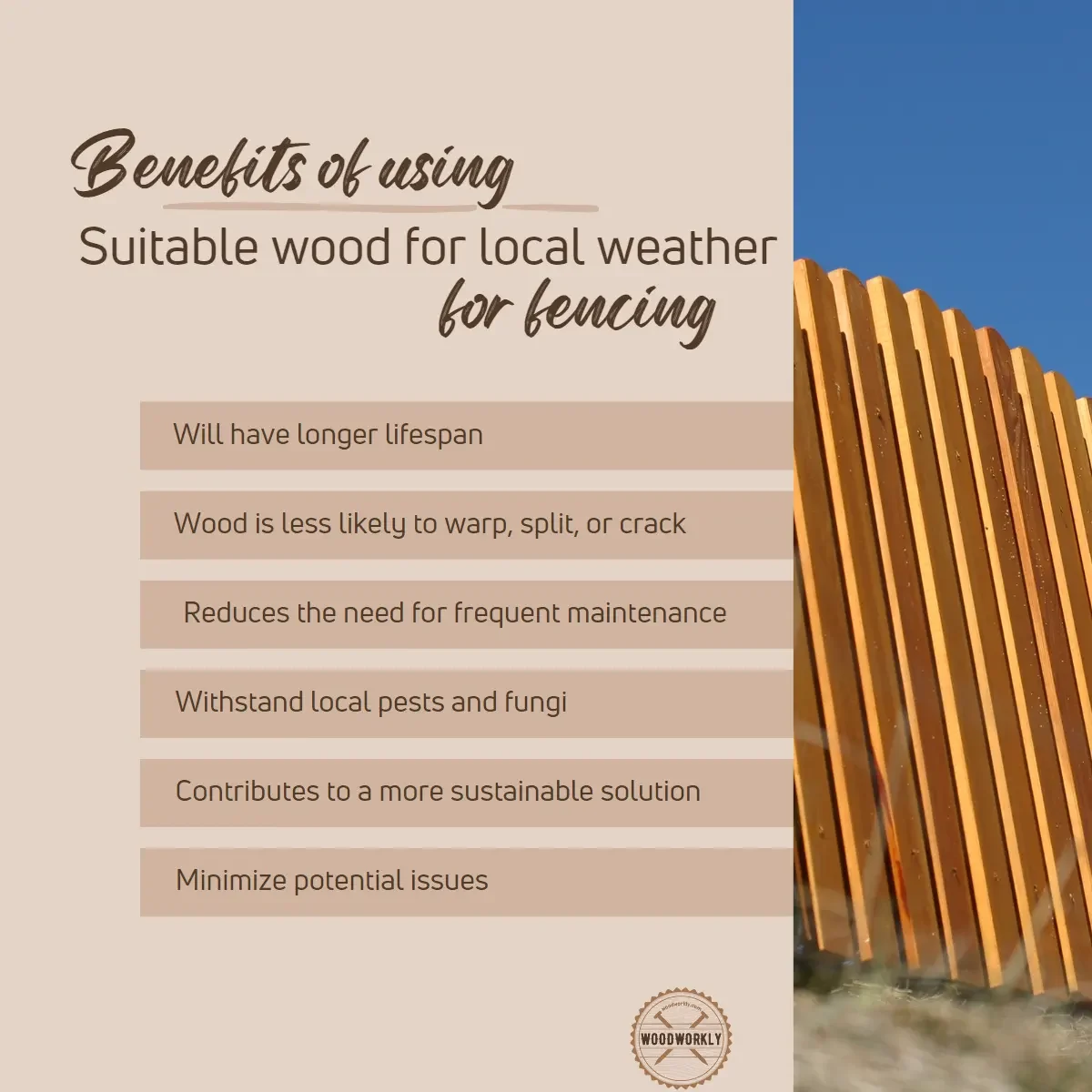
4. Workability Of The Wood
Wood workability, affecting the ease of cutting, shaping, and fastening during fence construction, is crucial.
Softer woods offer smoother cuts and easier handling, while denser hardwoods might need specialized tools and techniques.
Choosing wood with better workability ensures a more efficient and less challenging build process.
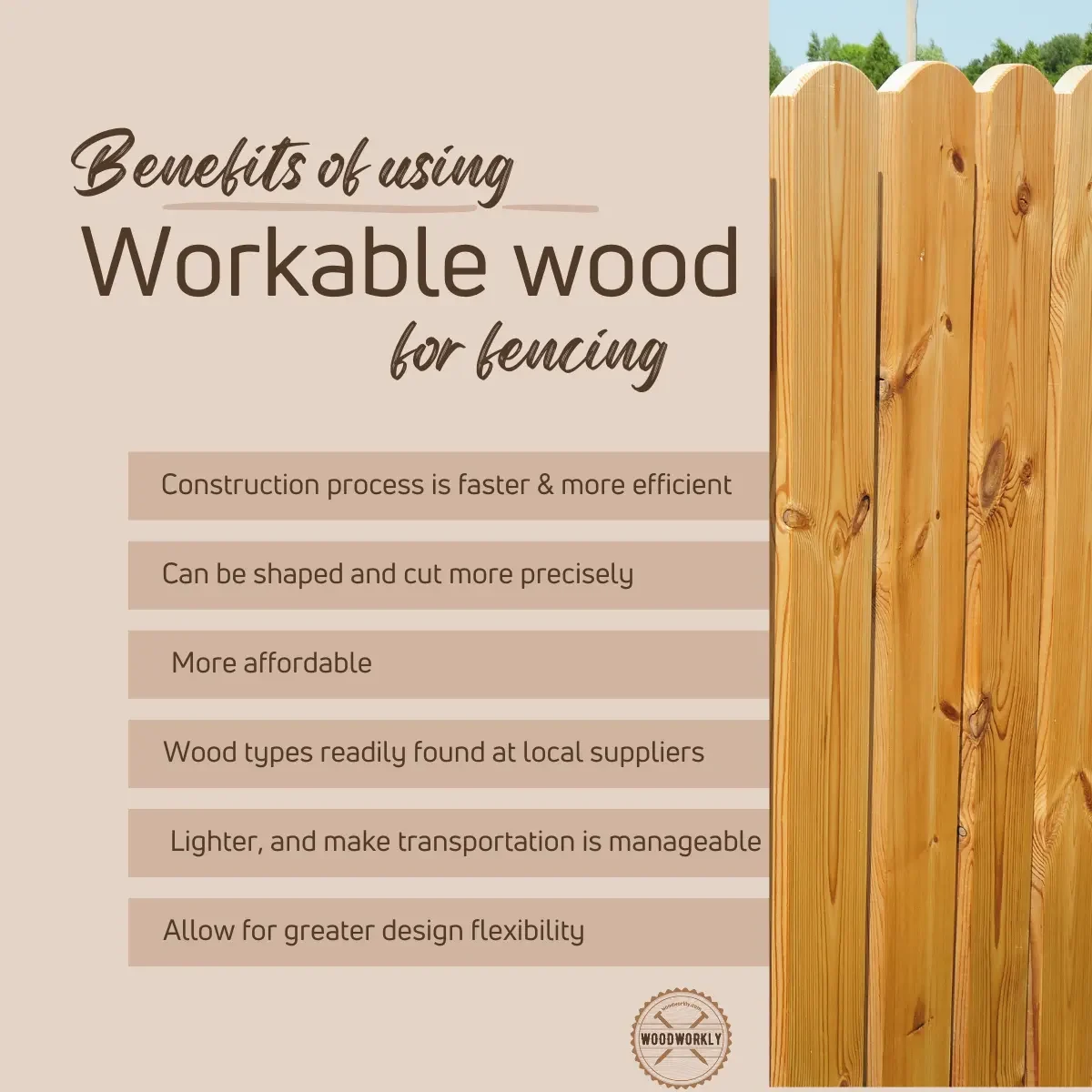
5. Maintenance of The Wood
Maintenance requirements differ across wood species, with some needing frequent care and others being low-maintenance.
Woods like cedar and redwood, containing natural oils, require less upkeep as they resist decay and insects.
Conversely, pressure-treated pine often demands extra treatments like staining or sealing to preserve its integrity and appearance, potentially incurring costs that surpass initial purchase expenses.
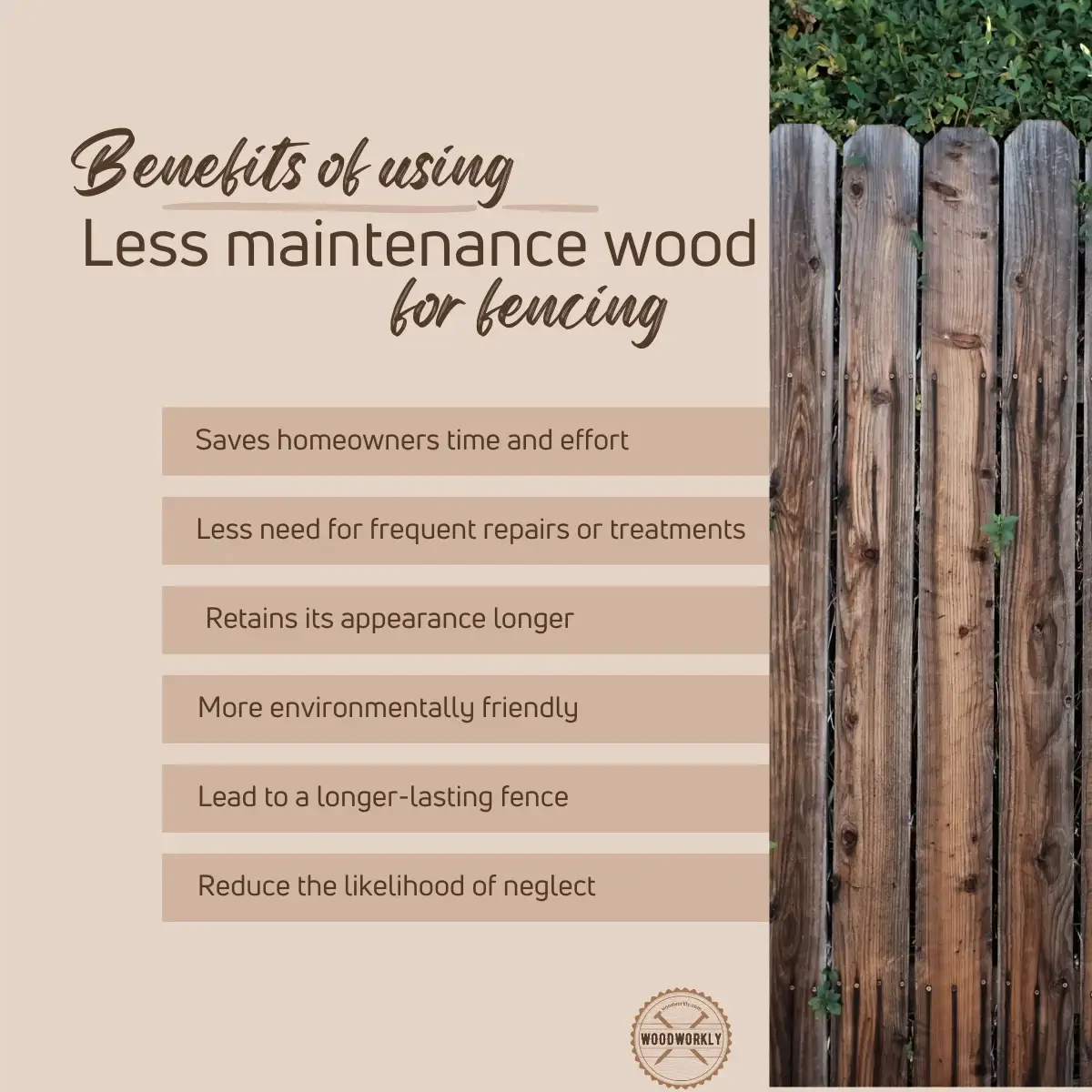
6. Cost Of The Wood
When choosing your fence wood, budget is key.
Cedar and redwood, prized for durability and aesthetics, tend to be pricier, while pressure-treated pine is a budget-friendly alternative.
Remember, a lower upfront cost might lead to greater maintenance expenses or a shorter fence life.
It’s wise to consider both immediate and long-term costs in your decision.
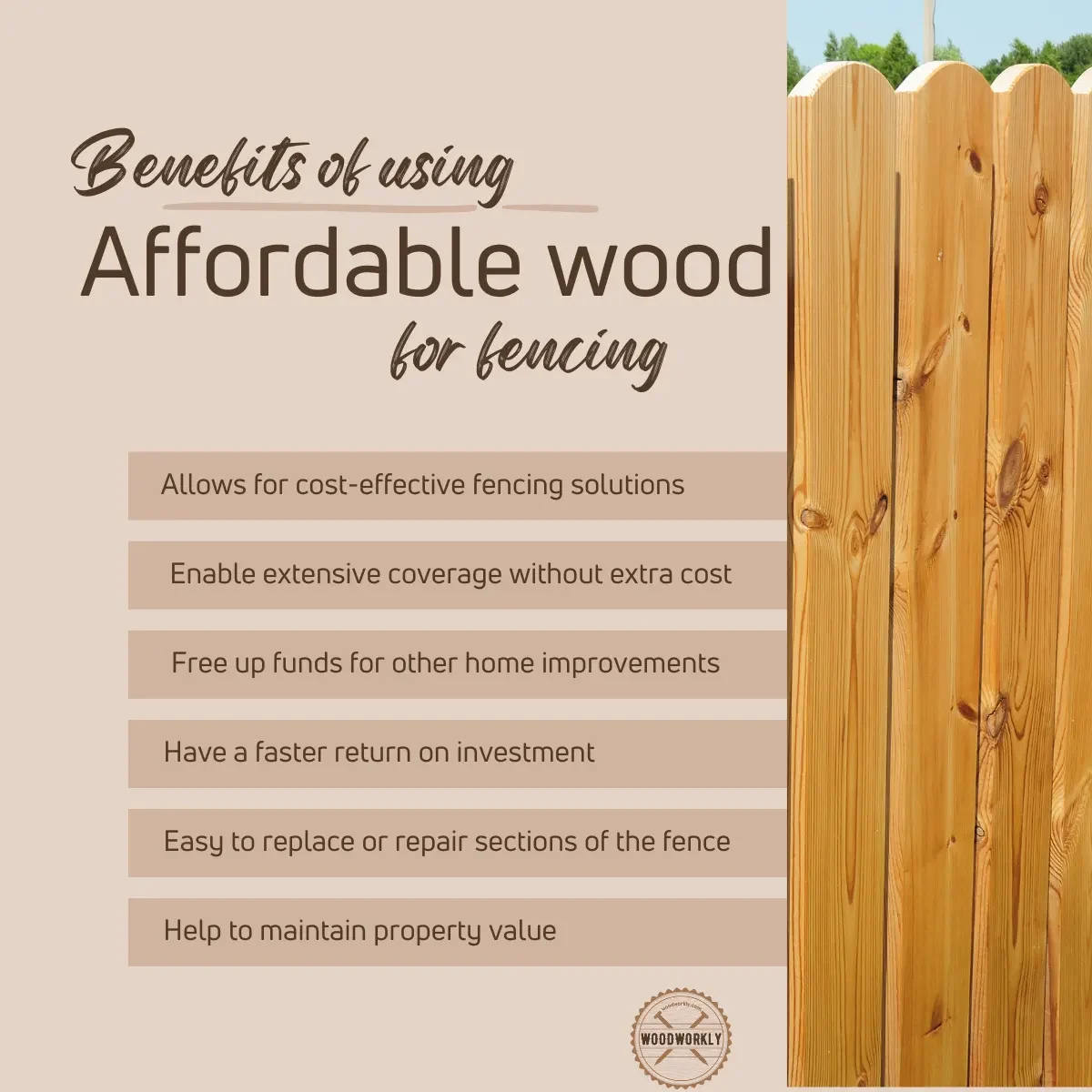
7. Local Availability Of The Wood
The availability of wood species in your region plays a big part in cost and sourcing ease for your fence.
Locally abundant woods are often cheaper and easier to get, while rare or imported types can be pricier due to transport and limited supply.
Considering what’s readily available in your area helps you pick a practical, budget-friendly wood for your fence.
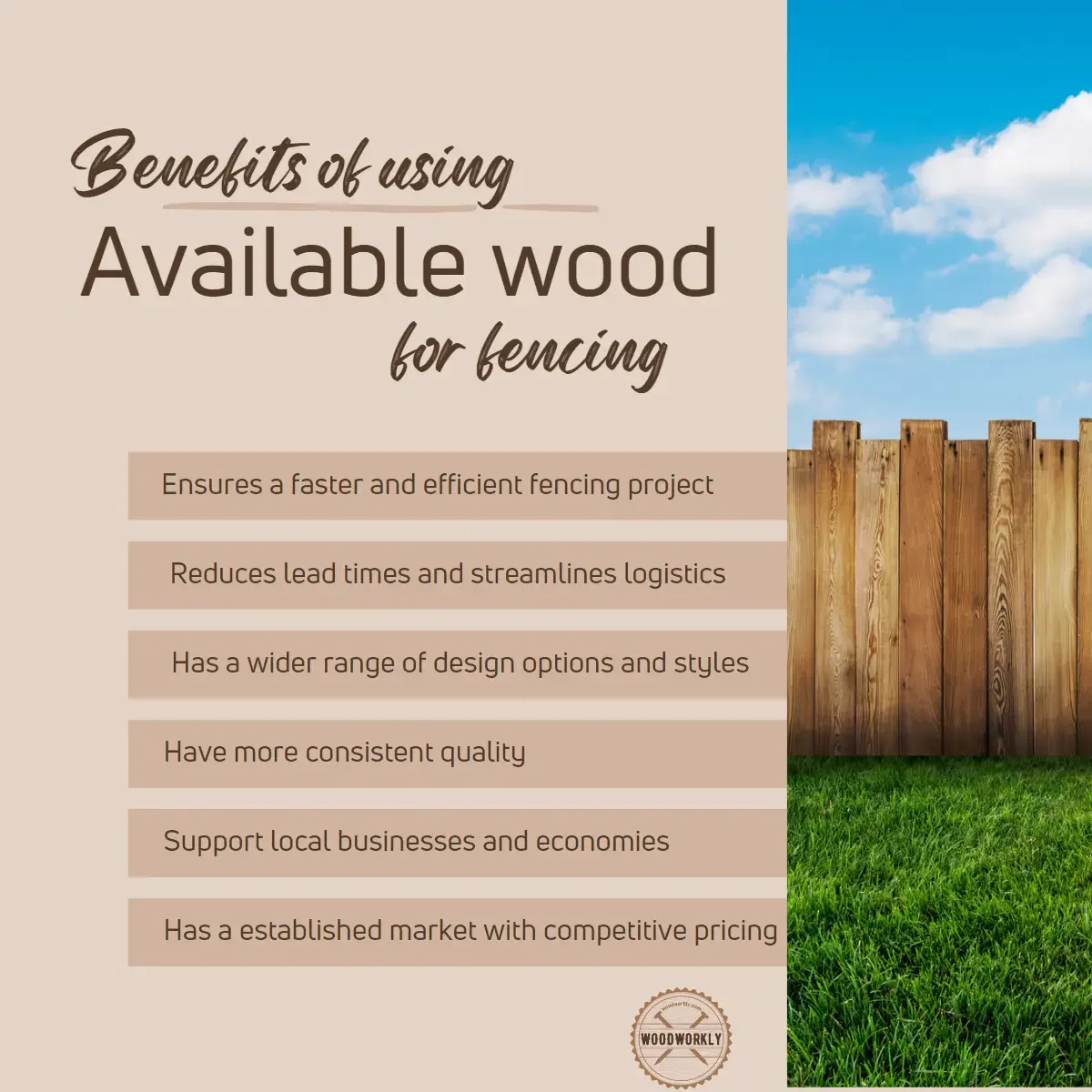
8. Sustainability Of The Wood
Choose wood that has been certified by reputable organizations, such as the Forest Stewardship Council (FSC), which ensures the wood comes from responsibly managed forests.
In addition, consider locally sourced wood, when possible, as this can reduce the environmental impact associated with transportation and support your local economy.
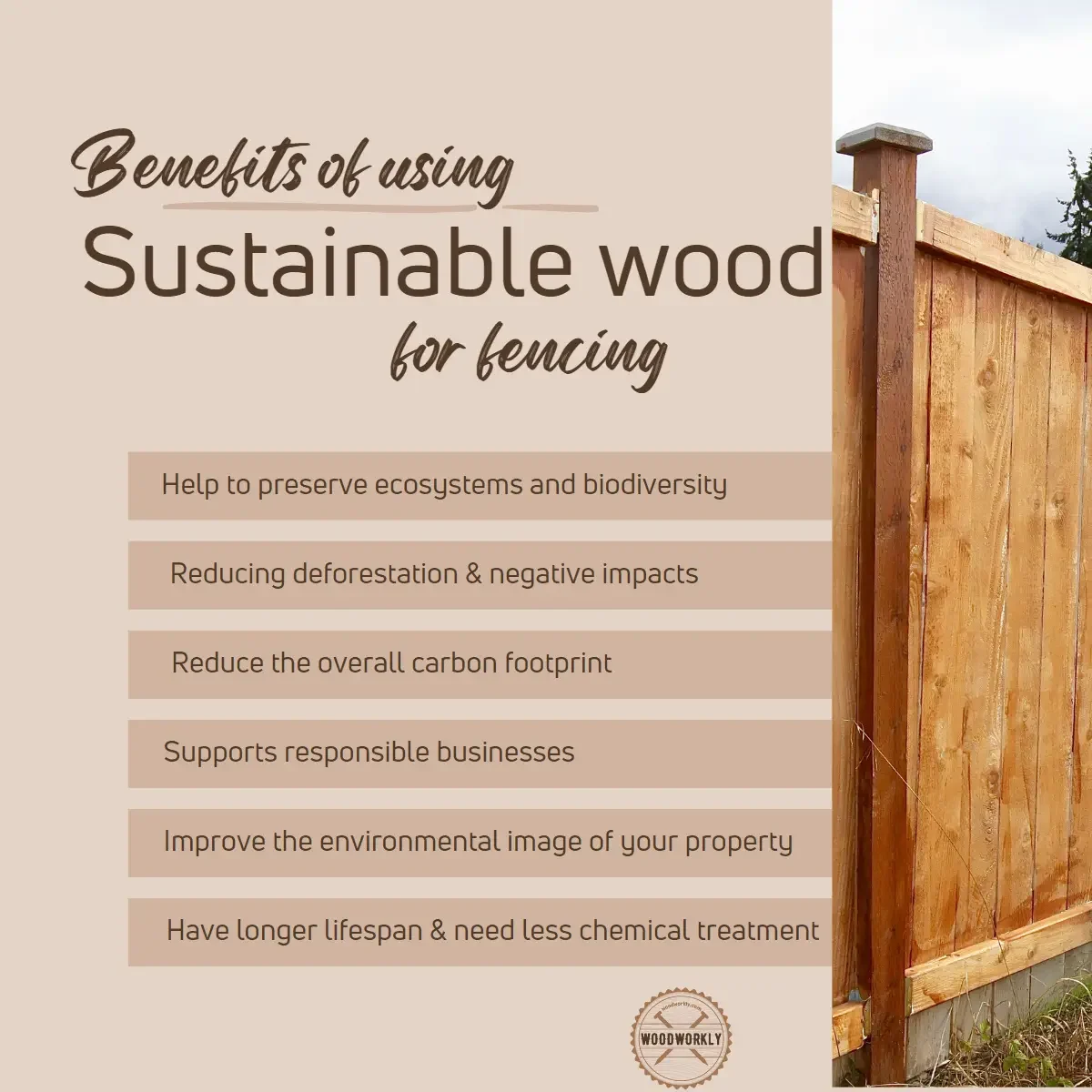
By weighing these factors and drawing upon your personal experiences, you can make an informed decision when choosing the right wood for your fencing project.
Remember, every project is unique, and the best wood choice for one person may not be the same for another.
Keep your specific needs in mind, and you’ll be well on your way to crafting a fence that stands the test of time.
So, let’s have a look at the best wood for fence with the characteristics of each wood with all the advantages and disadvantages you’ll gain.
Best Wood For Fence
Let’s discuss the best wood material for fences with their features, pros and cons.
1. Pine
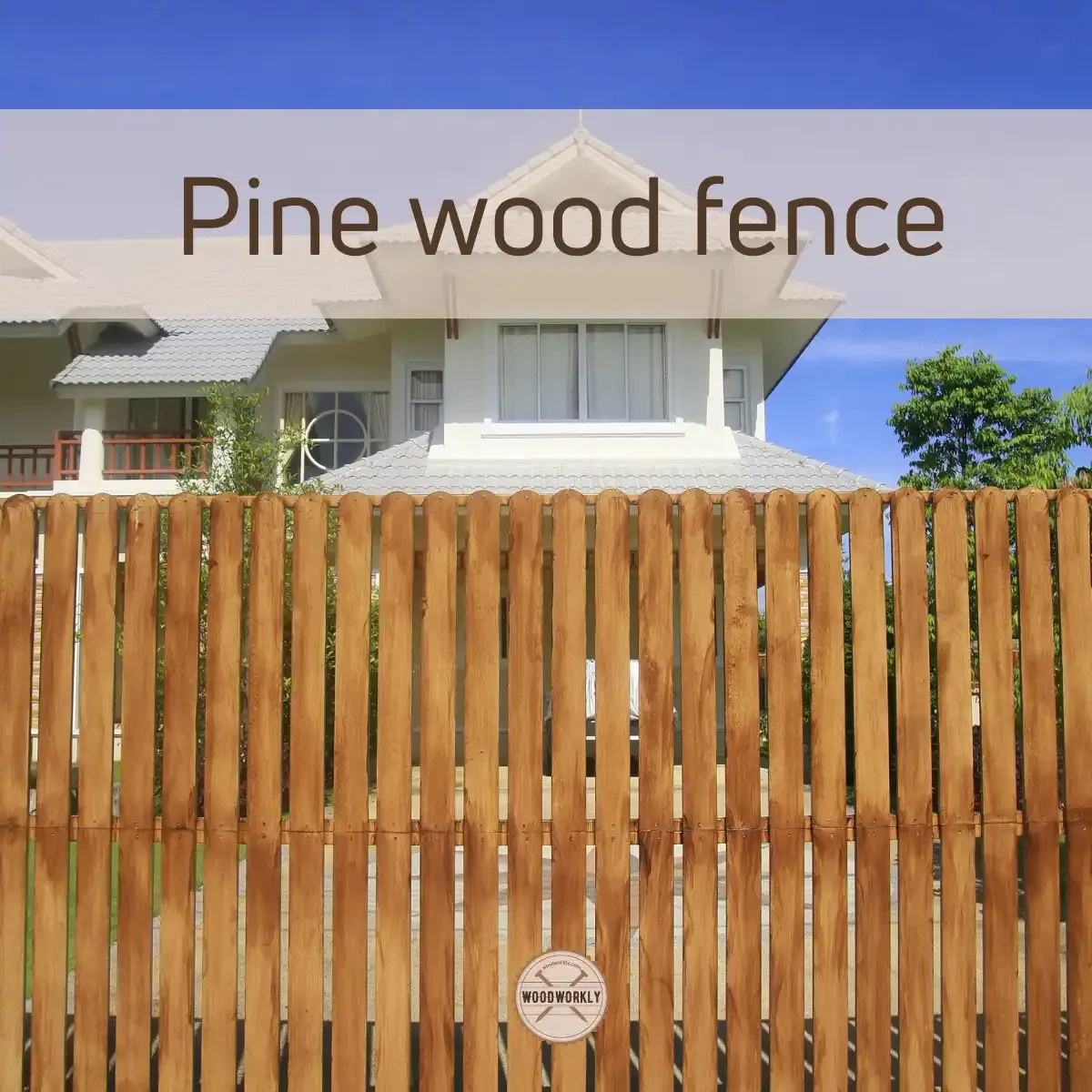
Pine, a popular fencing material, is known for its pale-yellow color, subtle grain, and affordability.
Pine is a softwood that is easy to work with, making it ideal for intricate designs and secure fastening.
Often pressure-treated, pine gains enhanced durability against decay, insects, and weathering, ensuring longevity.
Read to know Is Pine Wood Strong? Find Out the Truth!
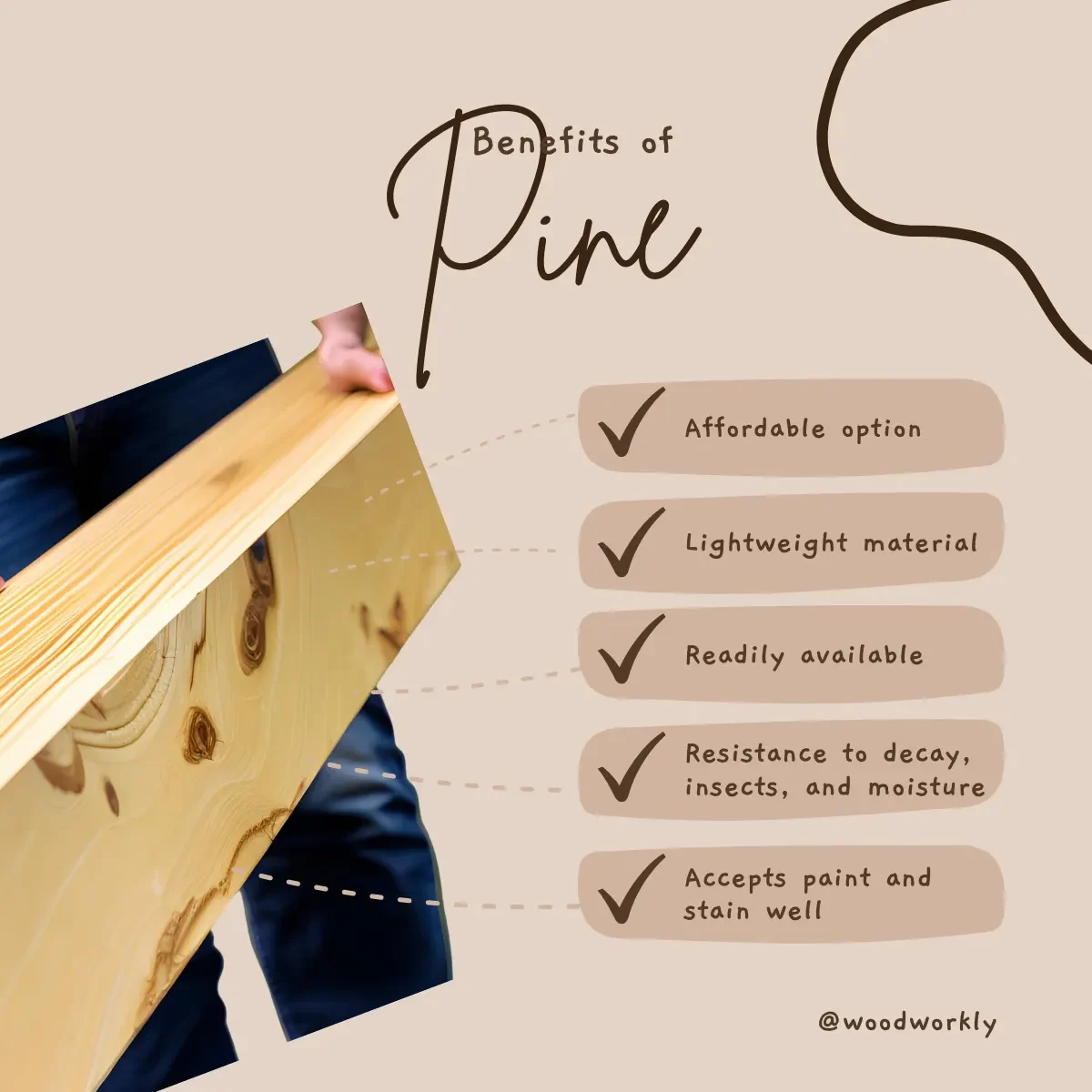
Widely available and sustainably sourced, it’s a practical choice. Pine’s adaptability in finishing allows for a variety of aesthetics, aligning with your property’s style.
While not the most durable, its cost-effectiveness, workability, and treatment make it a strong option for fencing, though it may require more maintenance and a quality sealer for longevity.
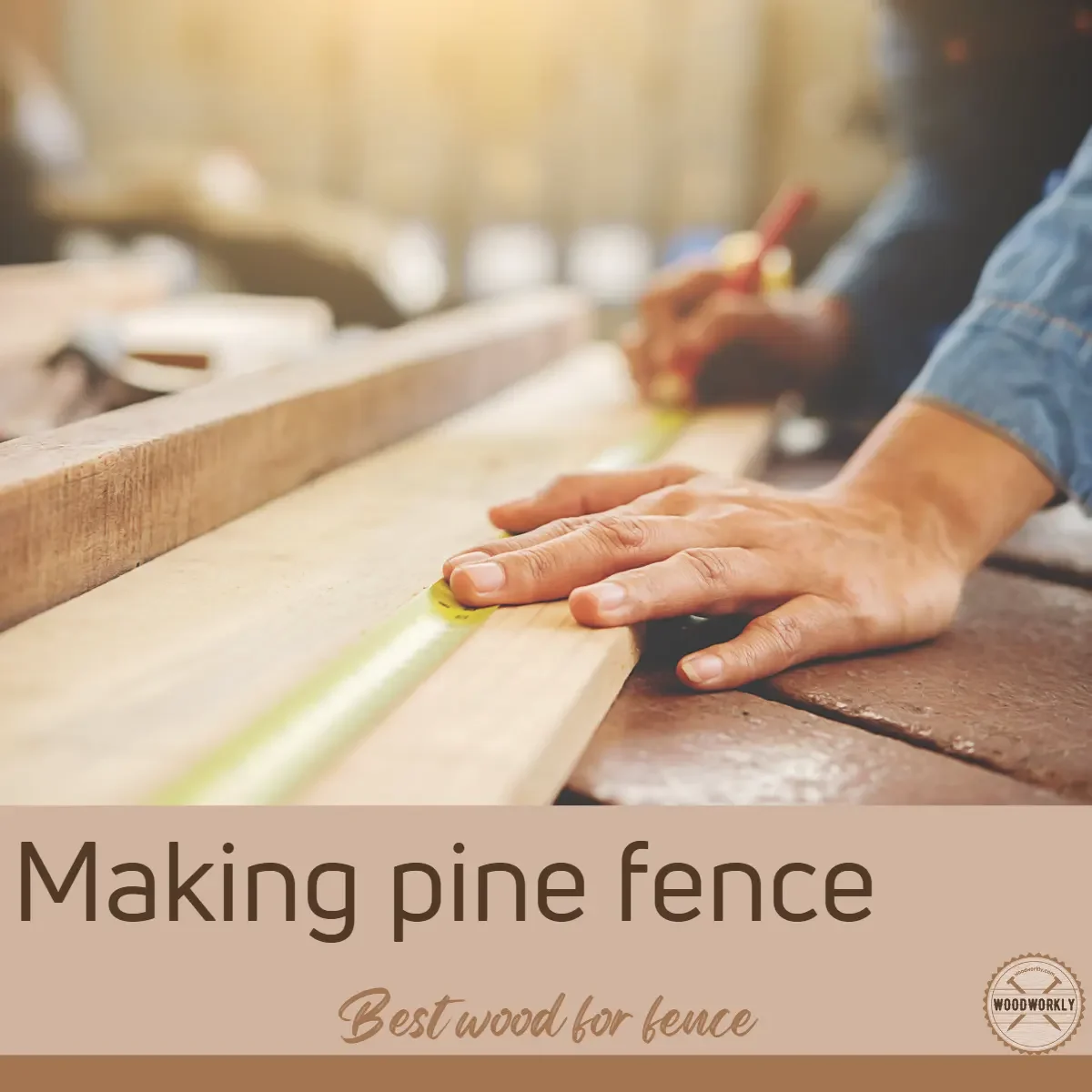
Advantages And Disadvantages Of Using Pine Wood For Fencing
| Advantages | Disadvantages |
| Cost-effective | Less durable than cedar or redwood |
| Pressure treatment: Enhanced durability | Requires more maintenance |
| Easy to work with | Prone to warping and twisting |
| Widely accessible | May not age as gracefully |
| Easy to stain or paint | Susceptible to dents and scratches |
| Shock resistant | |
| High sustainability | |
| Attractive wood with natural grain |
Check out the Main Disadvantages Of Pine Wood
2. Redwood
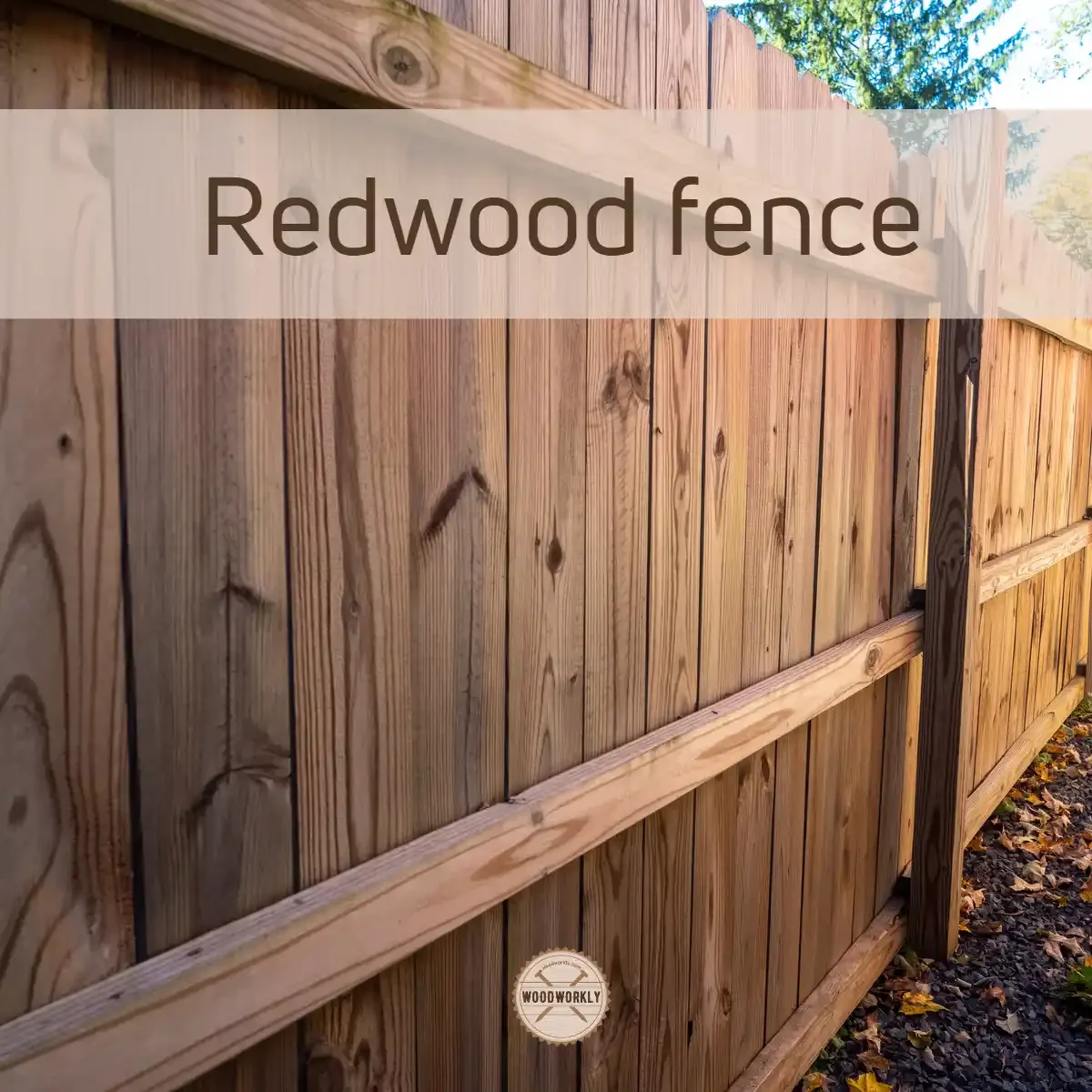
Redwood is a top choice for fencing, valued for its durability, hardness, striking appearance, and natural resistance to decay, insects, and weathering.
With a rich, dark red color and distinct grain, it enhances property aesthetics and can develop a charming silver-gray patina over time.
Redwood’s dimensional stability minimizes warping and maintains its form, making it easy to work with and ideal for secure, intricate designs.
Suited for various climates, especially damp ones, it withstands environmental changes.
While costlier upfront, its longevity and low maintenance offer long-term value.
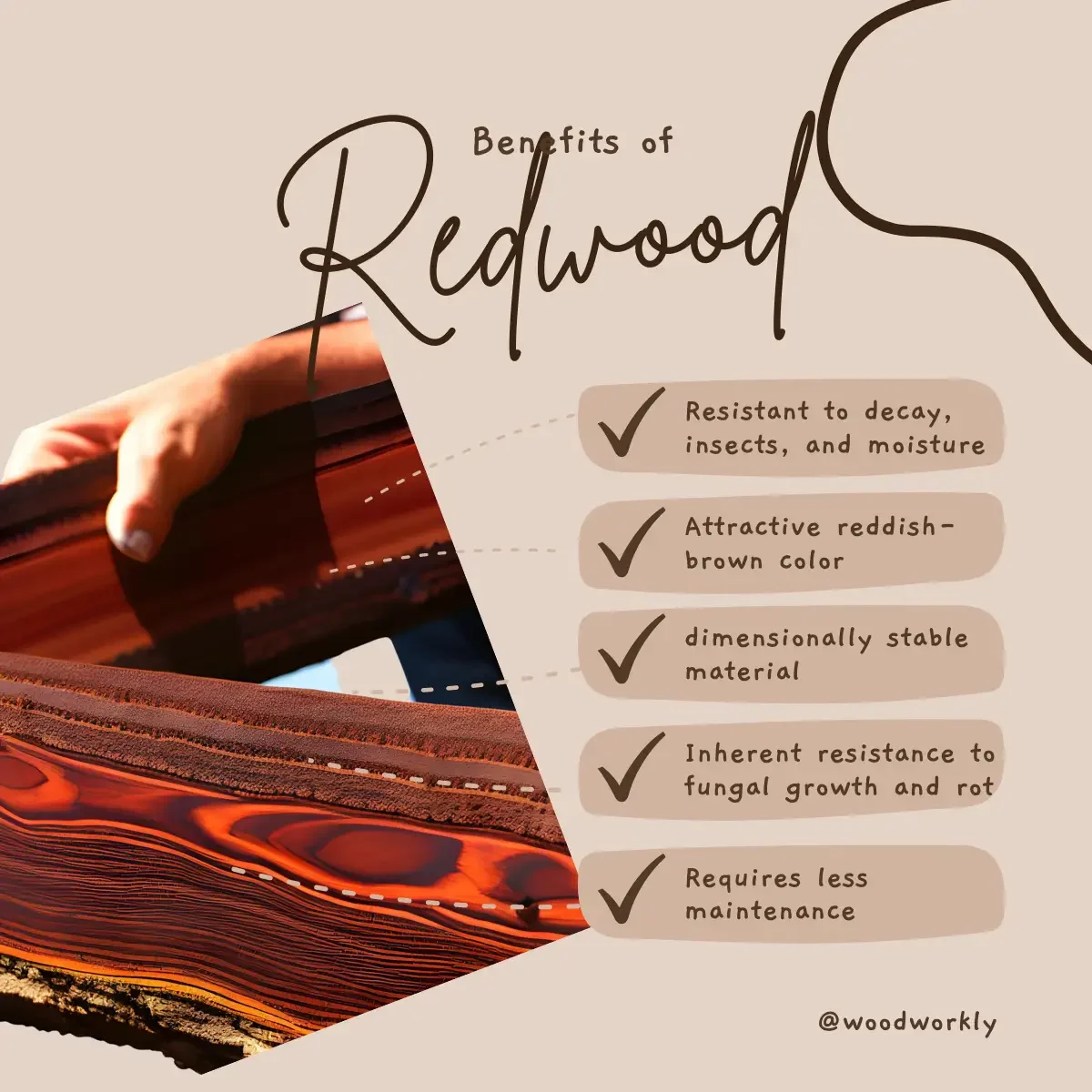
Choosing sustainably sourced redwood supports responsible forestry.
Finishing with a quality sealer is recommended to maximize its lifespan and maintain its fresh appearance.
Advantages And Disadvantages Of Using Redwood For Fencing
| Advantages | Disadvantages |
| High durability | Expensive |
| Attractive wood | Limited availability |
| High dimensional stability (resistant to warping and twisting) | Can damage from harsh chemicals |
| High workability | |
| Climate adaptability | |
| Easy to stain and paint | |
| Insect and rot resistant | |
| Easy to clean and maintain | |
| Sustainability |
3. Spruce
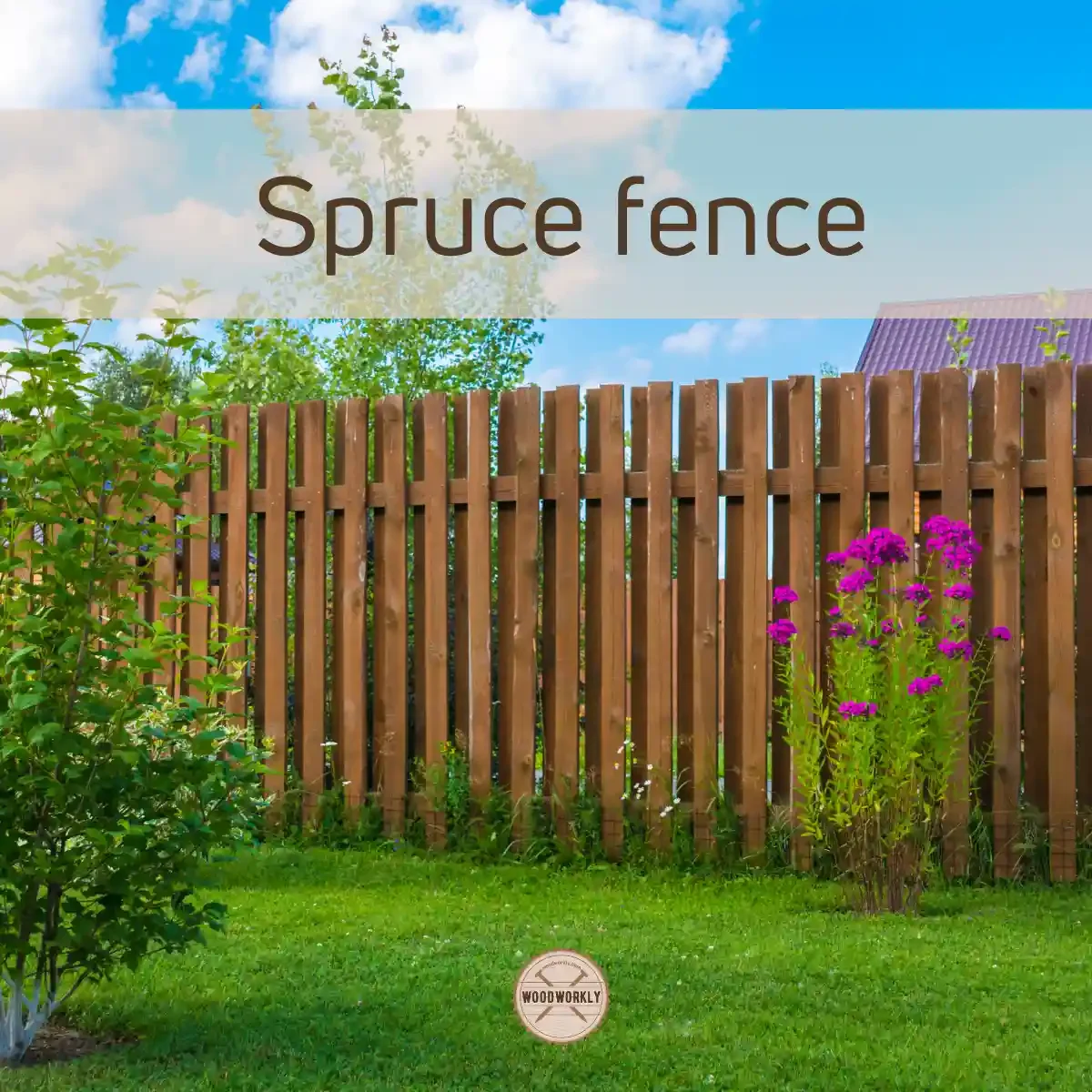
Spruce, known for its affordability, is a great choice for budget-conscious homeowners looking to build a fence.
As a softwood, it’s highly workable, making it suitable for both professional and DIY projects, and its lightweight nature facilitates easy handling and installation.
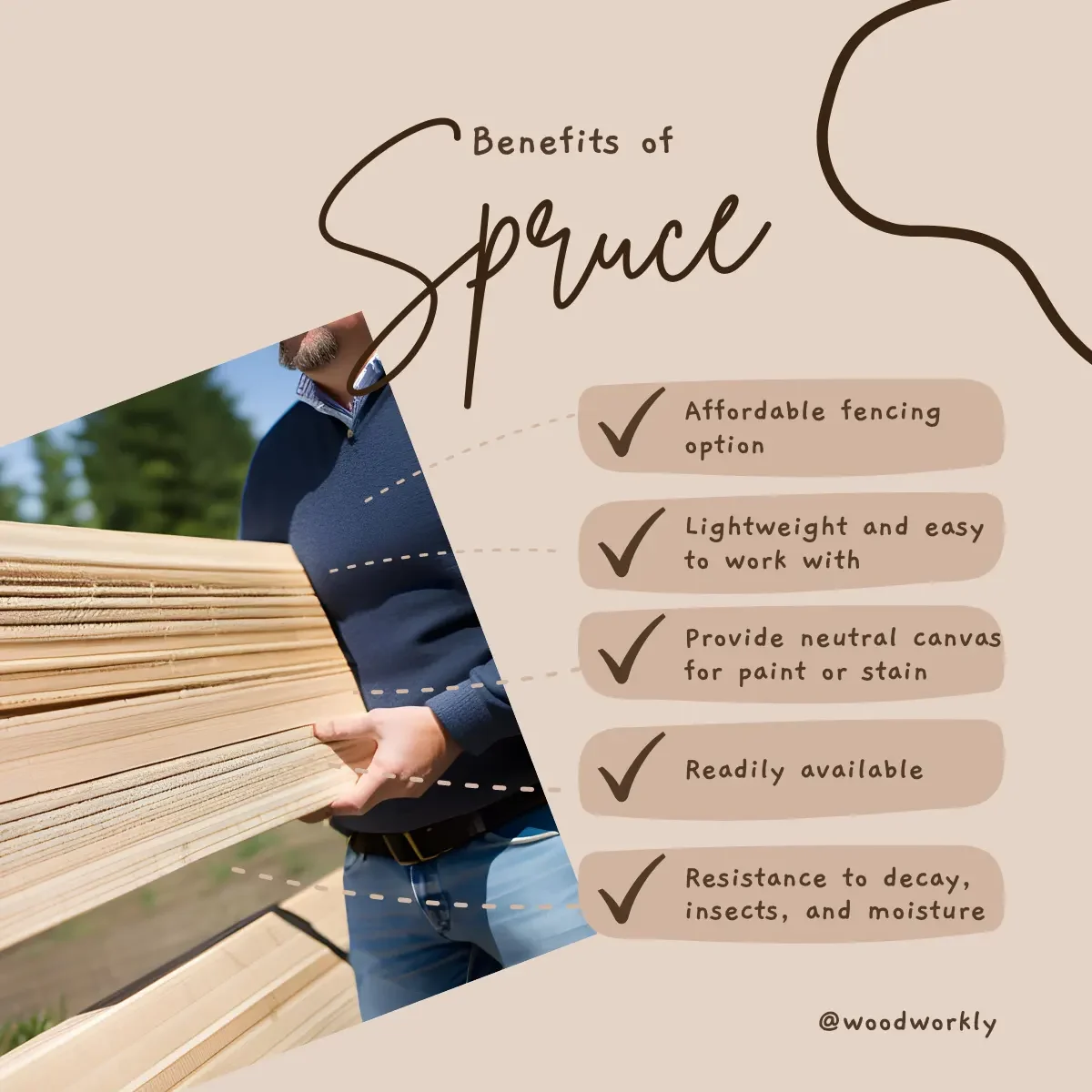
Spruce’s fast growth ensures sustainable sourcing, and its light color with a fine texture offers a clean, appealing look.
While it may lack the natural decay resistance of woods like cedar or redwood, with proper maintenance, treatments, and sealing, spruce fences can withstand harsh weather and remain durable, making it a cost-effective and attractive fencing material.
Check out Is Spruce Good For Outdoor Use? Here’s The Truth!
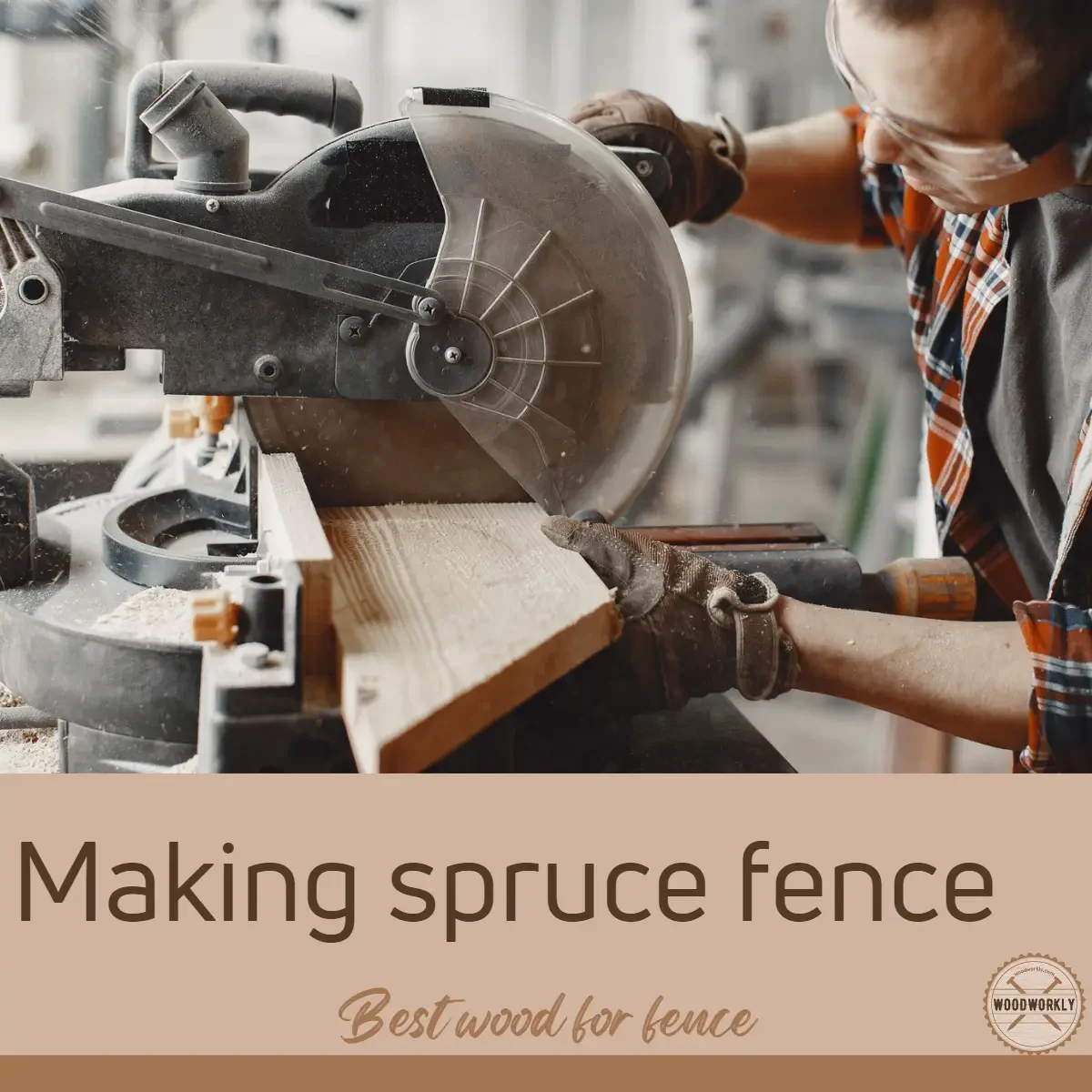
Advantages And Disadvantages Of Using Spruce For Fencing
| Advantages | Disadvantages |
| Affordable wood | More maintenance |
| Easy to work with | Less decay-resistant |
| Lightweight | Prone to warping |
| Sustainable wood | Need staining and finishing |
| Clean look | |
| Attractive wood |
4. Cedar
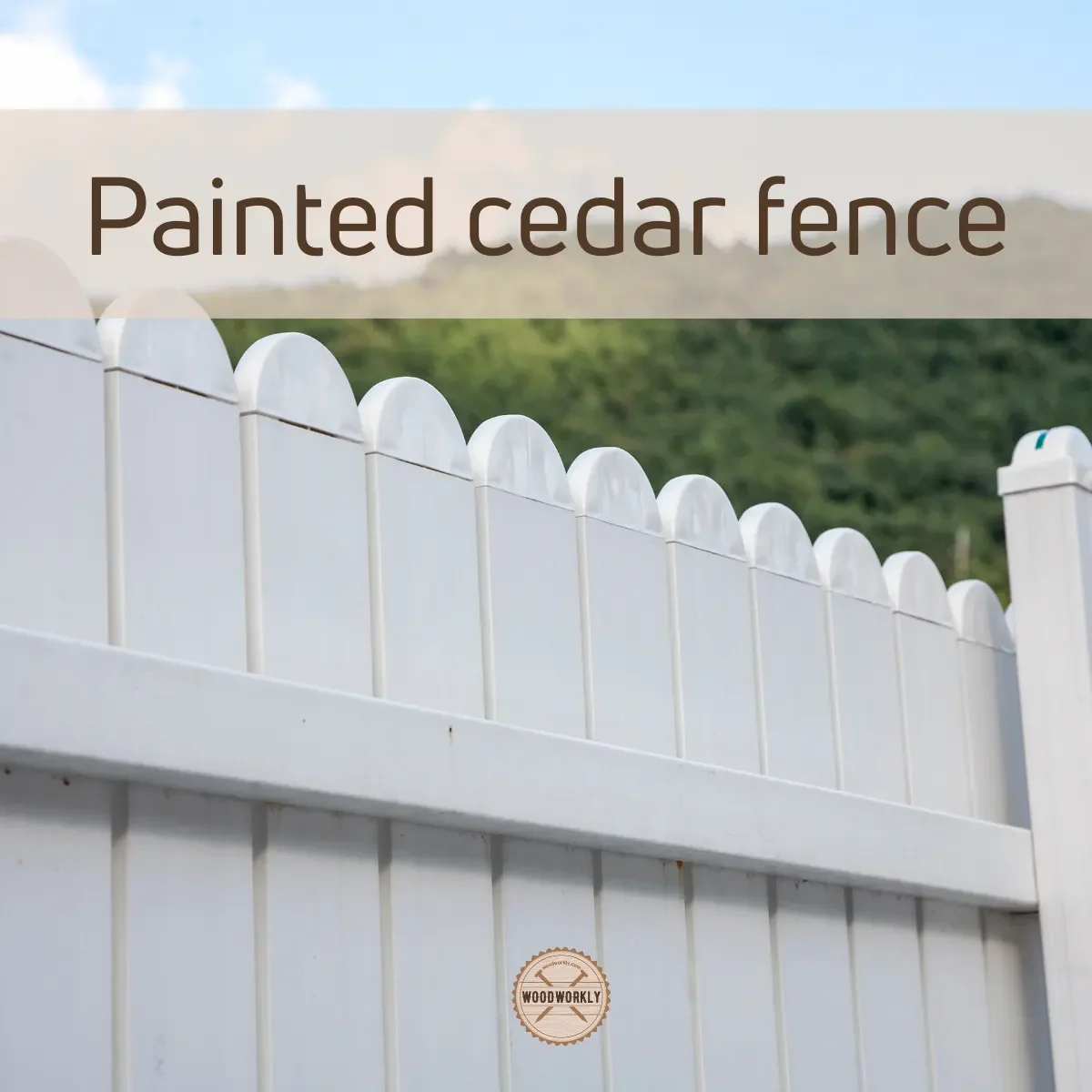
Cedar, a strong softwood known for its reddish-brown color and straight grain, is a top choice for fencing due to its natural durability and aesthetic appeal.
Renowned for its resistance to decay, rot, and insect infestations, cedar withstands extreme weather and temperatures, making it ideal for outdoor use without needing harsh chemical treatments.
Its natural oils provide a pleasant aroma and pest deterrence. Plus, cedar has the ability to repel bugs. Stable with minimal warping, cedar maintains its structural integrity over time.
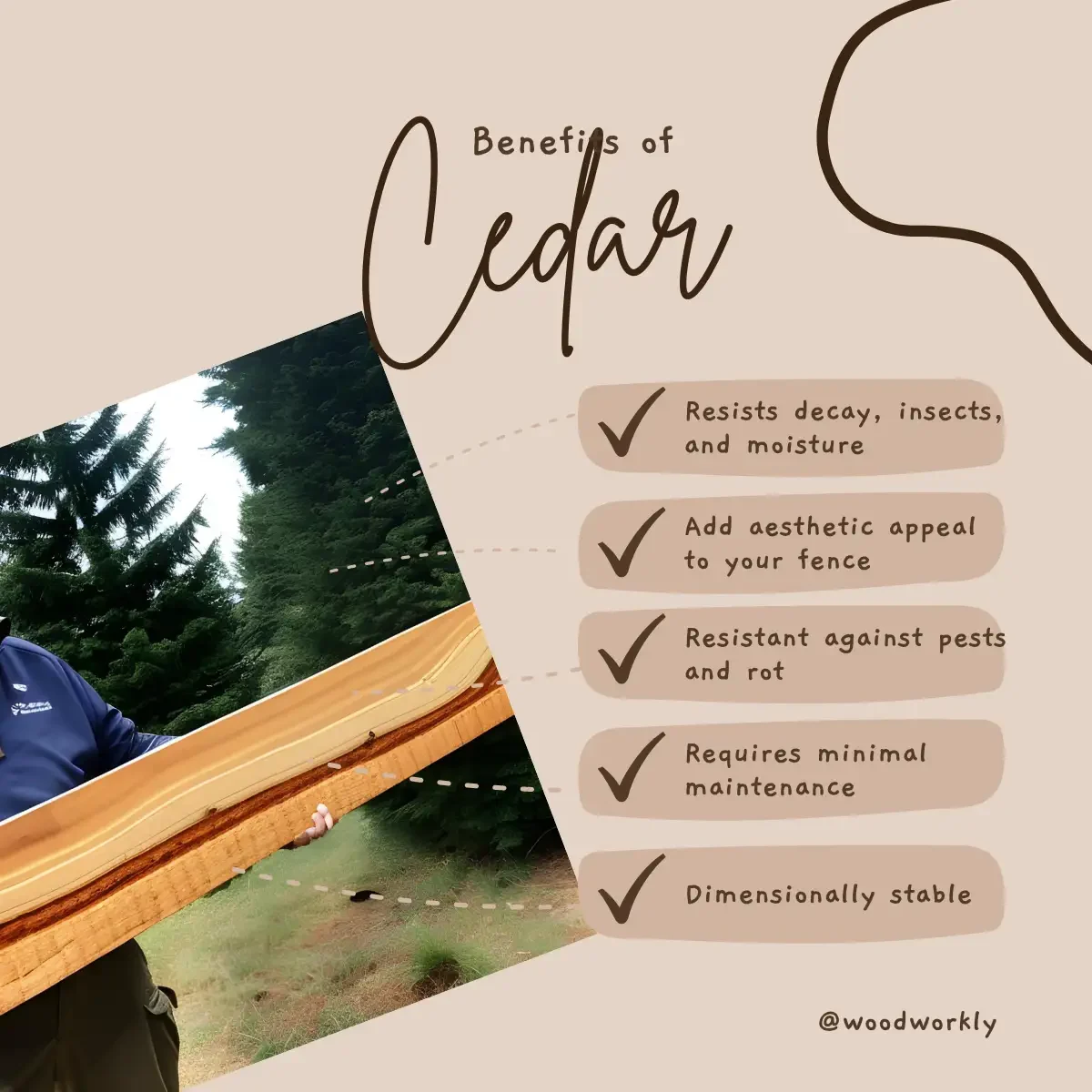
Easy to work with, it’s suitable for both professionals and DIY enthusiasts.
Aesthetically, cedar’s rich color and grain add a timeless beauty to fences, and it can be left natural or finished as desired.
Its insulating properties also help reduce noise, combining practicality and visual appeal to make it an excellent fencing material.
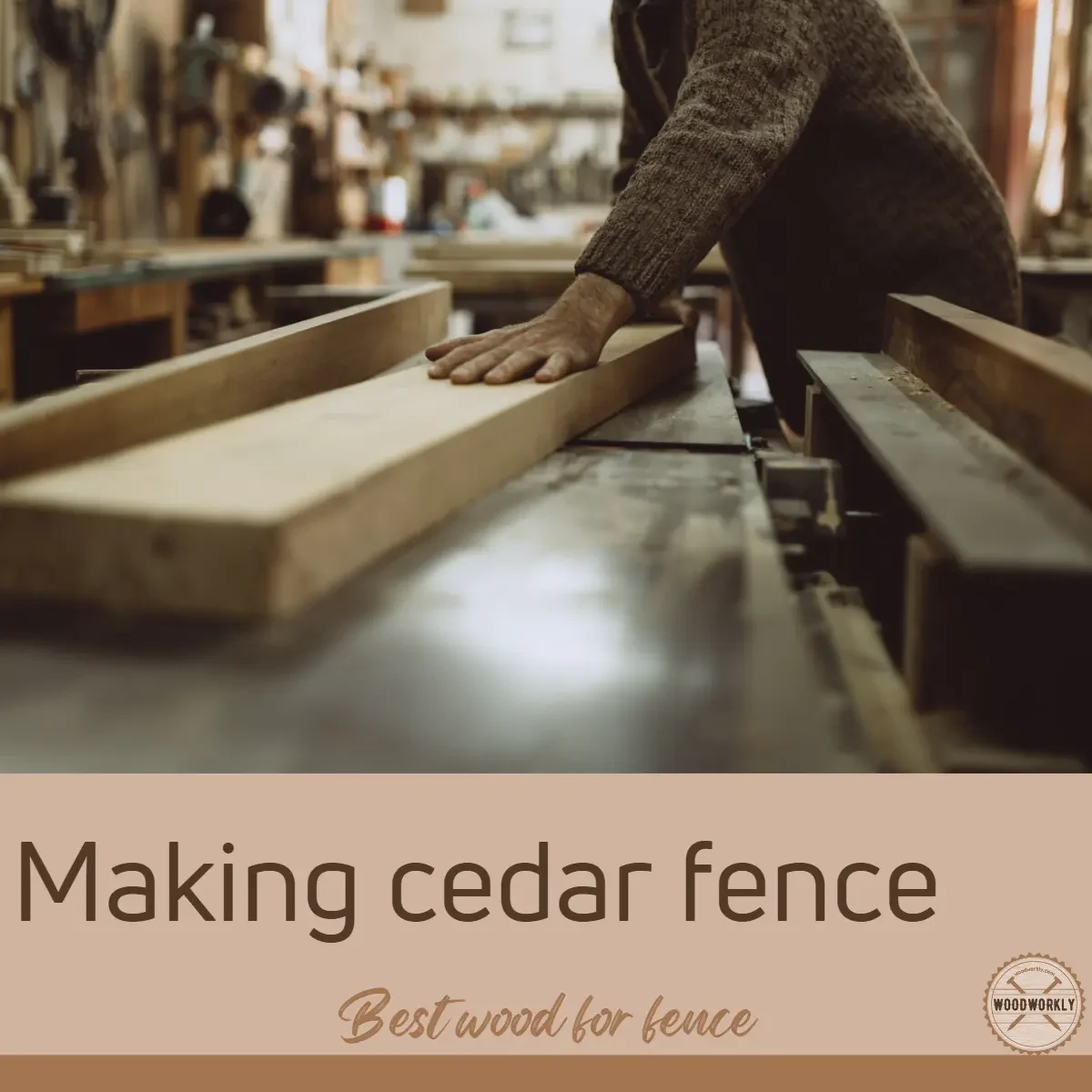
Advantages And Disadvantages Of Using Cedar For Fencing
| Advantages | Disadvantages |
| Natural resistance | Slightly expensive |
| High durability | Need more maintenance |
| Repels bugs, pests, and insects | |
| High dimensional stability | |
| High workability | |
| Aesthetic appeal | |
| Insulating properties |
5. Sweetgum
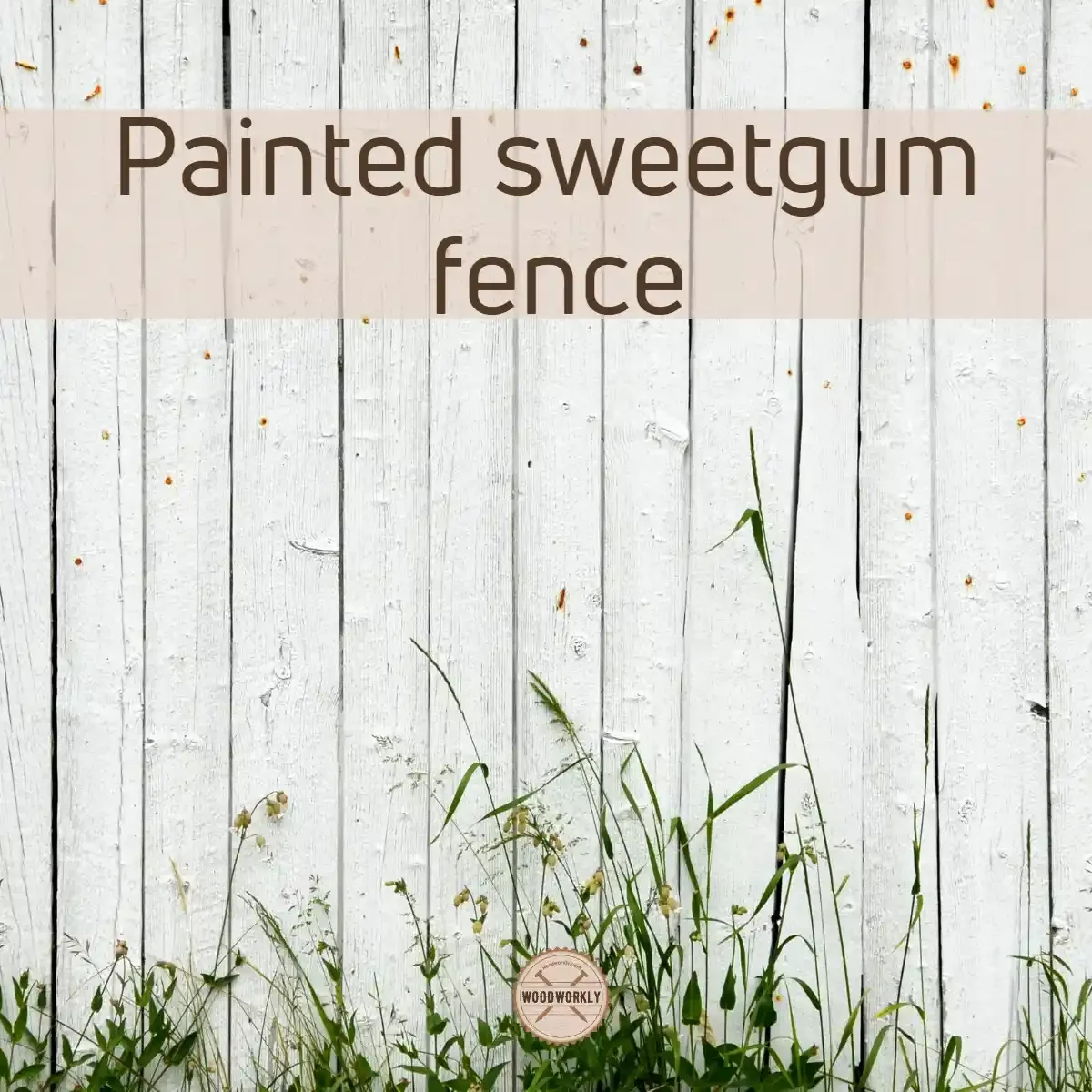
Sweetgum, a less common but intriguing choice for fencing, offers several beneficial characteristics.
Its hardwood strength, with a Janka rating of 850 lbf, ensures durability and longevity, able to withstand harsh weather conditions.
Sweetgum stands out with its unique reddish-brown color and interlocked grain pattern, enhancing the visual appeal of your property.
While it requires pre-drilling for fasteners due to its hardness, it remains workable for cutting, shaping, and sanding.
This wood adapts well to various stains and finishes, allowing customization to match your property’s style.
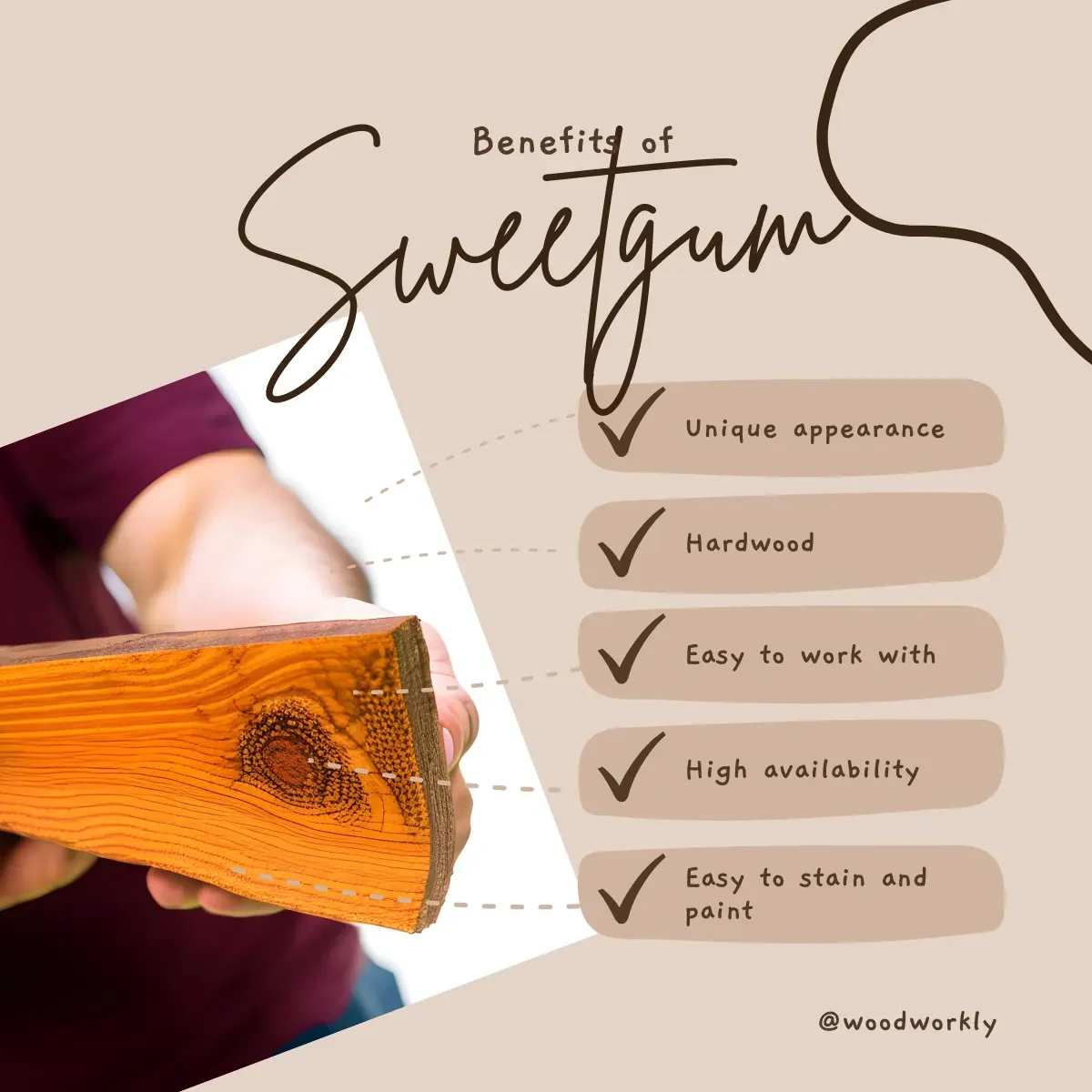
Although not as widespread as other species, sweetgum is accessible in the southeastern U.S., and sourcing it from sustainably managed forests supports responsible forestry.
To maximize its outdoor durability, it’s recommended to seal sweetgum for protection against moisture and UV light, though it may need more maintenance than naturally resistant woods.
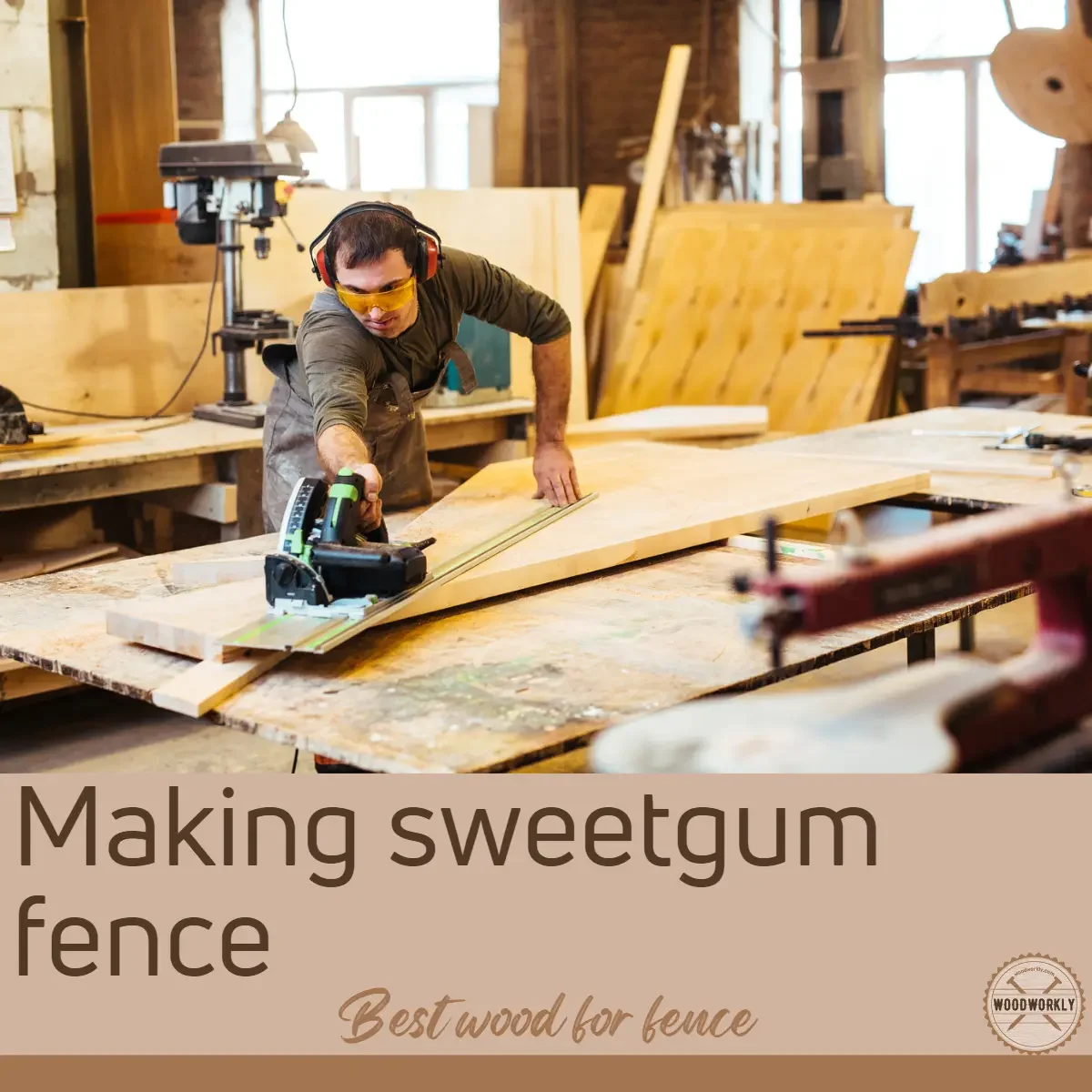
Advantages And Disadvantages Of Using Sweetgum For Fencing
| Advantages | Disadvantages |
| Distinct appearance | Lesser-known wood species |
| Hardwood strength | Less natural decay resistance |
| Easy to work with | Need more maintenance |
| Easy to stain and finish | Limited availability |
| Regional availability | |
| Sustainable practices | |
| High durability |
6. Cypress
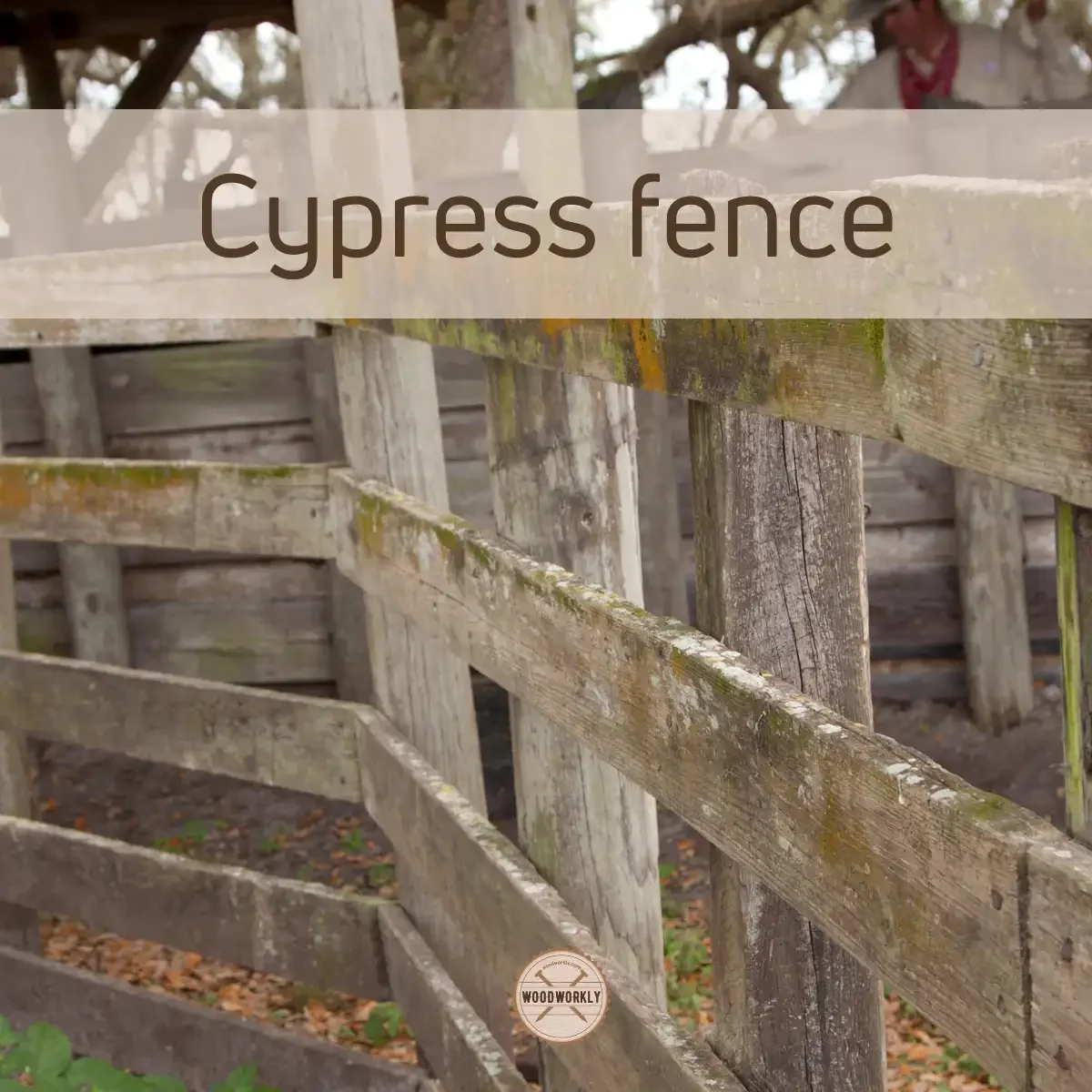
Cypress, a popular softwood known for its yellowish to reddish-brown hue and straight grain, is a top choice for fencing due to its natural durability and aesthetic appeal.
With a Janka hardness rating higher than many softwoods, cypress resists decay, rot, and insect infestations, including natural compounds that repel bugs.
Its stability minimizes warping, twisting, or shrinking, contributing to the longevity of the fence.
Cypress is easy to work with, favored by both professionals and DIY enthusiasts. Its rich color and grain pattern enhance the visual appeal of fences, and it can be stained or painted to suit personal preferences.
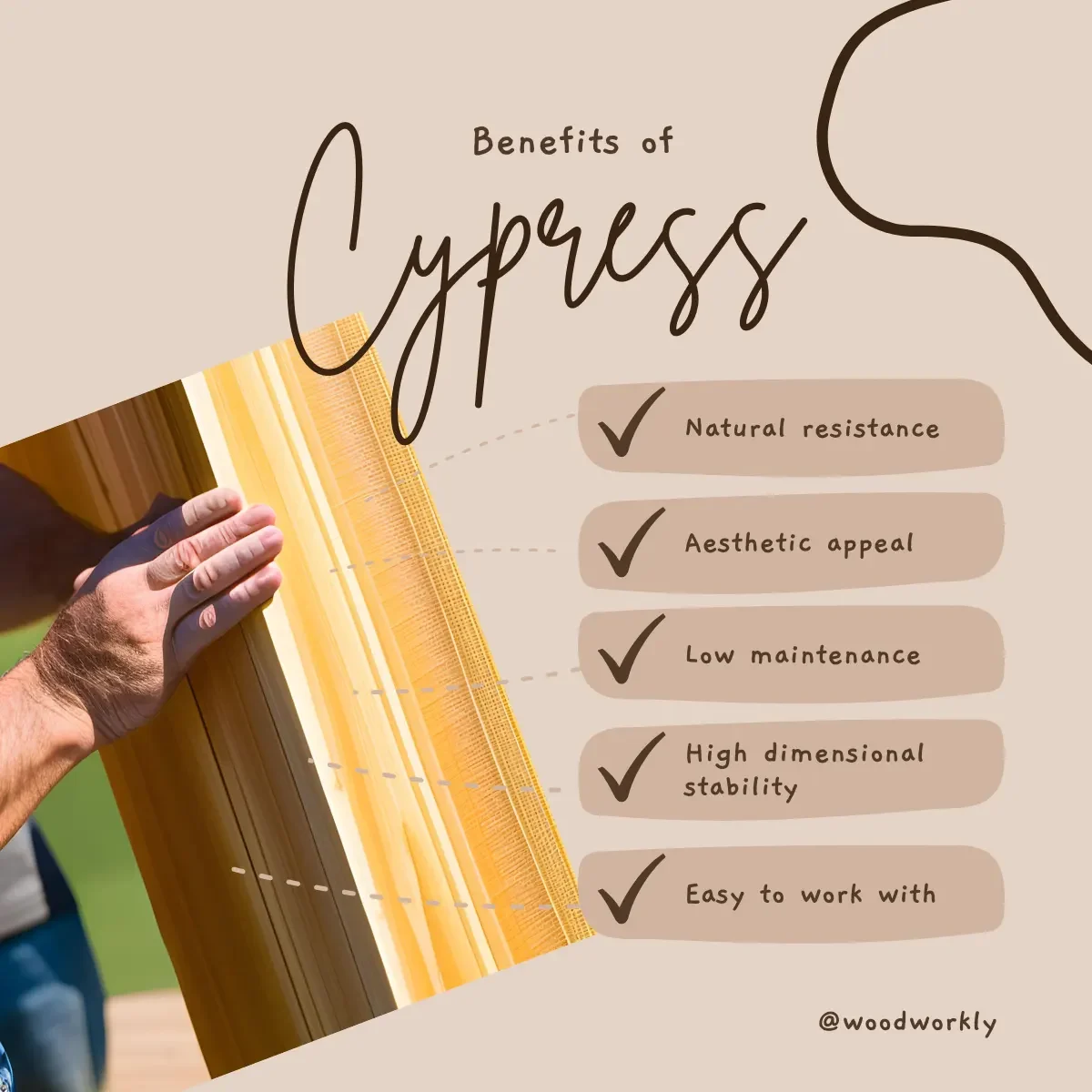
As a relatively fast-growing tree, cypress is a sustainable option, especially when sourced from responsibly managed forests.
To maximize its outdoor performance, finishing with a quality sealer is recommended.
With proper care, cypress fences can last up to 30 years, offering both beauty and enduring quality.
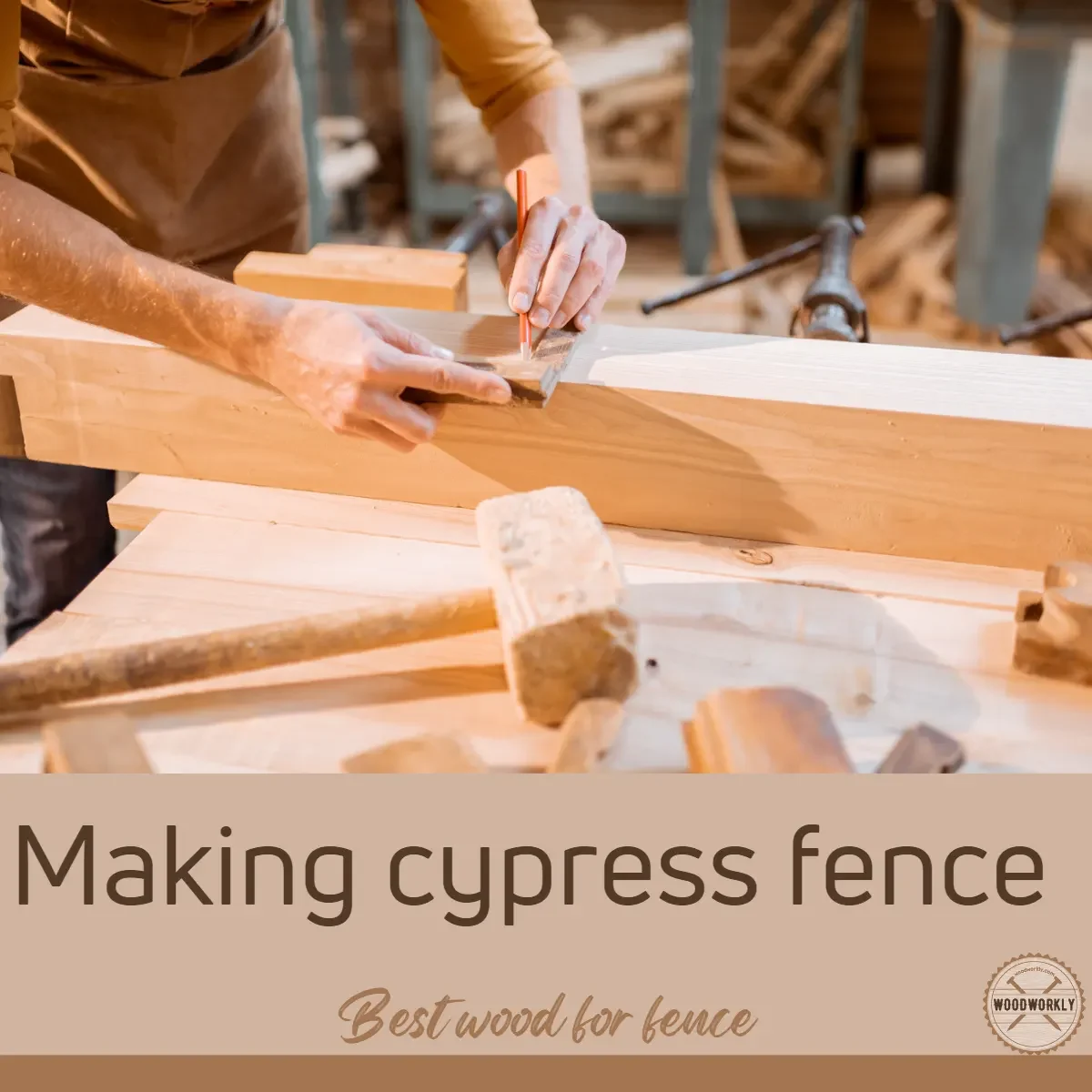
Let’s see some advantages and disadvantages you’ll get by using a cypress to make a fence.
Advantages And Disadvantages Of Using Cypress For Fencing
| Advantages | Disadvantages |
| Rot resistance | Limited availability in some regions |
| High stability | Can be more expensive than other options |
| High workability | |
| Aesthetic appeal | |
| Sustainability | |
| High durability | |
| Resistant to insects and pests | |
| Attractive wood |
7. Black Locust
Black locust, a strong hardwood native to North America, is an excellent choice for fencing due to its durability, strength, and unique aesthetic.
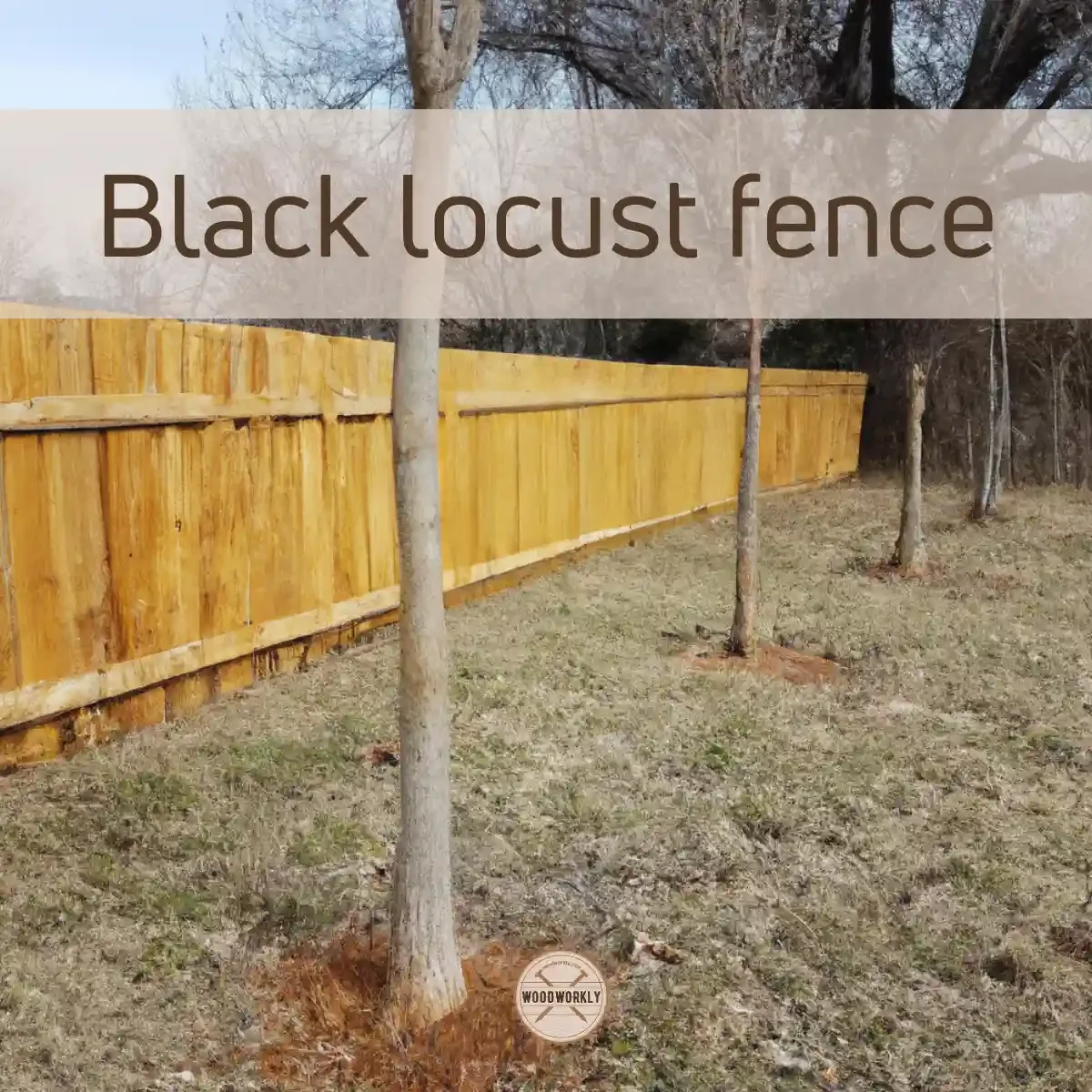
Known for its yellowish-brown color that deepens over time and irregular grain patterns, it offers a distinct look.
Its extreme hardness makes it resistant to decay, rot, and insect damage, ensuring it can withstand harsh weather conditions like rain and snow.
This natural resilience means black locust fences are long-lasting without needing chemical treatments.
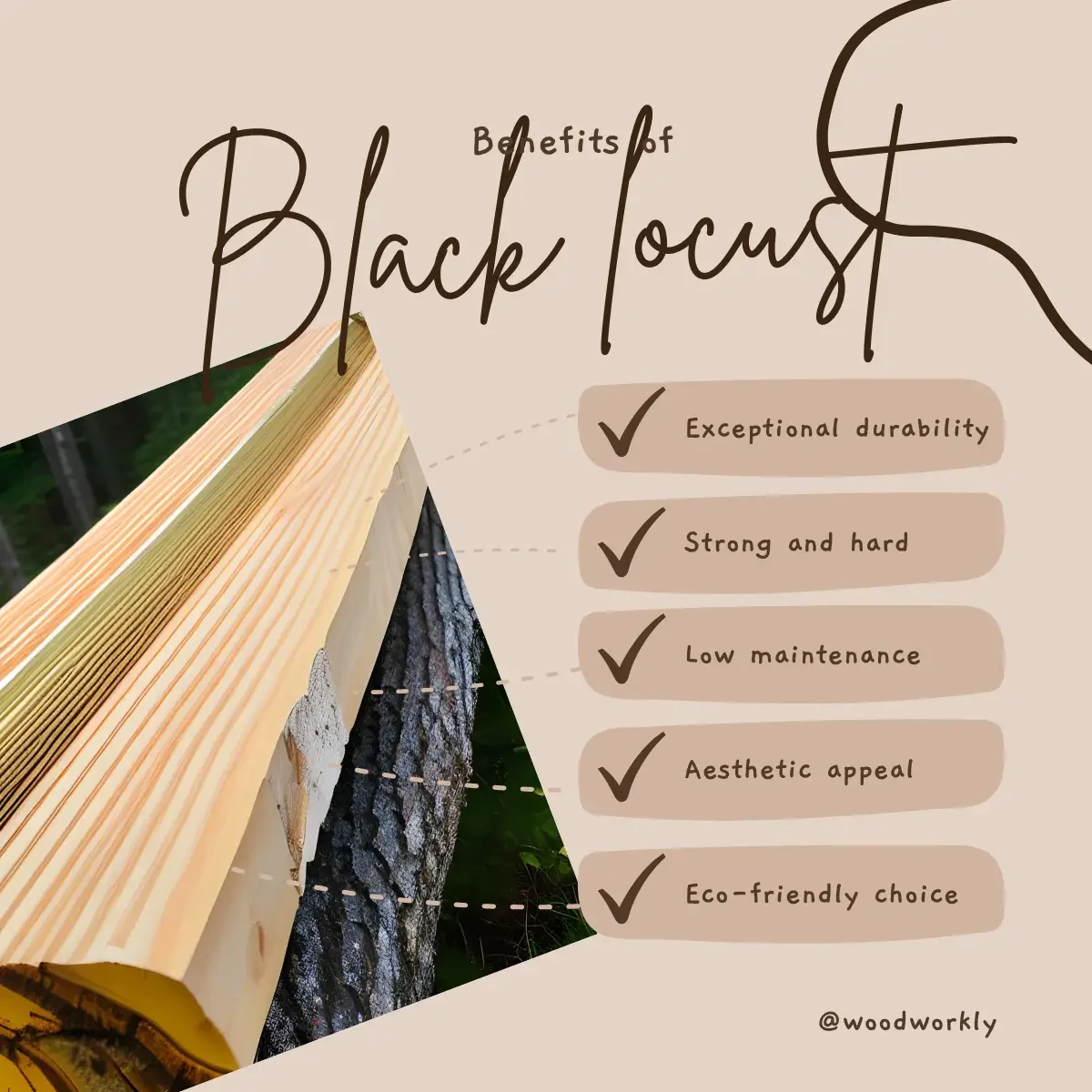
Its strength supports heavy loads, and its resistance to weathering minimizes warping or cracking.
As it ages, it develops a beautiful patina, enhancing its charm.
When sourced from responsibly managed forests, black locust is also a sustainable option, making it a practical, visually appealing, and eco-friendly choice for fencing.
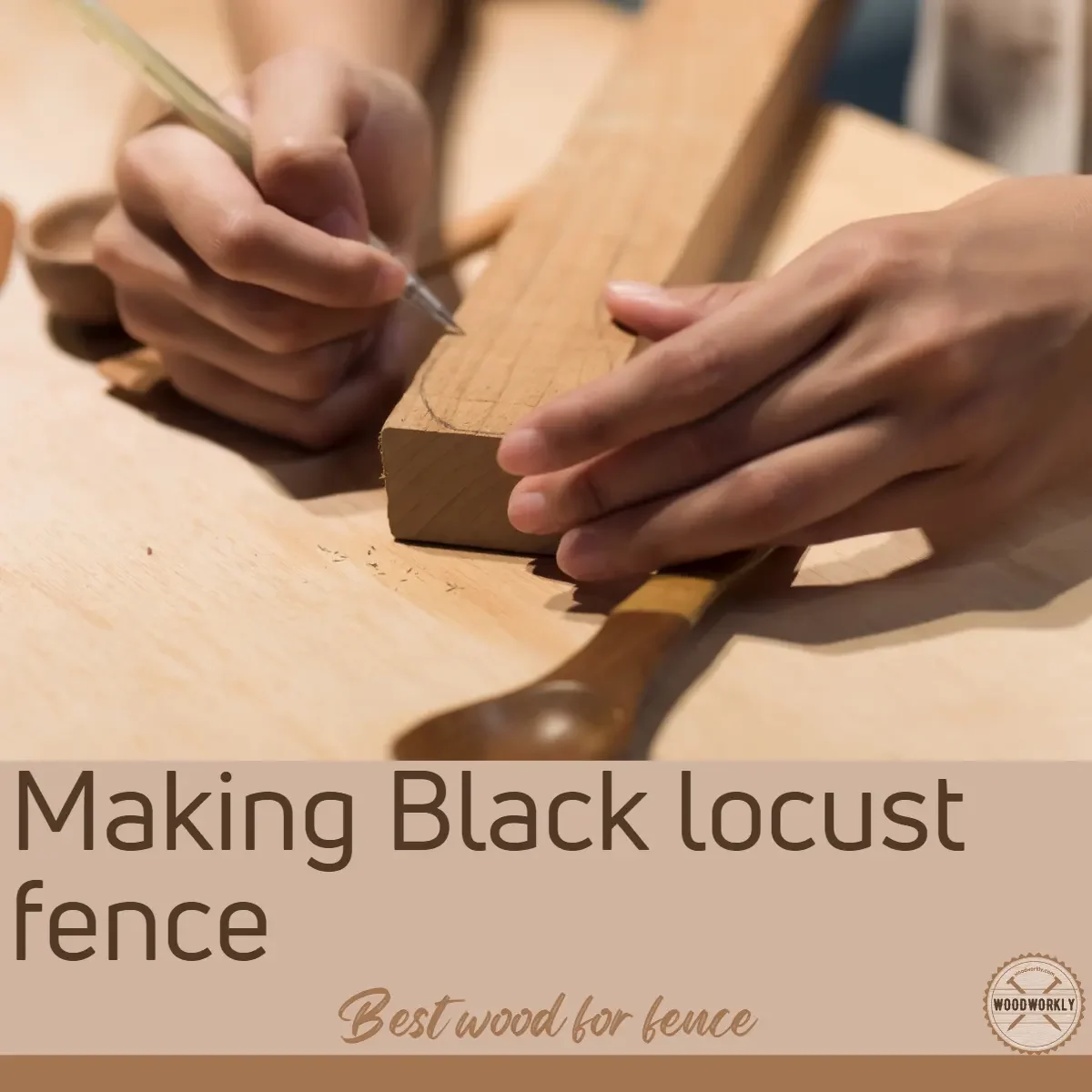
Advantages And Disadvantages Of Using Black Locust For Fencing
| Advantages | Disadvantages |
| Exceptional durability | Higher cost compared to other wood types |
| Incredible strength | Limited availability in some regions |
| Weather resistance | Can be more difficult to work with |
| Aesthetic appeal | |
| Sustainable when sourced responsibly | |
| Rot-resistant | |
| Insect and pest resistant |
8. Osage Orange
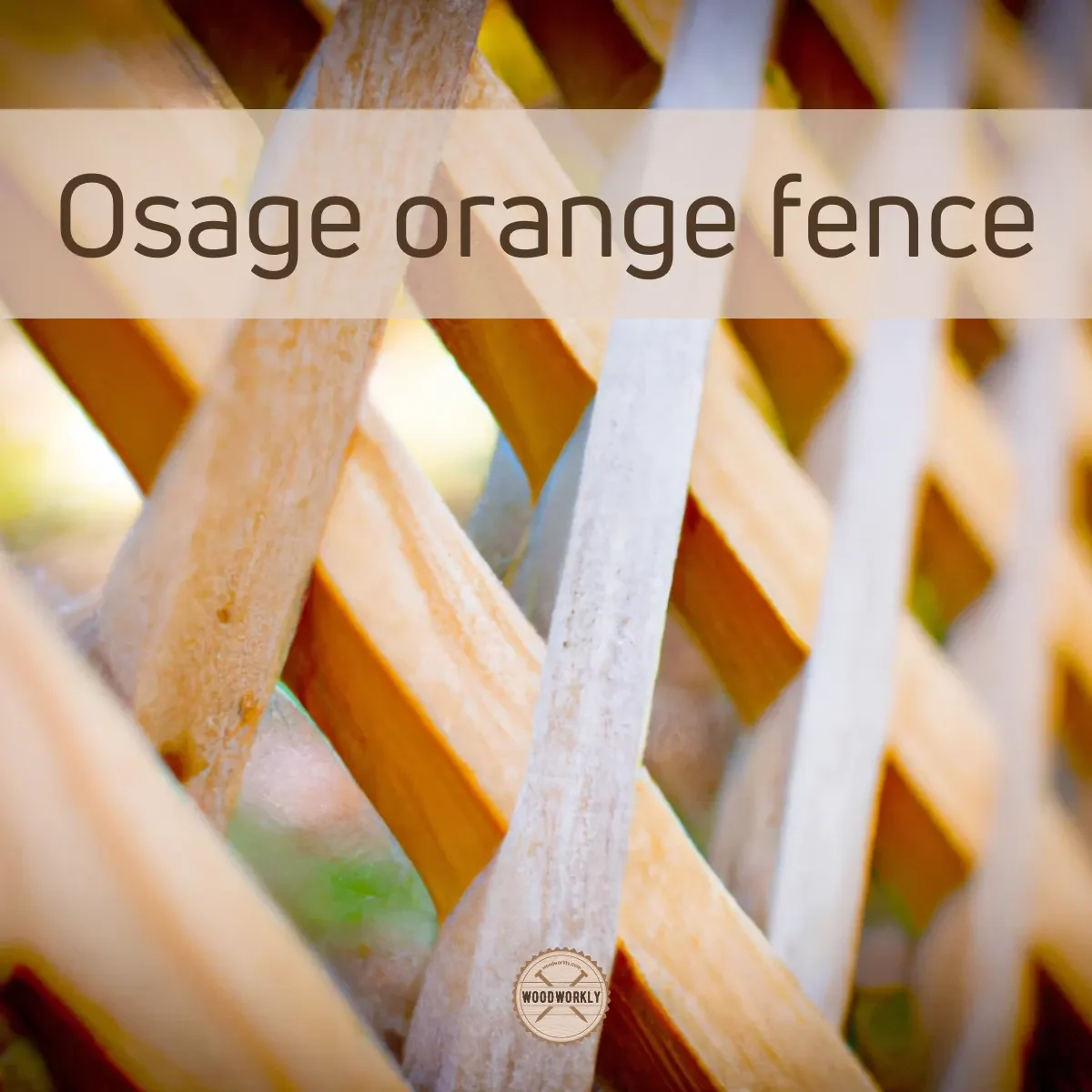
Osage orange, a North American hardwood, is valued for fencing due to its vibrant golden-yellow color, which deepens over time, and its unique, irregular grain patterns.
This wood’s exceptional durability, including resistance to rot, decay, and insects, ensures fences can last decades with minimal maintenance.
Its dense, strong nature makes it resilient to heavy loads and impacts, while its natural weather resistance allows it to withstand diverse conditions.
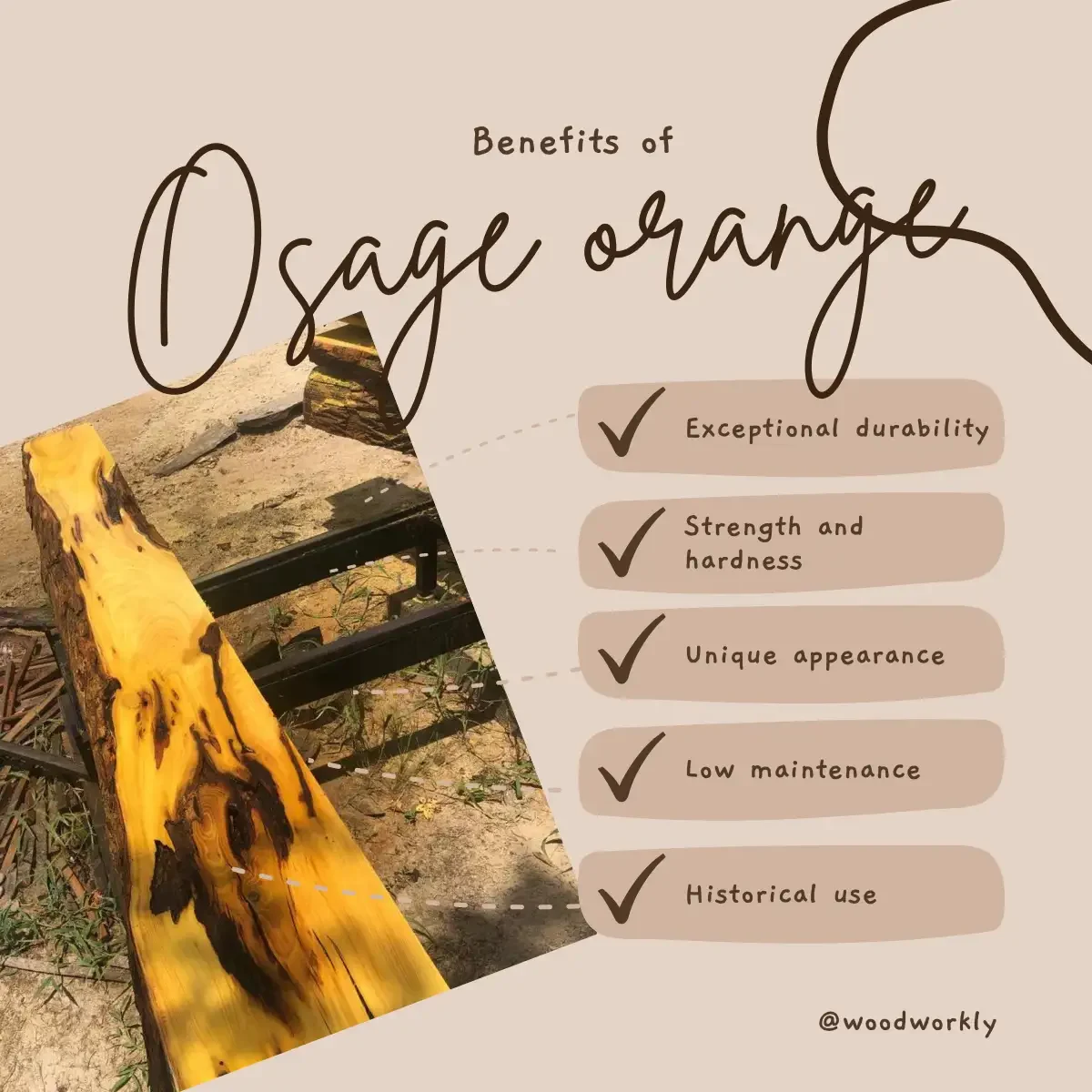
Aesthetically, Osage orange’s striking color and grain add elegance to outdoor spaces, enhancing the fence’s visual appeal.
Though not the fastest-growing, its use supports sustainable forestry when sourced responsibly.
Osage orange fences, known for their durability, strength, weather resistance, and beauty, offer a long-lasting, attractive, and eco-friendly fencing solution.
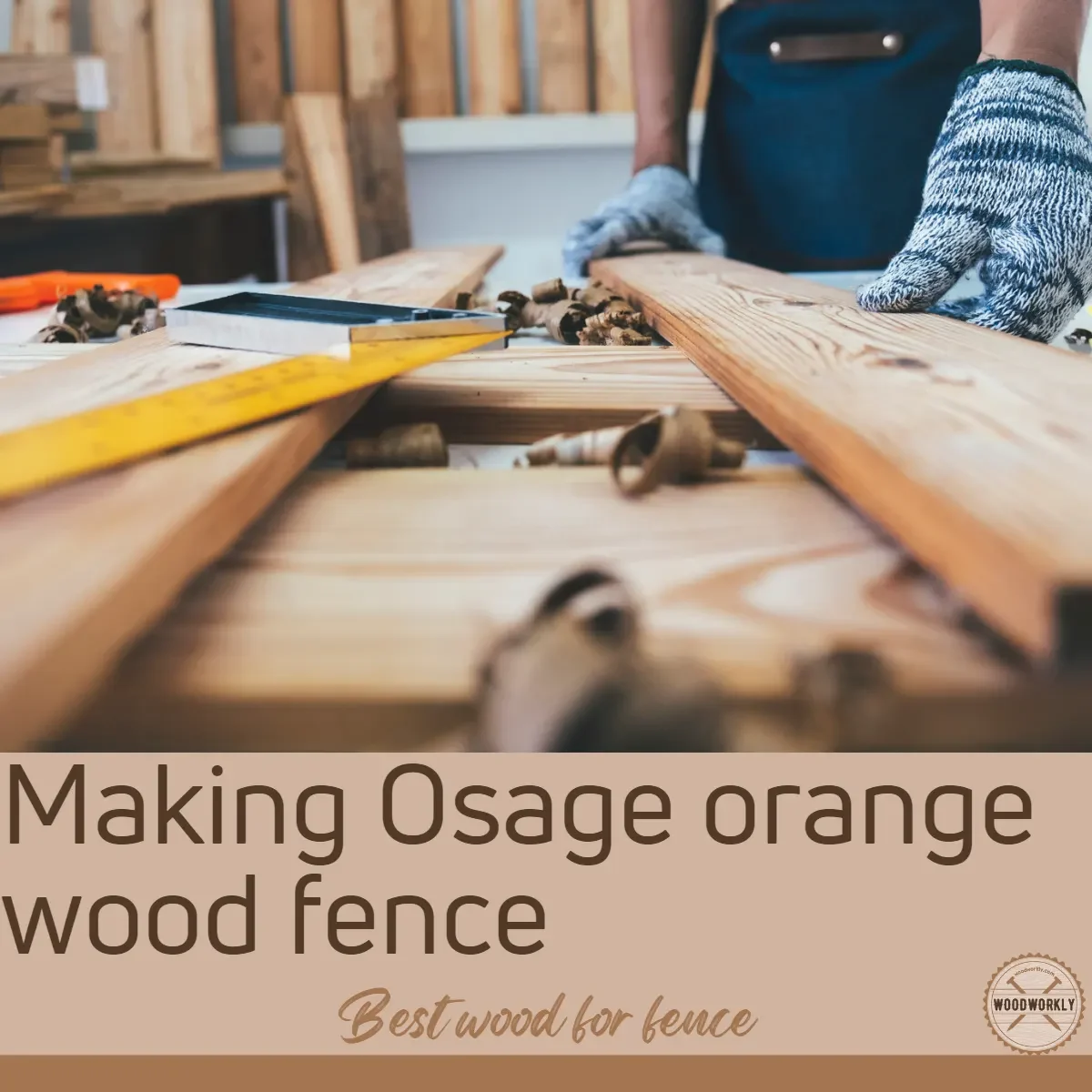
So, let’s have a look at some advantages and disadvantages you’ll get by making a fence using Osage orange wood.
Advantages And Disadvantages Of Using Osage Orange For Fencing
| Advantages | Disadvantages |
| Exceptional durability | Higher cost compared to other wood types |
| High strength | Limited availability in some regions |
| Weather resistance | Difficult to work with due to density |
| Aesthetic appeal | Potential for irregular grain and warping |
| Sustainable when sourced responsibly | |
| High durability |
9. Douglas Fir
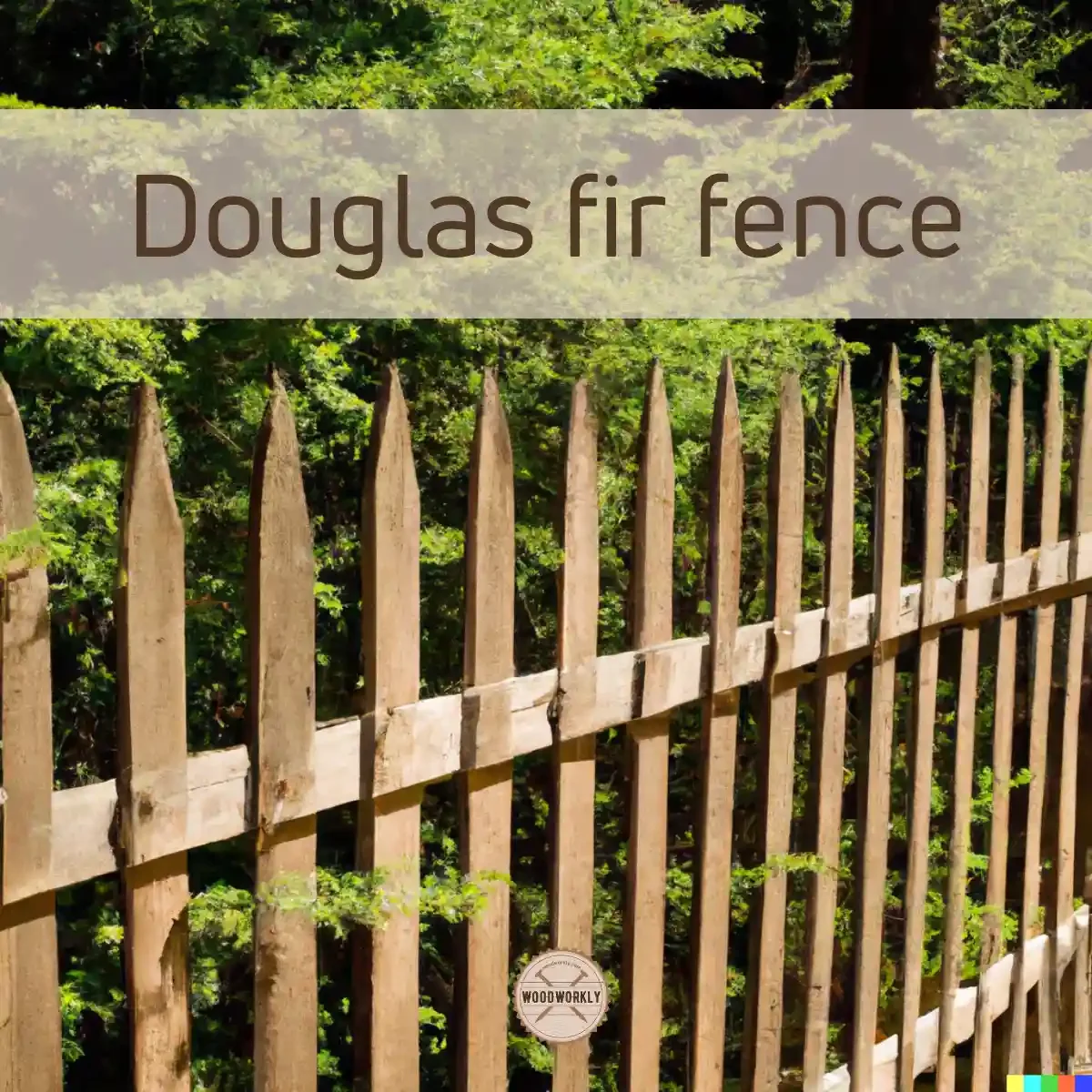
Douglas Fir, a widely favored softwood known for its light to medium brown color with orange or red tints and pronounced grain, is an excellent choice for fencing due to its strength, durability, and natural charm.
With a Janka hardness rating of 710 lbf, it offers exceptional dimensional stability, making it less prone to rot and decay, even in damp environments.
Douglas Fir adapts well to various climates, resisting warping or cracking in extreme temperatures.
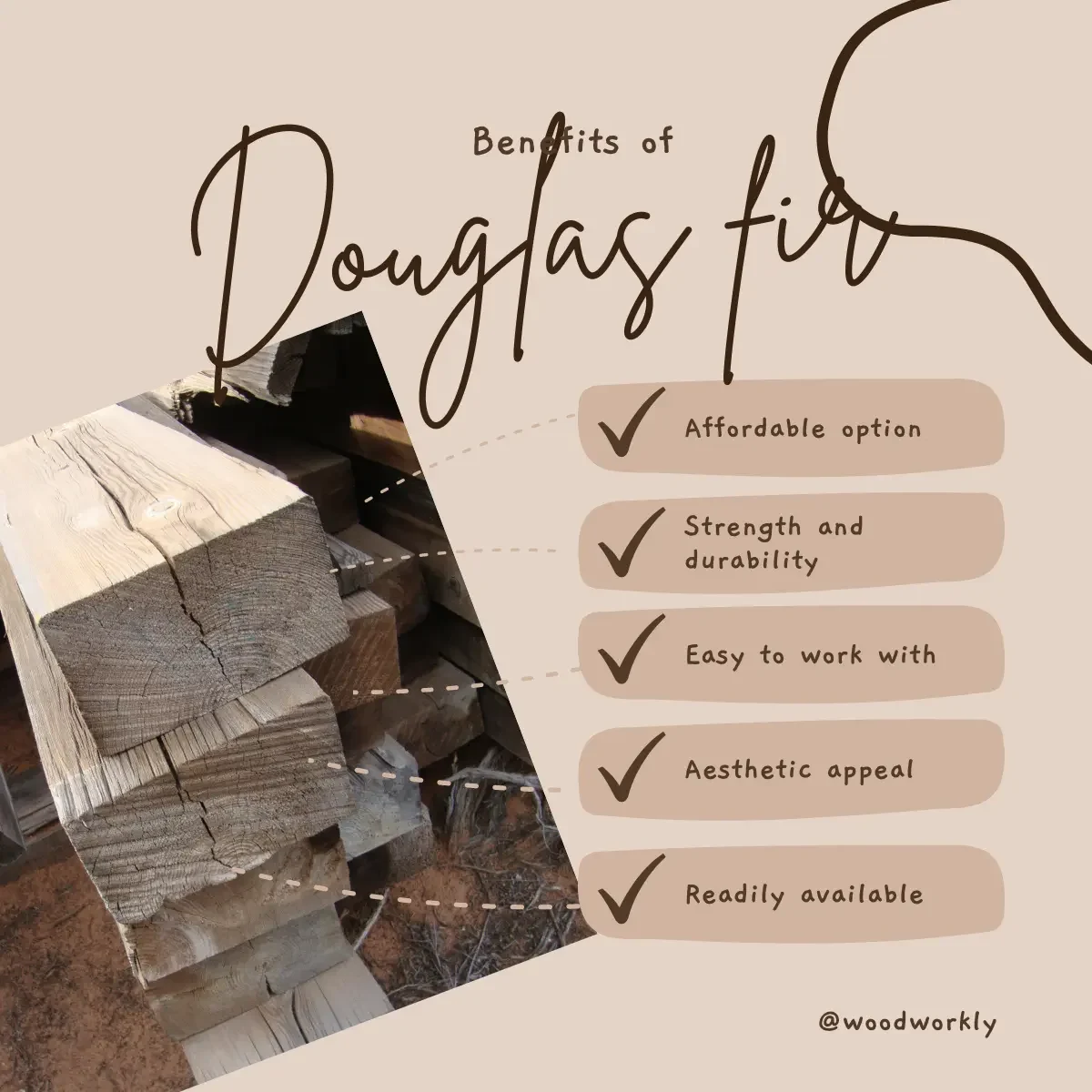
Its workability is appreciated by carpenters for easy manipulation and secure fastener holding, simplifying fence construction.
Cost-effective, it strikes a balance between affordability and long-lasting quality.
As a rapidly growing species, using responsibly harvested Douglas Fir supports sustainable forestry practices.
Its combination of captivating appearance, strength, climate adaptability, and eco-friendliness makes it a superb material for durable and attractive fences.
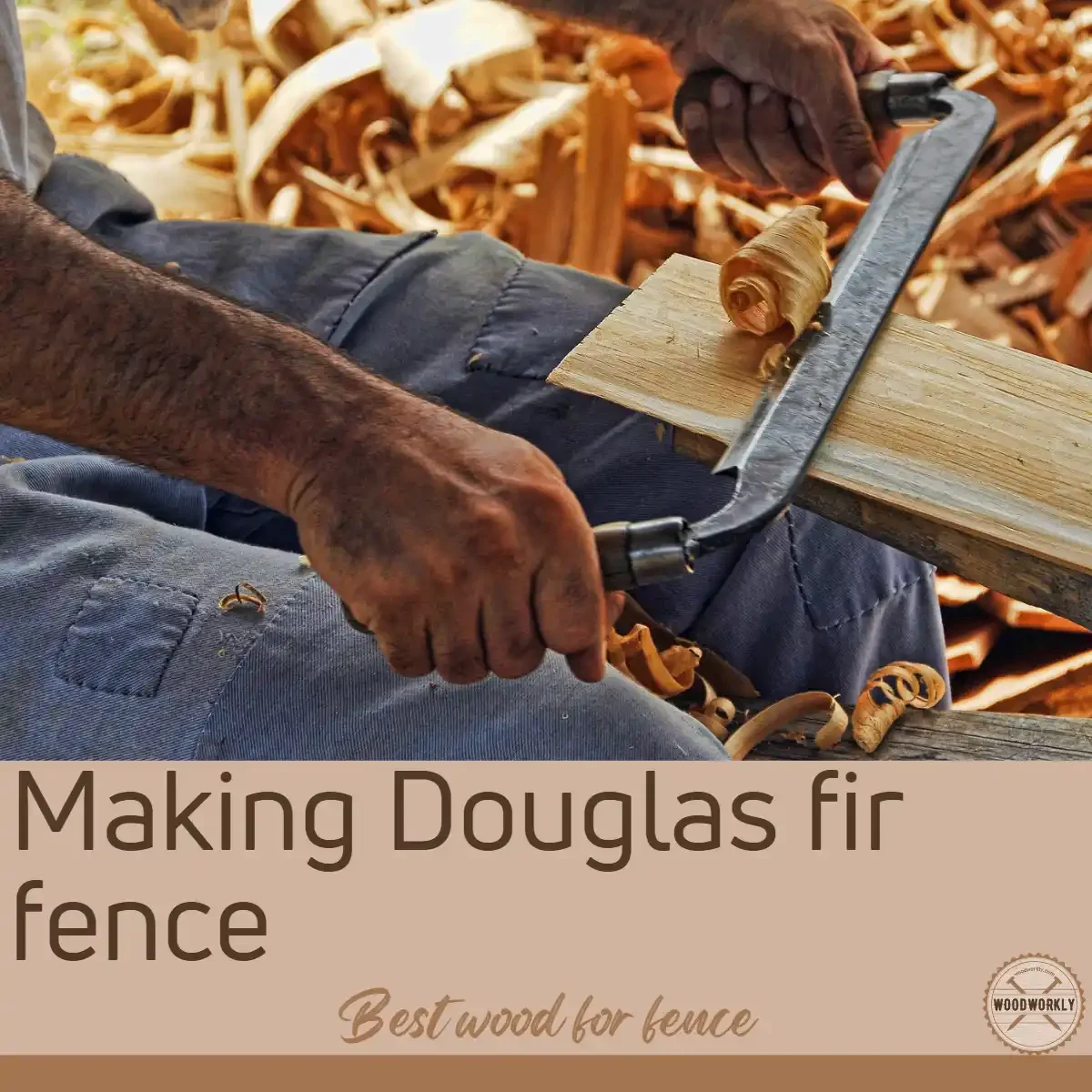
To ease things out, here’re some advantages and disadvantages you’ll probably get by using Douglas fir as the fencing material.
Advantages And Disadvantages Of Using Douglas Fir For Fencing
| Advantages | Disadvantages |
| Excellent strength and durability | Less decay-resistant than cedar or redwood |
| Adapts well to various climates | Requires periodic maintenance (e.g., staining/sealing) |
| Easy to work with for carpenters | Not as readily available in some regions |
| Cost-effective compared to other options | The initial cost may be higher than pressure-treated pine |
| Environmentally friendly if sourced responsibly | May be prone to warping if not dried and treated properly |
10. Ipe Or Brazilian Walnut
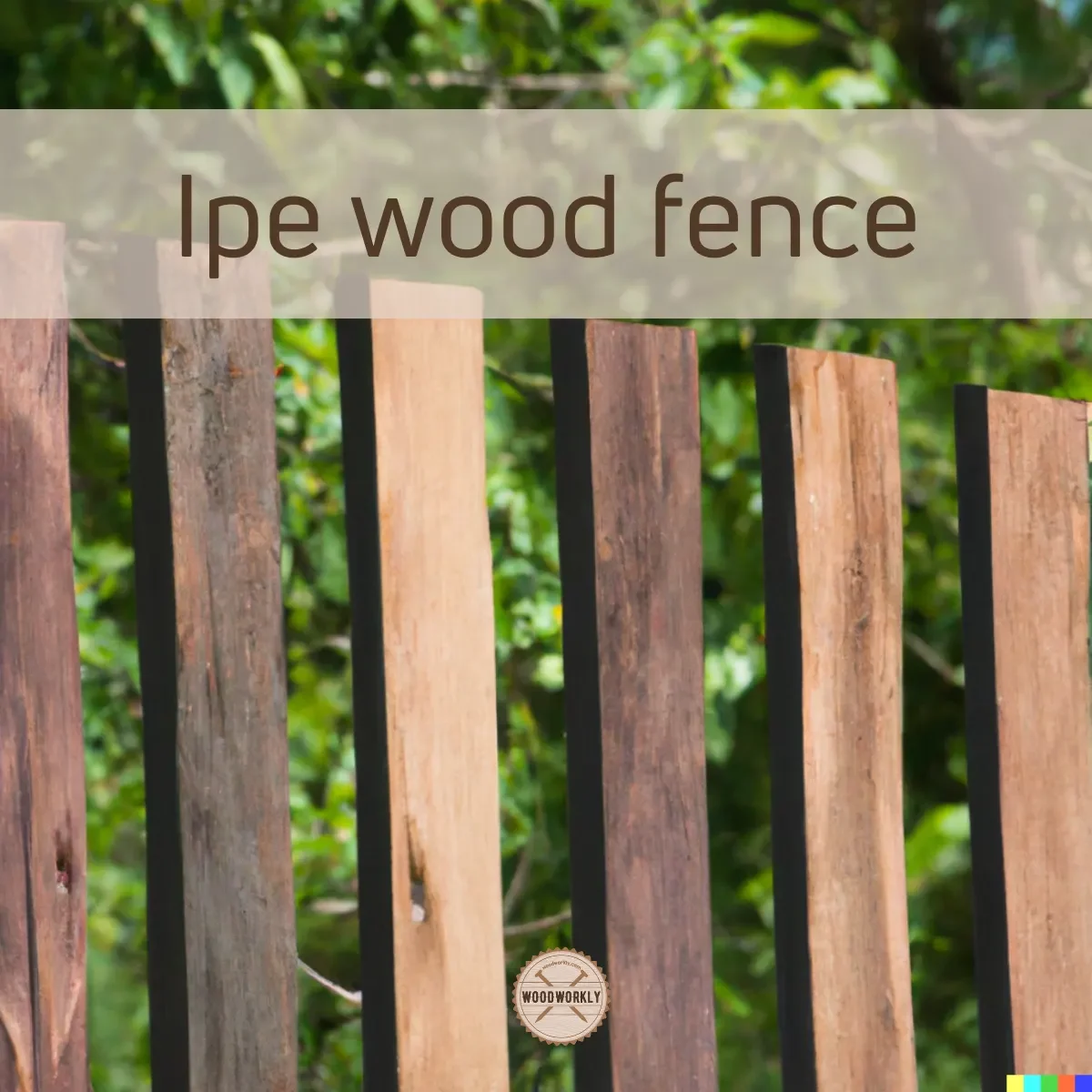
Ipe, also known as Brazilian walnut, is a highly durable hardwood perfect for fencing, with a Janka hardness rating of 3,510 lbf.
Its exceptional durability, thanks to natural resistance to rot, decay, and insects, means Ipe wood fences can last over 40 years with minimal maintenance.
This South American wood withstands extreme weather conditions, maintaining its integrity through varying temperatures.
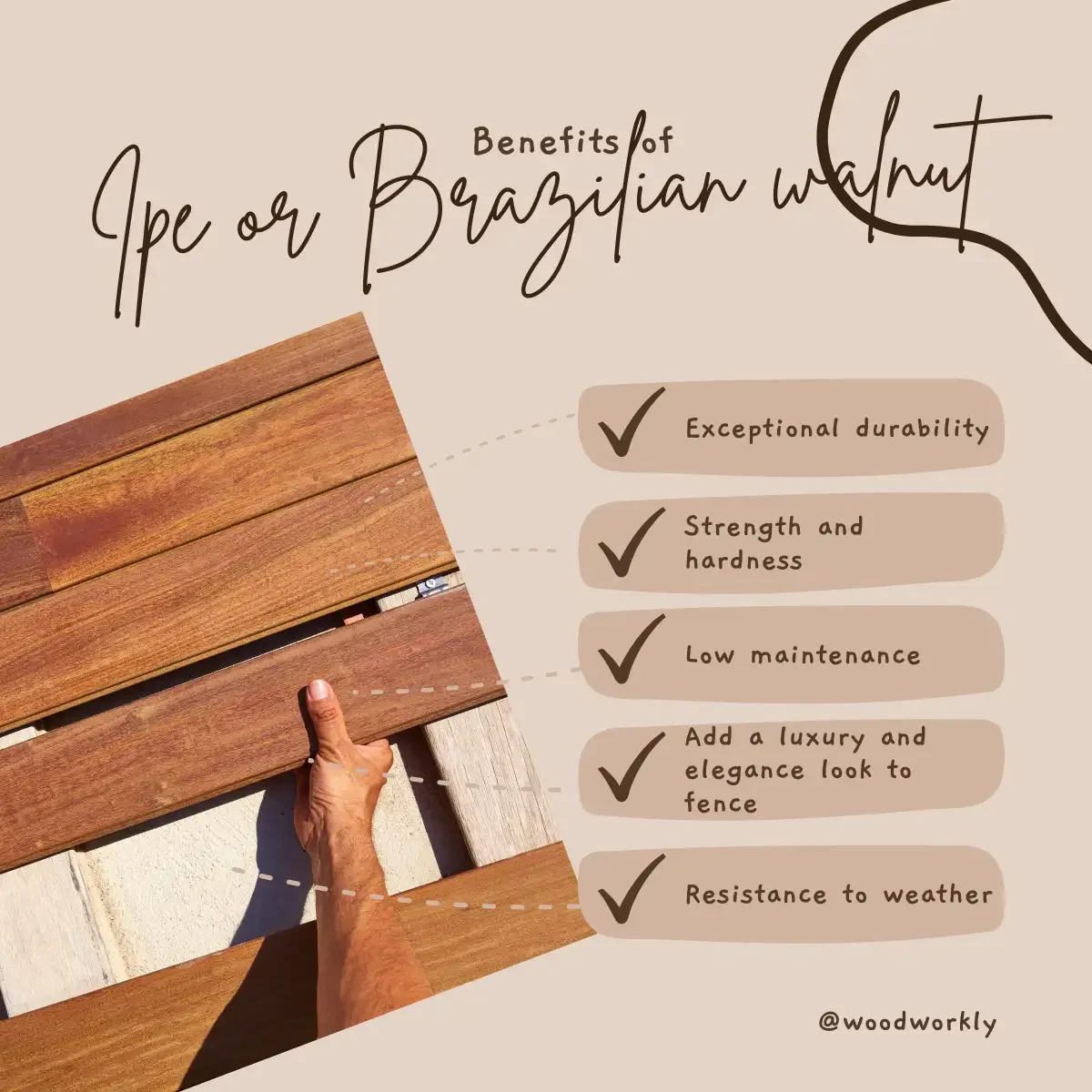
Aesthetically, Ipe’s rich, dark brown color and tight grain pattern add elegance to any fencing project.
Its strength prevents warping, twisting, and cracking, ensuring a stable and long-lasting fence.
While Ipe requires specialized tools for installation and might be costlier than other materials, its low maintenance, durability, and sophisticated appearance make it an outstanding choice for fencing, especially when sustainably sourced.
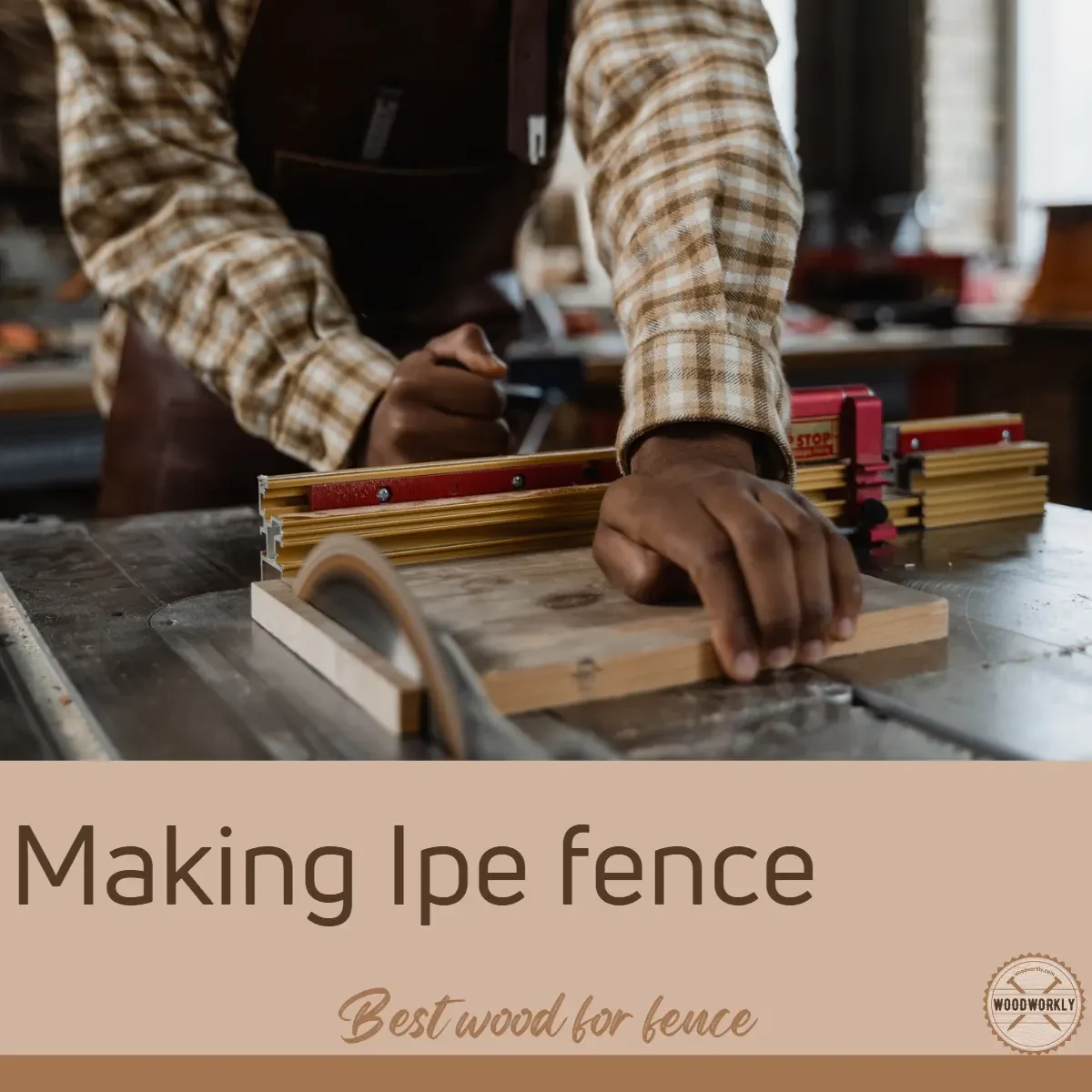
Let’s see some advantages and disadvantages you’ll get by using Ipe wood as a fencing material.
Advantages And Disadvantages Of Using Ipe Wood For Fencing
| Advantages | Disadvantages |
| Exceptional durability and longevity | Higher cost compared to other fencing materials |
| Weather-resistant | Requires specialized tools and techniques for working |
| Low maintenance | Can be difficult to source responsibly and sustainably |
| Aesthetic appeal | Heavier and denser, making transportation and installation more challenging |
| Strong and resistant to warping, twisting, and cracking | May require pre-drilling for fasteners due to the density |
11. Bamboo
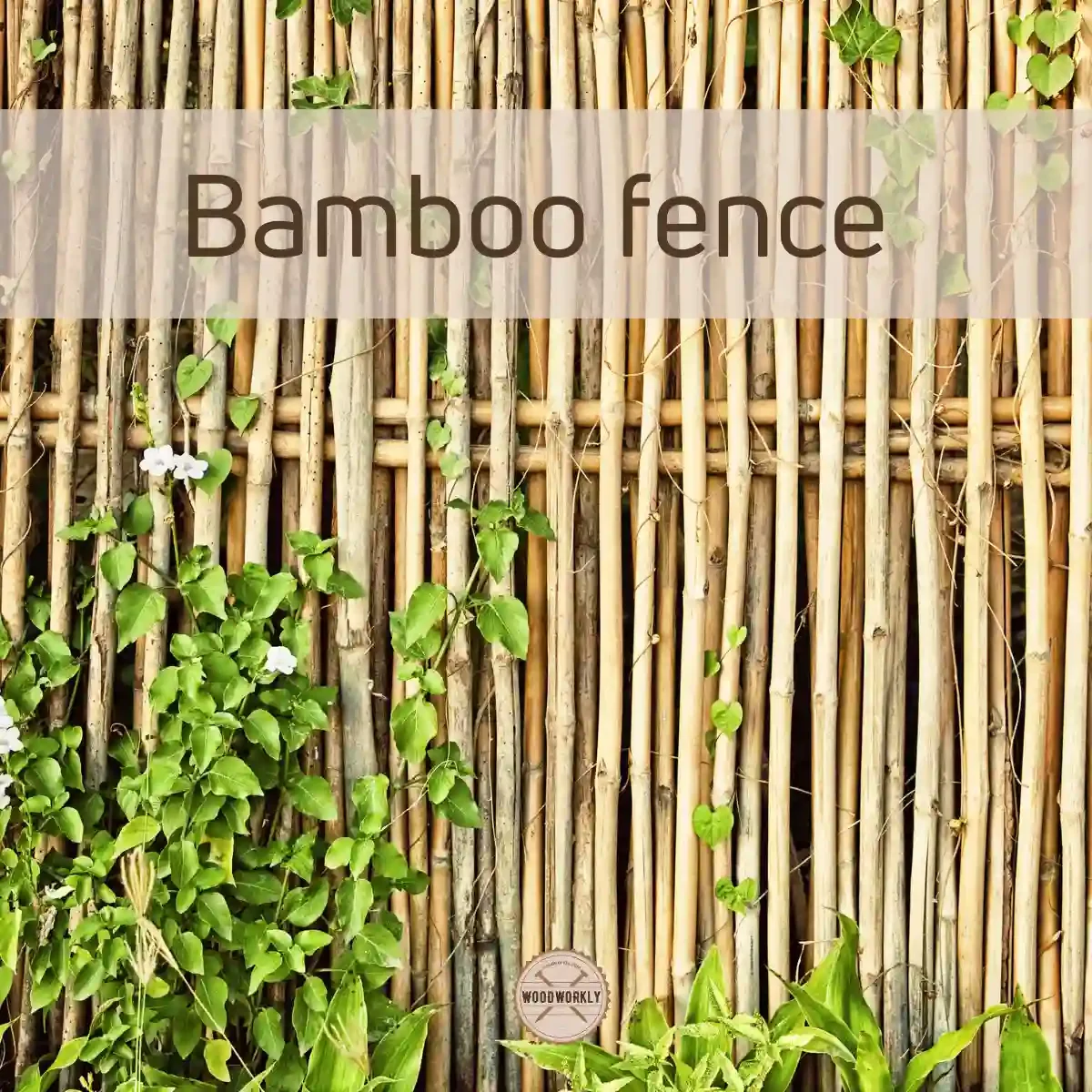
Bamboo, a strong and unique material, is a popular choice for fencing due to its eco-friendliness, durability, and aesthetic appeal.
Characterized by its smooth, cylindrical shape and golden-yellow hue, bamboo grows rapidly, making it a sustainable option that lessens the burden on forests.
While not as durable as some hardwoods, properly treated and maintained bamboo can resist pests, rot, and decay, ensuring a long-lasting and visually appealing fence.
Its lightweight nature facilitates easier handling and installation, reducing labor costs.
Bamboo’s cost-effectiveness, coupled with its attractive appearance, offers homeowners a budget-friendly, eco-conscious fencing solution that adds a natural and serene ambiance to outdoor spaces.
With its versatility in design, bamboo fencing can range from simple screens to ornate panels, providing both beauty and functionality for years.
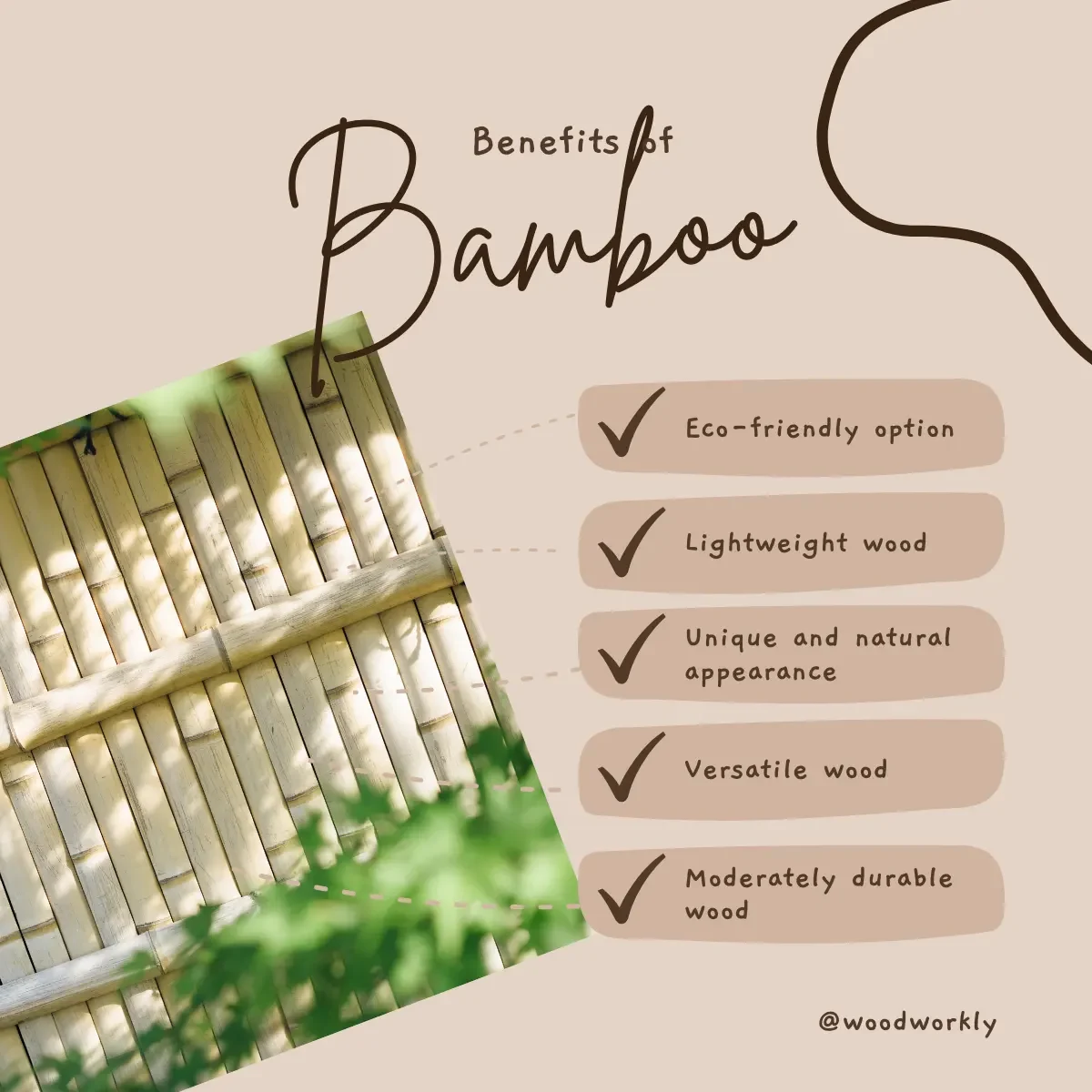
Let’s find out some advantages and disadvantages of using Bamboo wood as fence-making material.
Advantages And Disadvantages Of Using Bamboo Wood For Fencing
| Advantages | Disadvantages |
| Eco-friendly and sustainable | Not as durable as some hardwoods |
| Unique aesthetic appeal | Requires proper treatment and maintenance to resist decay |
| Lightweight and easy to install | Susceptible to damage from moisture if not treated |
| Cost-effective | Limited resistance to strong winds and impacts |
| Versatile in design and style | May not be suitable for all climates and environments |
12. Balau
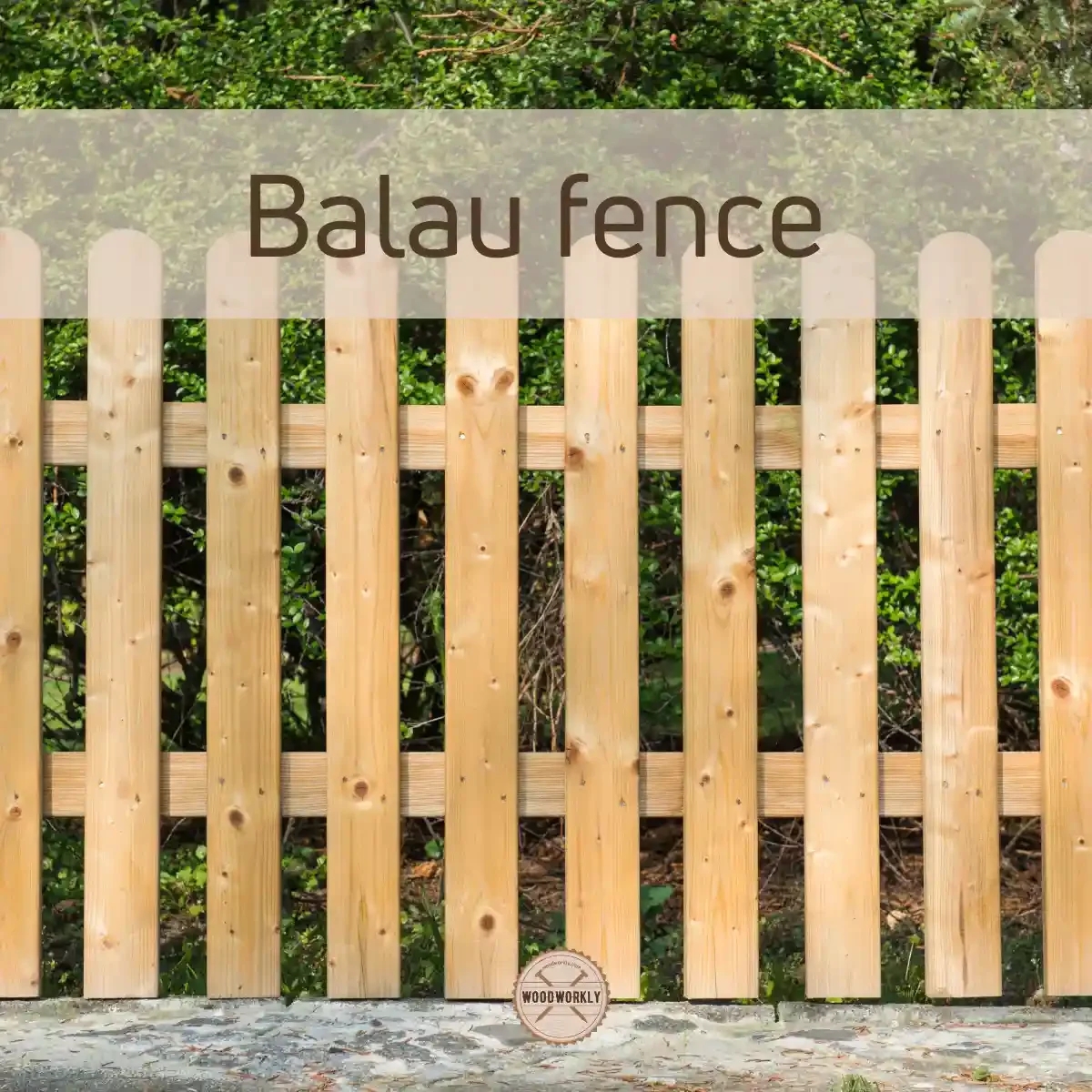
Balau, a dense and durable hardwood from Southeast Asia, is an excellent choice for fencing due to its natural durability, weather resistance, and aesthetic appeal.
Its high oil content and tight grain structure protect it from decay, rot, and insect damage, making it suitable for harsh environmental conditions.
Balau wood’s resistance to moisture, UV rays, and its ability to avoid swelling, warping, and shrinking ensures longevity and visual appeal.
The wood’s rich, reddish-brown hue and fine grain patterns create a warm and inviting atmosphere, suitable for various fencing designs.
Its strength and density can withstand significant stress, ensuring the fence’s stability.
Although relatively low-maintenance, periodic cleaning and sealing can extend its lifespan.
Choosing Balau for your fencing means investing in a long-lasting, attractive, and functional addition to your property.
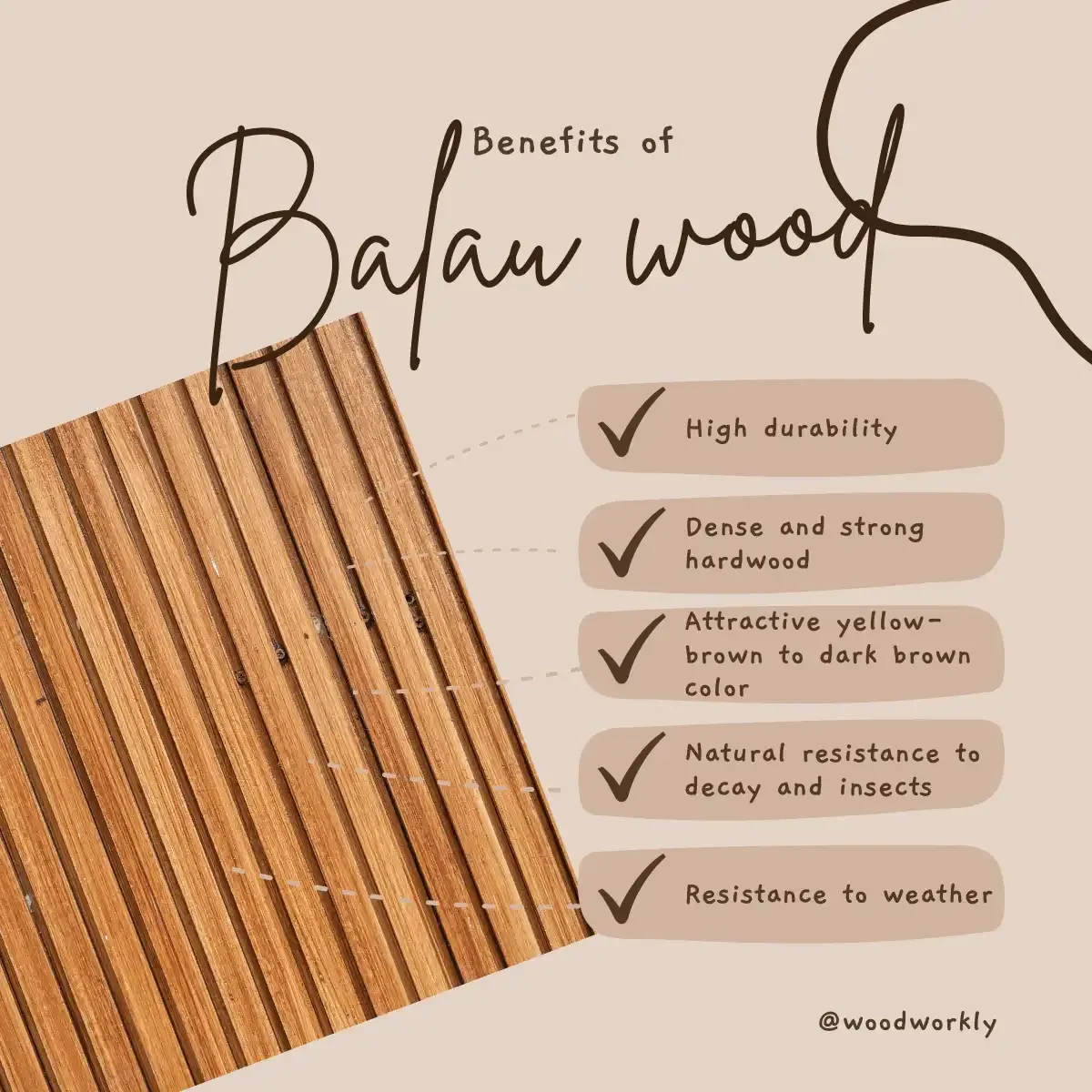
Advantages And Disadvantages Of Using Balau Wood For Fencing
| Advantages | Disadvantages |
| Exceptional durability | Can be more expensive than some other wood options |
| Excellent weather resistance | May contribute to deforestation if not responsibly sourced |
| Attractive aesthetic appeal | Heavy, making installation more labor-intensive |
| High strength and stability | Requires occasional sealing to maintain the appearance |
| Low maintenance requirements | Limited availability in some regions |
13. Oak
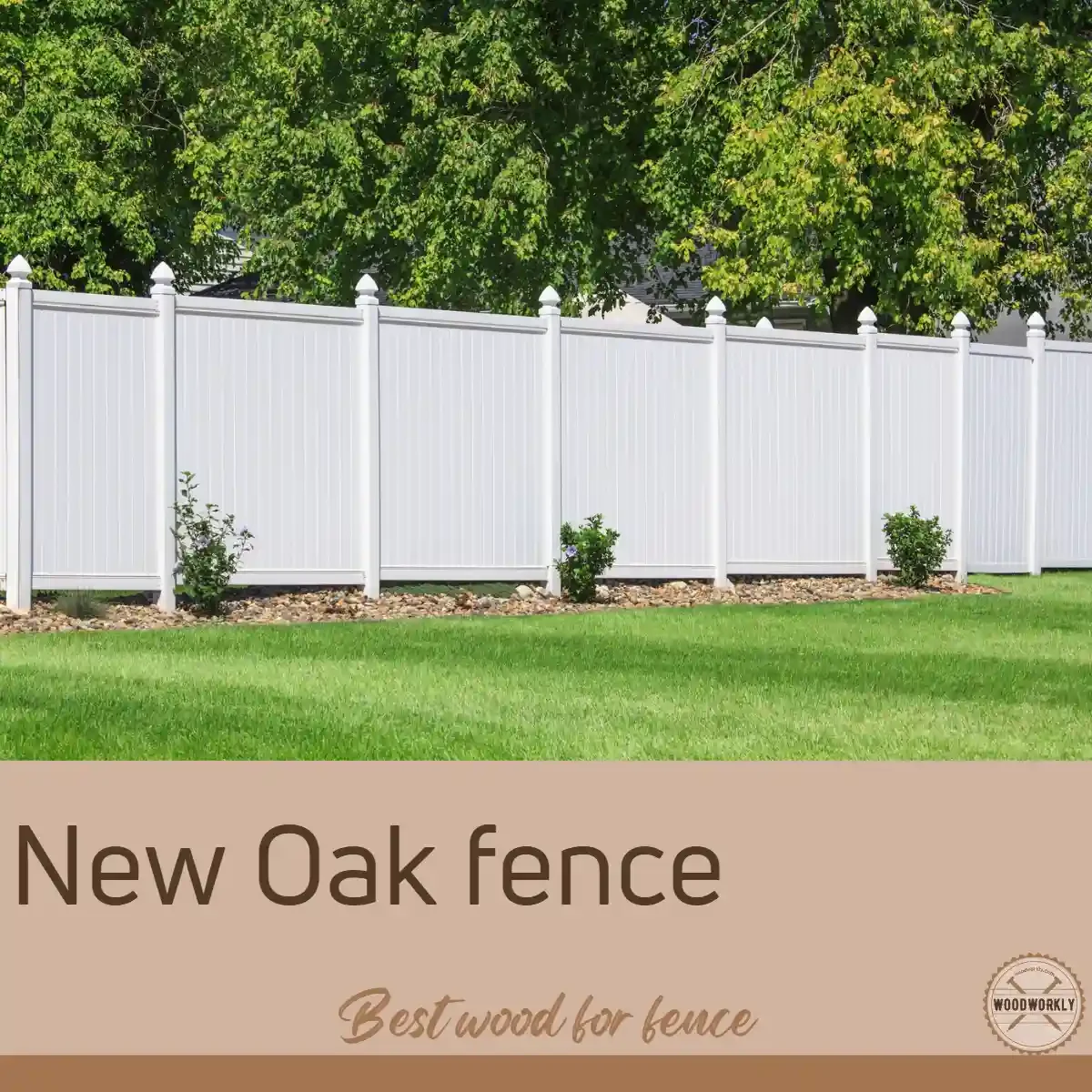
Oak is a highly favored fencing material, known for its strength, durability, and attractive appearance.
With a high hardness rating (1,290 lbf for red oak and 1,360 lbf for white oak), it’s more durable than many woods, making it ideal for outdoor use.
Oak’s natural tannins protect against decay, rot, and insects, allowing it to withstand harsh environmental conditions and prevent decay.
Its dense nature resists moisture and UV rays, preventing swelling, warping, and discoloration.
With a range of warm colors and unique grain patterns, oak enhances the aesthetic appeal of any property.
Additionally, its high density ensures it can withstand significant stress without bending, ensuring a stable and long-lasting fence.
Versatile in design, oak accommodates various fencing styles, making it suitable for both traditional and modern projects.
Choosing oak for fencing means investing in a beautiful, strong, and functional addition that will endure for years.
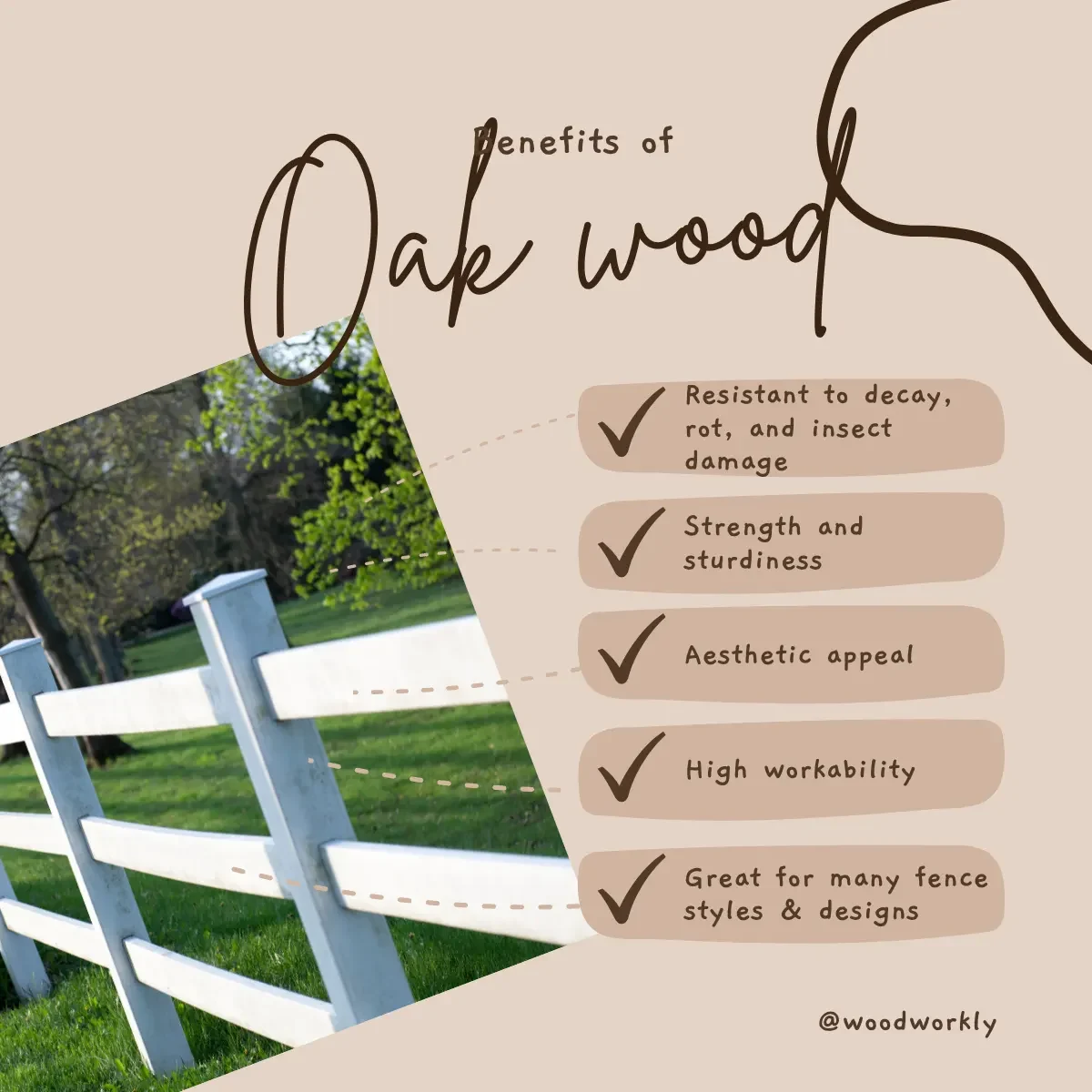
Let’s see some advantages and disadvantages you’ll get by taking Oakwood to build your fence,
Advantages And Disadvantages Of Using Oak Wood For Fencing
| Advantages | Disadvantages |
| Exceptional durability | Can be more expensive than some other wood options |
| Excellent weather resistance | Requires regular maintenance, such as sealing or staining |
| Attractive aesthetic appeal | Heavy, making installation more labor-intensive |
| High strength and stability | Susceptible to moisture damage if not properly treated |
| Versatility in design and style | Some oak species may be less sustainable than other wood types |
14. Teak
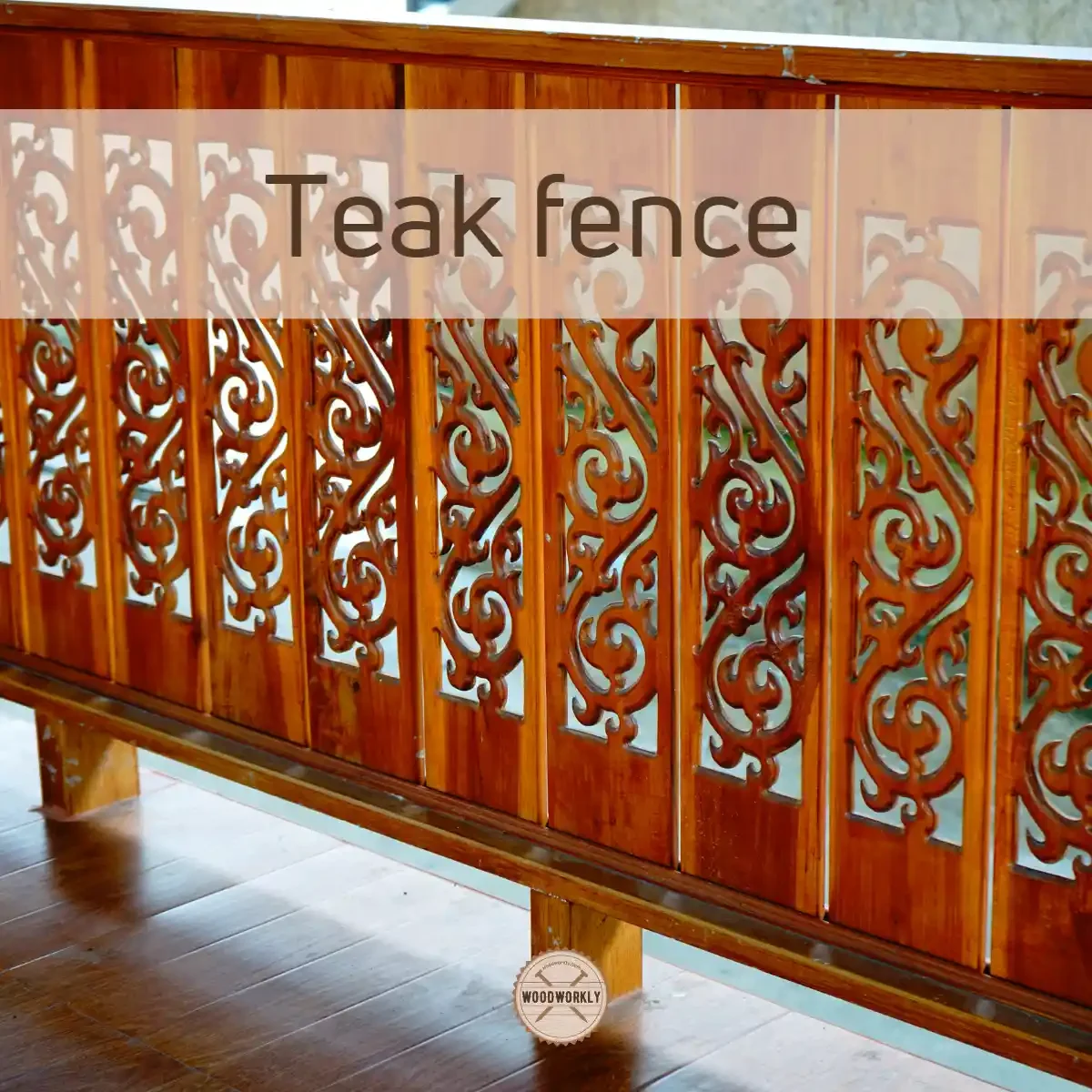
Teak wood, a luxurious tropical hardwood from Southeast Asia, stands out as a premier choice for fencing due to its remarkable durability, weather resistance, and aesthetic appeal.
With a Janka hardness rating of 1000 – 1155, it’s well-equipped to withstand external conditions, requiring minimal maintenance while enduring for centuries.
Teak’s high natural oil content protects it from rot, decay, and insect infestations, making it a cost-effective option in the long term.
Check out Teak Oil Advantages and Disadvantages
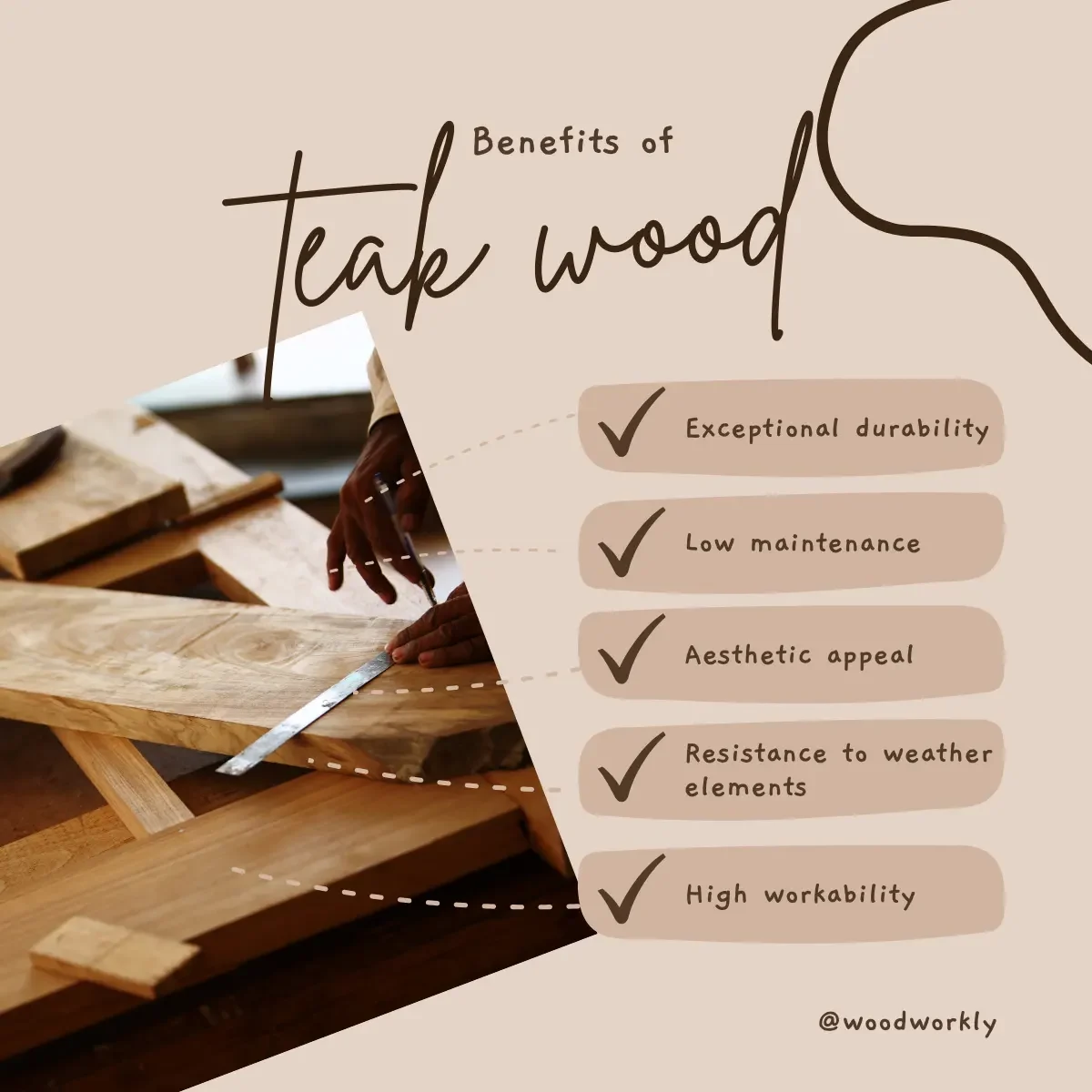
Its resilience to moisture, sunlight, and temperature changes ensures it maintains its quality and appearance in diverse weather.
The wood’s golden-brown hue, which darkens over time, and its straight-grain pattern lend an elegant and rich look to any property.
Teak’s dense grain structure imparts strength and stability, resisting warping, cracking, or splitting, essential for a durable fence.
Its low maintenance nature allows it to develop a beautiful silver-gray patina over time without frequent treatments.
By choosing teak for your fencing, you’re investing in a long-lasting, attractive, and practical addition to your property.
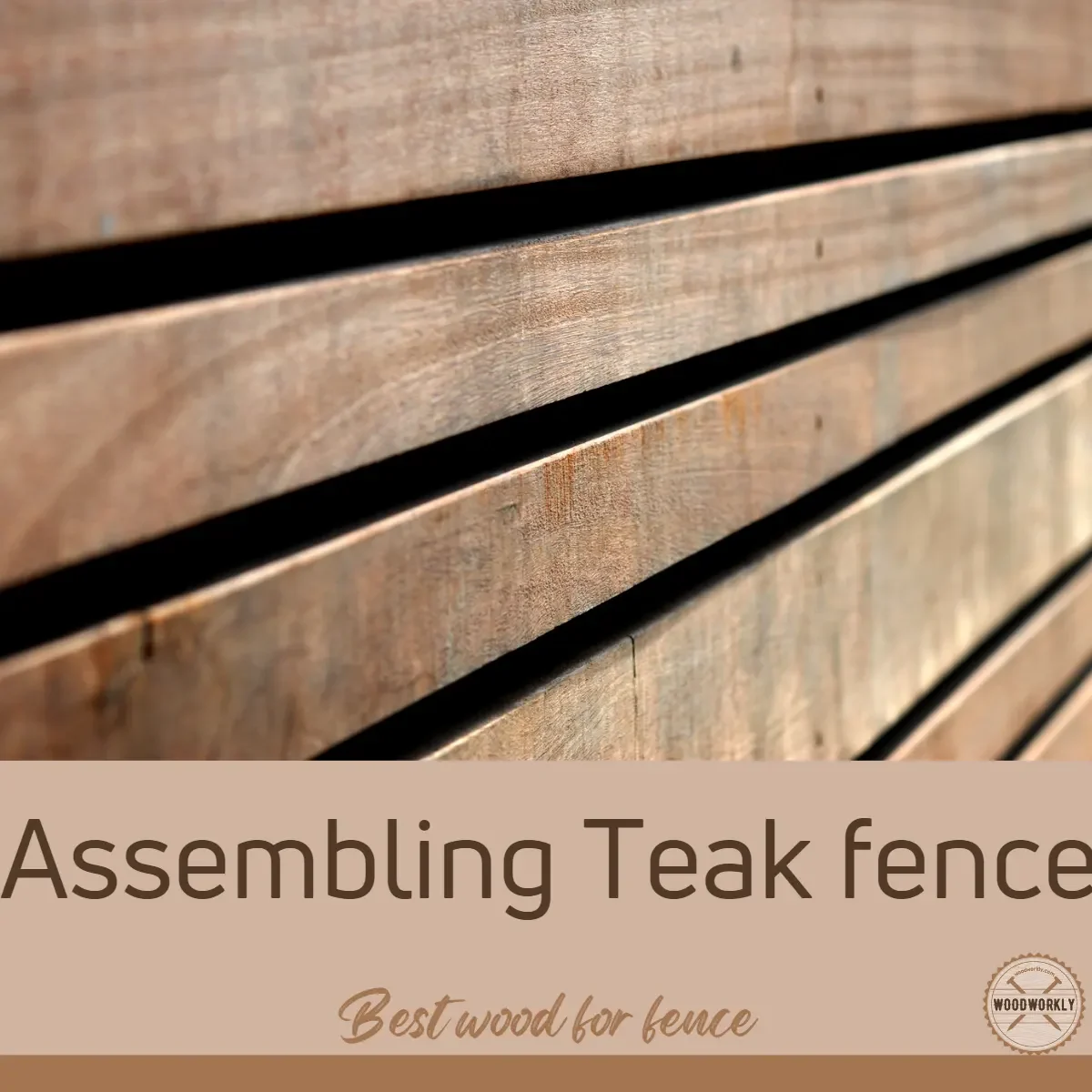
So, let’s find out some advantages and disadvantages of teak wood which are important when making fences.
Advantages And Disadvantages Of Using Teak Wood For Fencing
| Advantages | Disadvantages |
| Exceptional durability | Can be more expensive than other wood options |
| Excellent weather resistance | May not be as sustainable, depending on the source |
| Attractive aesthetic appeal | Limited availability in some regions |
| High strength and stability | |
| Low maintenance |
15. Composite
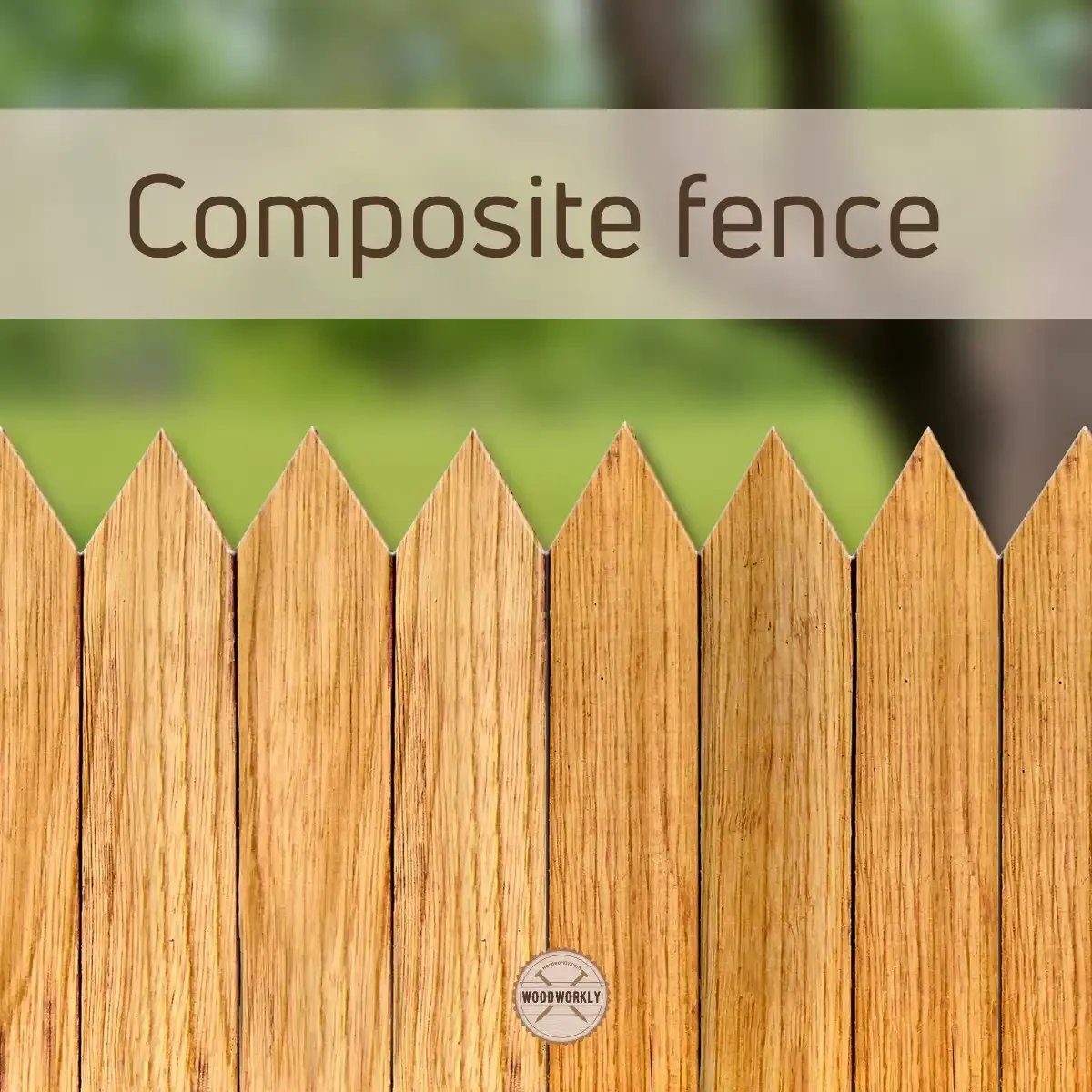
Composite wood, also known as wood-plastic composite (WPC) or engineered wood, is an increasingly popular choice for fencing due to its durability, weather resistance, customizable appearance, low maintenance, and environmental friendliness.
This man-made material combines the look of natural wood with a range of colors and textures, offering versatility for different fencing styles.
Resistant to rot, decay, and wood boring insect damage, composite wood withstands daily wear and tear, reducing the need for frequent repairs or replacements.
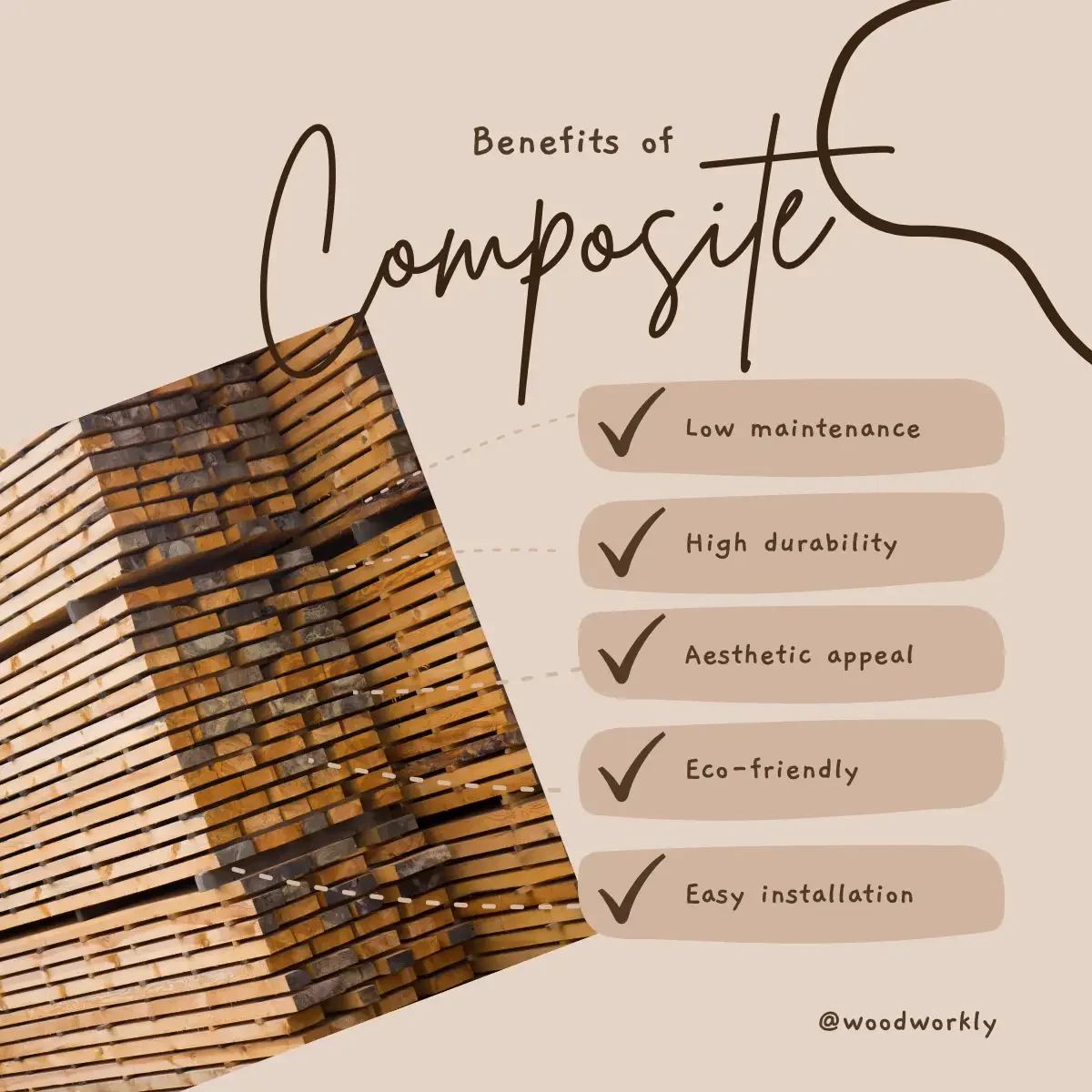
It remains stable under various weather conditions, resisting warping or cracking, making it suitable for diverse climates.
The low-maintenance nature of composite wood means it requires only simple cleaning, saving time and effort.
Moreover, its production from recycled materials supports sustainable practices, making it an eco-friendly option.
By choosing composite wood for fencing, homeowners can enjoy the aesthetic of traditional wood without its drawbacks, ensuring a long-lasting and attractive addition to their property.
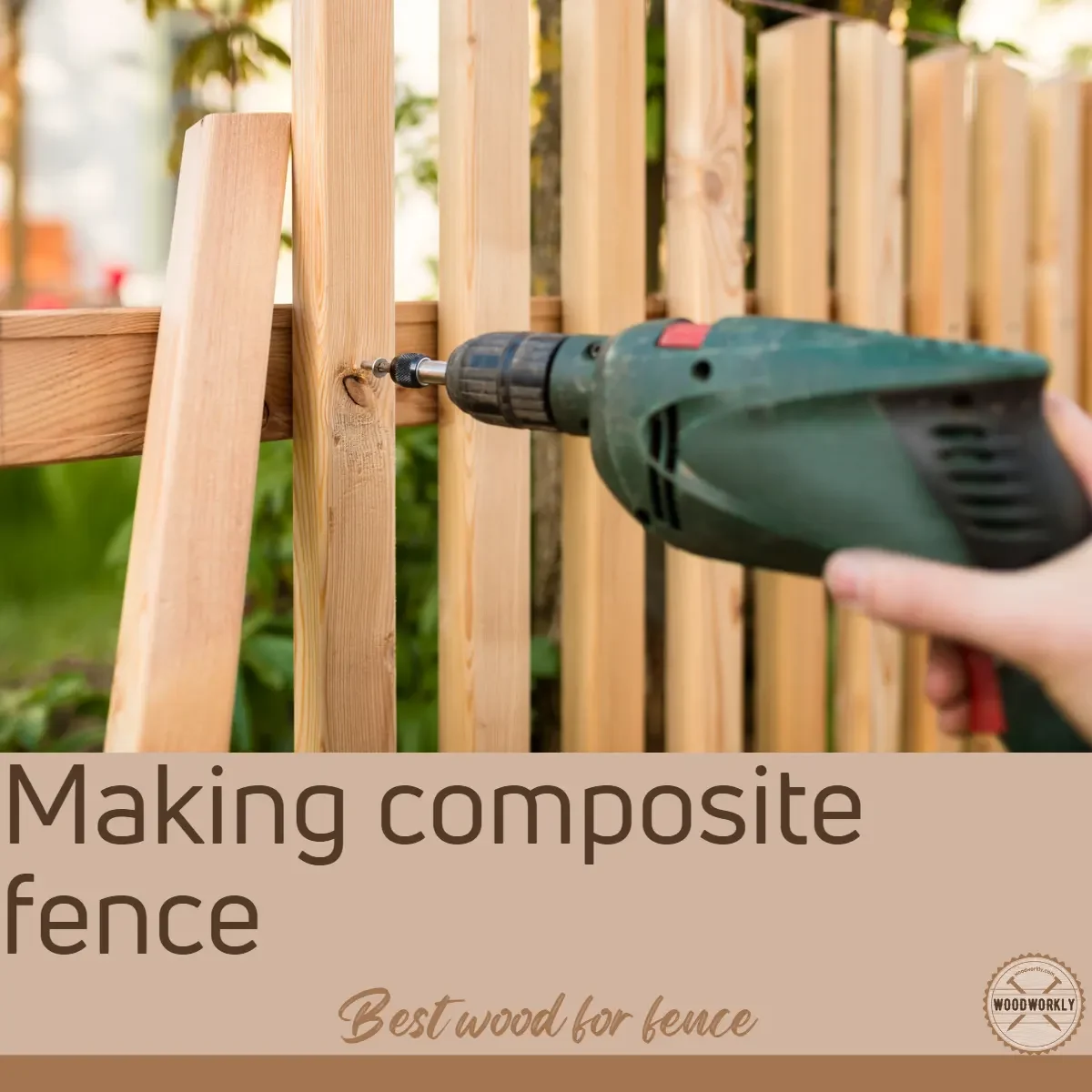
Let’s see some advantages and disadvantages of composite wood which will be really useful when making fences.
Advantages And Disadvantages Of Using Composite Wood For Fencing
| Advantages | Disadvantages |
| Durable and long-lasting | Can be more expensive than some natural wood options |
| Weather-resistant, suitable for various climates | Limited repair options, typically require replacement |
| Customizable appearance | Can have a less natural look than real wood |
| Low maintenance requirements | May fade or change color over time |
| Environmentally friendly | Potential for surface damage, such as scratches |
16. Pressure-Treated Wood
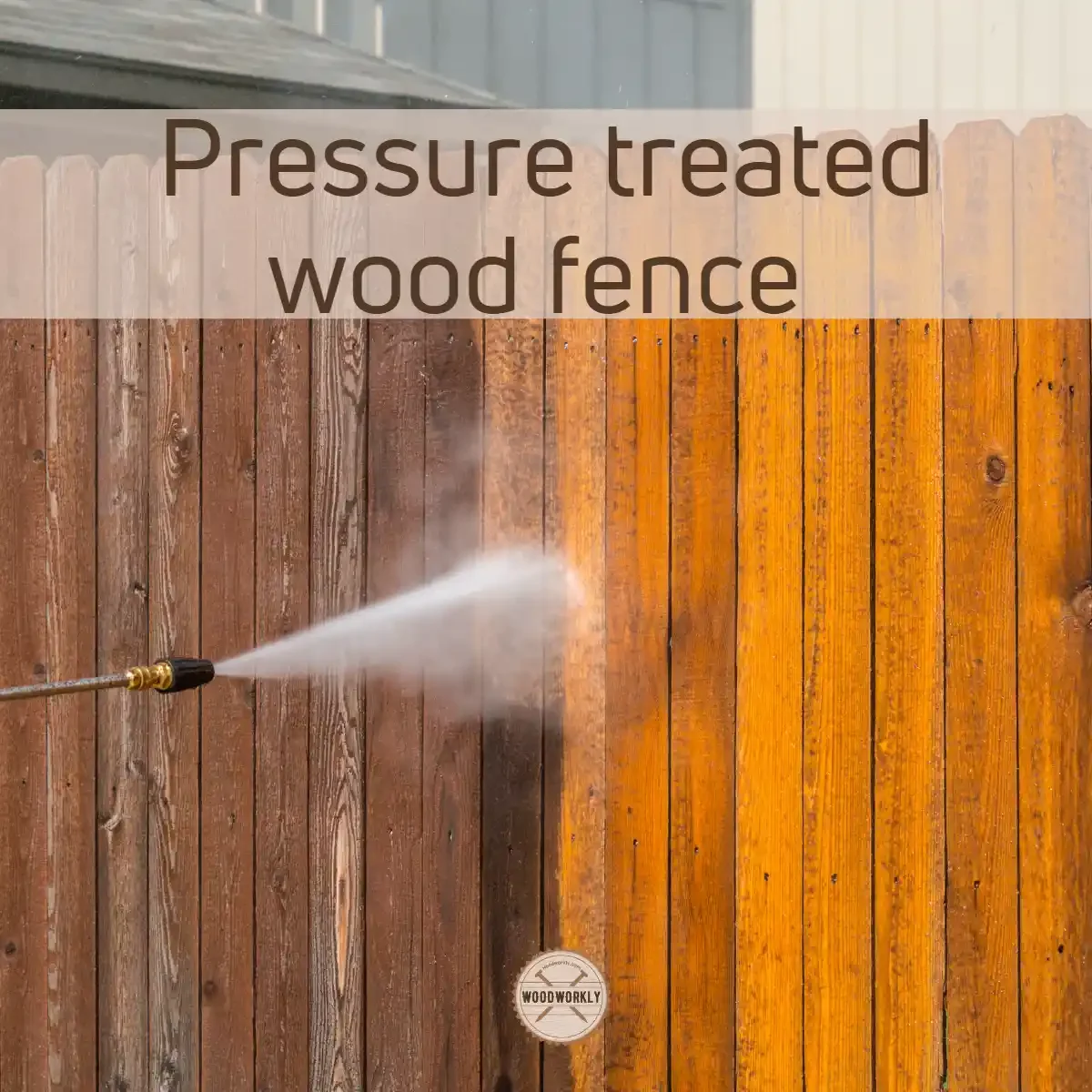
Pressure-treated wood is a favored material for fencing, offering durability, affordability, and ease of workability.
Treated with chemical preservatives to resist decay, rot, and insect attacks, it comes in a range of colors and can be customized to fit personal preferences.
Over time, its color may change to a grayish hue, but it’s easily stainable or paintable for design versatility.
This wood’s longevity, with minimal maintenance, makes it ideal for fences, ensuring sturdiness and structural integrity over many years.
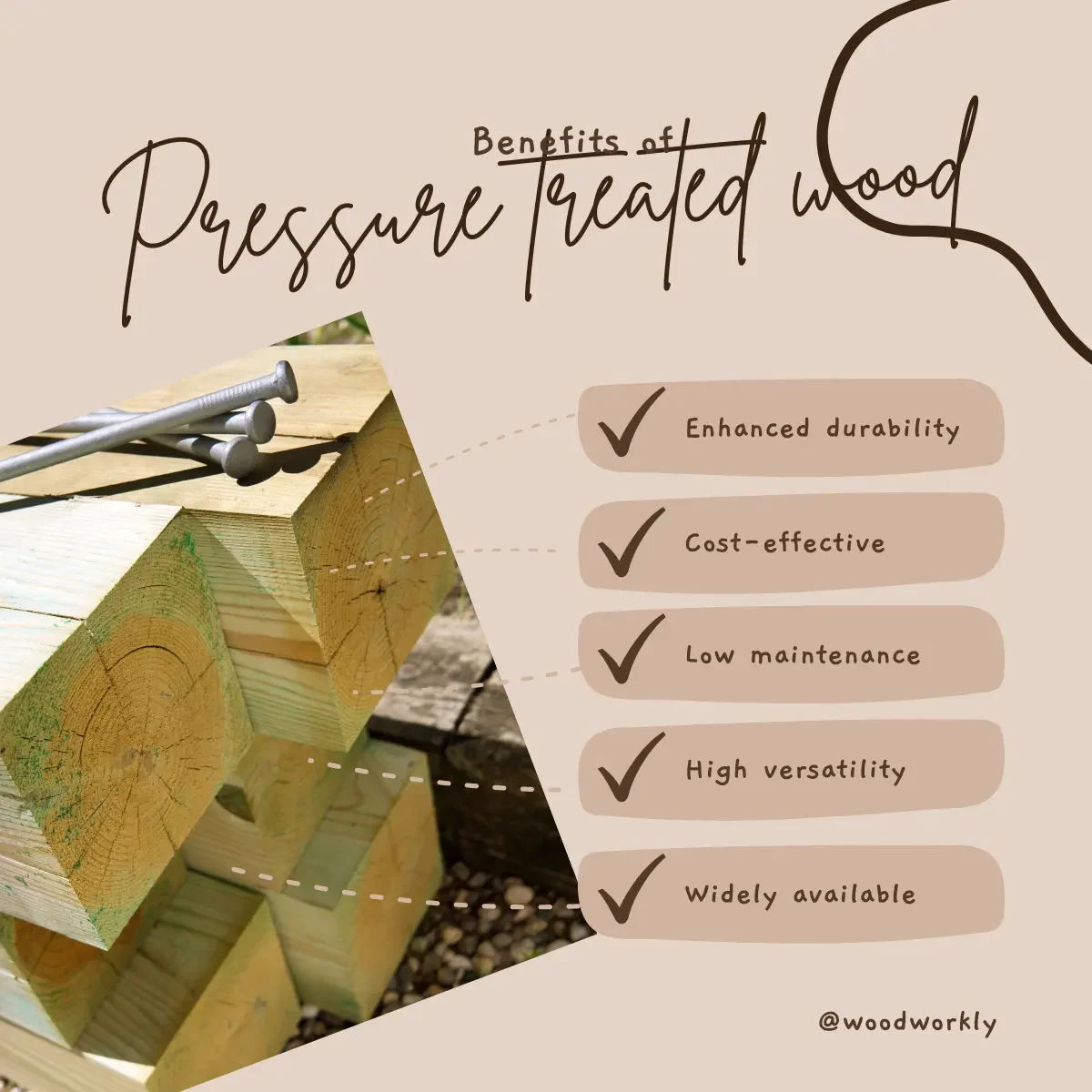
While regular cleaning is necessary to maintain its appearance, pressure-treated wood is an economical choice compared to hardwoods or composites.
Pressure-treated wood availability in various dimensions and sizes allows for creative and unique fencing designs.
Easily cut, drilled, and shaped, it’s perfect for both DIY projects and professional installations.
Widely available at most lumberyards and home improvement stores, pressure-treated wood stands out for its combination of practicality, durability, and cost-effectiveness, making it a top choice for crafting an attractive, long-lasting outdoor space.
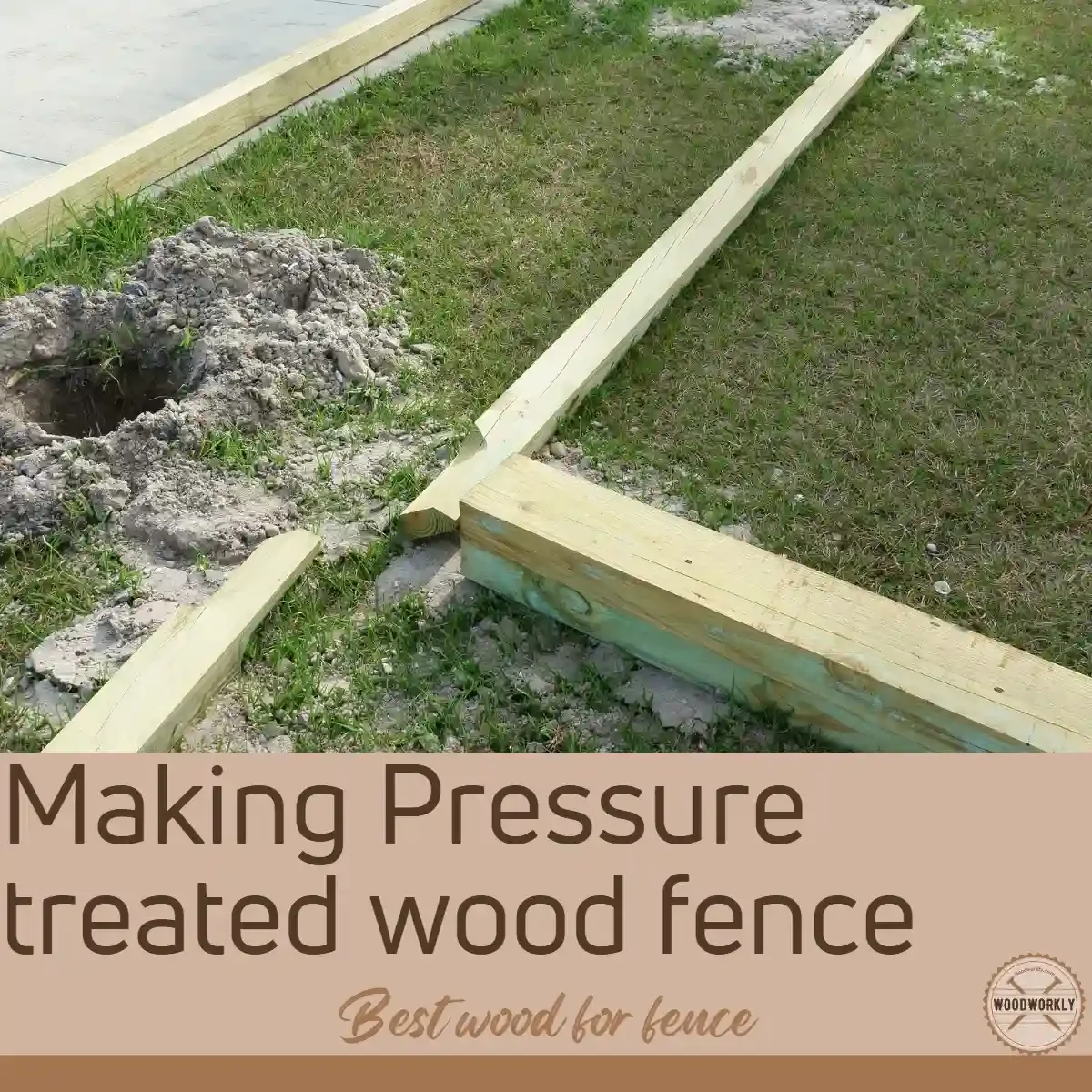
Let’s have a look at some advantages and disadvantages of pressure-treated to get a good understanding of its importance.
Advantages And Disadvantages Of Using Pressure-Treated Wood For Fencing
| Advantages | Disadvantages |
| Durable and resistant to decay and insects | Chemical treatment may raise environmental concerns |
| Cost-effective compared to other materials | Requires regular maintenance, such as staining or painting |
| Easy to work with and install | Can warp, crack, or split over time |
| Widely available and easily sourced | Aesthetic may not be as appealing as natural wood |
| Customizable with stains or paint | May require additional treatment for ground contact |
That’s it, folks! Now you know all you should know about the best wood for fence with characteristic features of 16 different kinds of wood with the advantages and disadvantages of each in detail.
Let’s have a look at some frequently asked questions as well.
What Type Of Wood Fence Lasts The Longest
Ipe (Brazilian Walnut) and Black Locust are top choices for long-lasting fencing materials, thanks to their natural resistance to decay, insects, and extreme weather.
Both woods are highly dense and durable, potentially lasting for decades with appropriate care.
However, when selecting between them, it’s important to consider factors like cost, availability, and maintenance needs, as the optimal choice may differ based on individual requirements and geographical location.
These woods provide a balance of longevity and robustness, making them ideal for durable and resilient fencing.
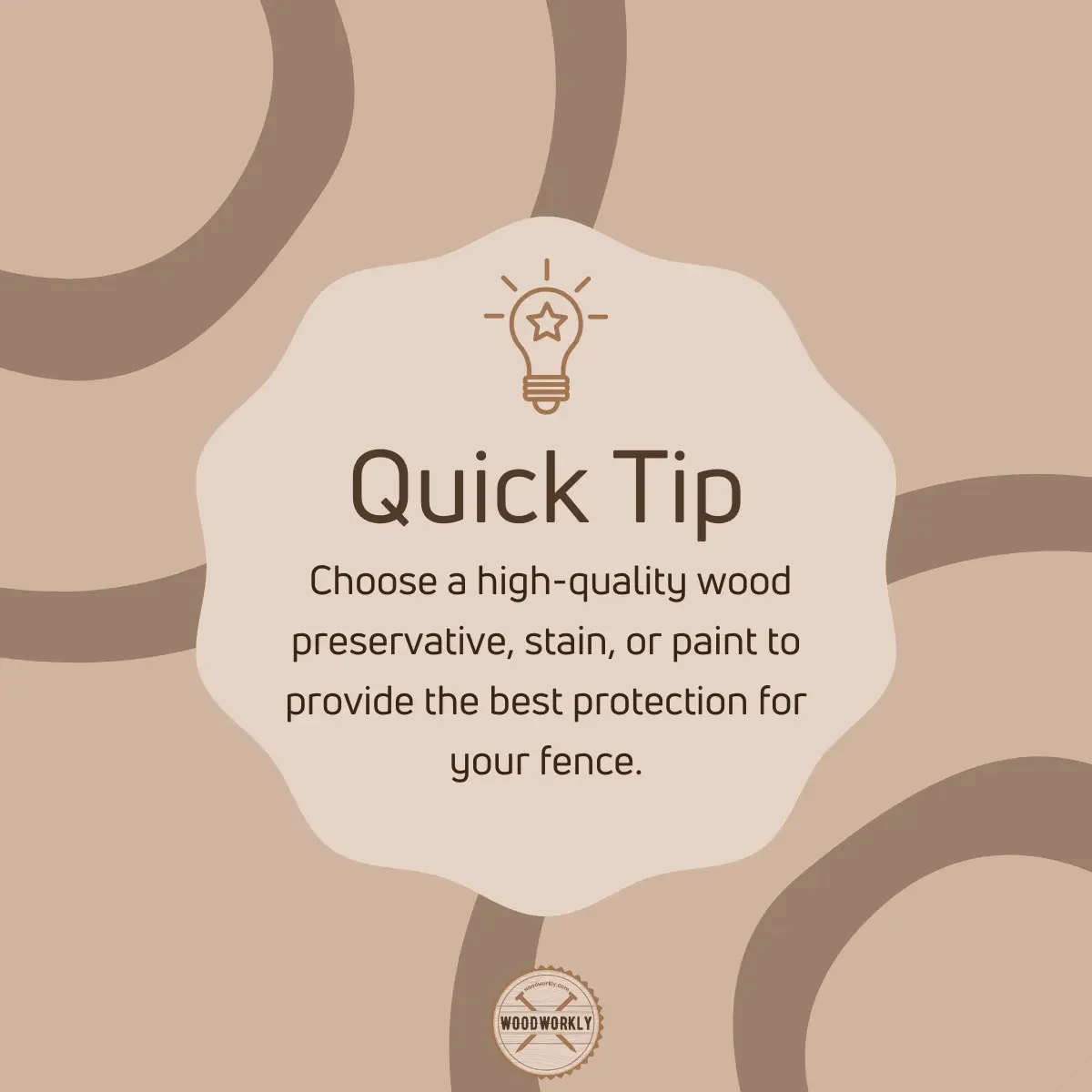
Is Pine Or Cedar Better For Fence?
Cedar is generally preferred for fencing due to its longevity, natural resistance to decay, insects, and moisture, and its aesthetically pleasing appearance.
Its natural oils not only provide a distinct aroma but also enhance its durability, making it less prone to warping and shrinking.
Conversely, pine is a more cost-effective and readily available alternative.
While pine fences are often pressure-treated to boost their resistance, they may not last as long as cedar and typically require more frequent maintenance, including staining or sealing, to maintain their appearance and structural integrity.
Ultimately, the choice between cedar and pine depends on balancing factors like cost, availability, and the desired level of maintenance.
What Grade of Wood Is Used For Fences?
The grade that is used for fences depends on the specific needs of the project and the budget you have.
Here are some common wood grades used in fencing:
Clear Grade
This is the highest grade of wood, featuring minimal knots, blemishes, or imperfections.
Clear-grade wood offers the best appearance and is often used for decorative or high-end fencing projects. It is also the most expensive option.
Premium Grade
This grade offers a good balance between appearance and cost. It has fewer knots and imperfections than lower grades but may not be as flawless as clear-grade wood.
Premium grade is suitable for most residential fencing projects where appearance and quality are essential.
Standard Grade
Standard-grade wood is more affordable and features a higher number of knots, blemishes, and imperfections.
This grade is often used in utilitarian or budget-conscious fencing projects where appearance is not a top priority.
It is still structurally sound but may require more maintenance to maintain its appearance.
Rustic or Utility Grade
This grade has the most imperfections and knots, which may affect its structural integrity and appearance.
Rustic or utility-grade wood is typically used for temporary fencing, agricultural applications, or projects where aesthetics are not a primary concern.
When selecting the grade of wood for your fence, consider your priorities in terms of appearance, durability, and budget.
Remember that higher grades will generally last longer and require less maintenance but come at a higher cost.
Now you know how to select the grade that suits you the most according to your needs and the budget you got.
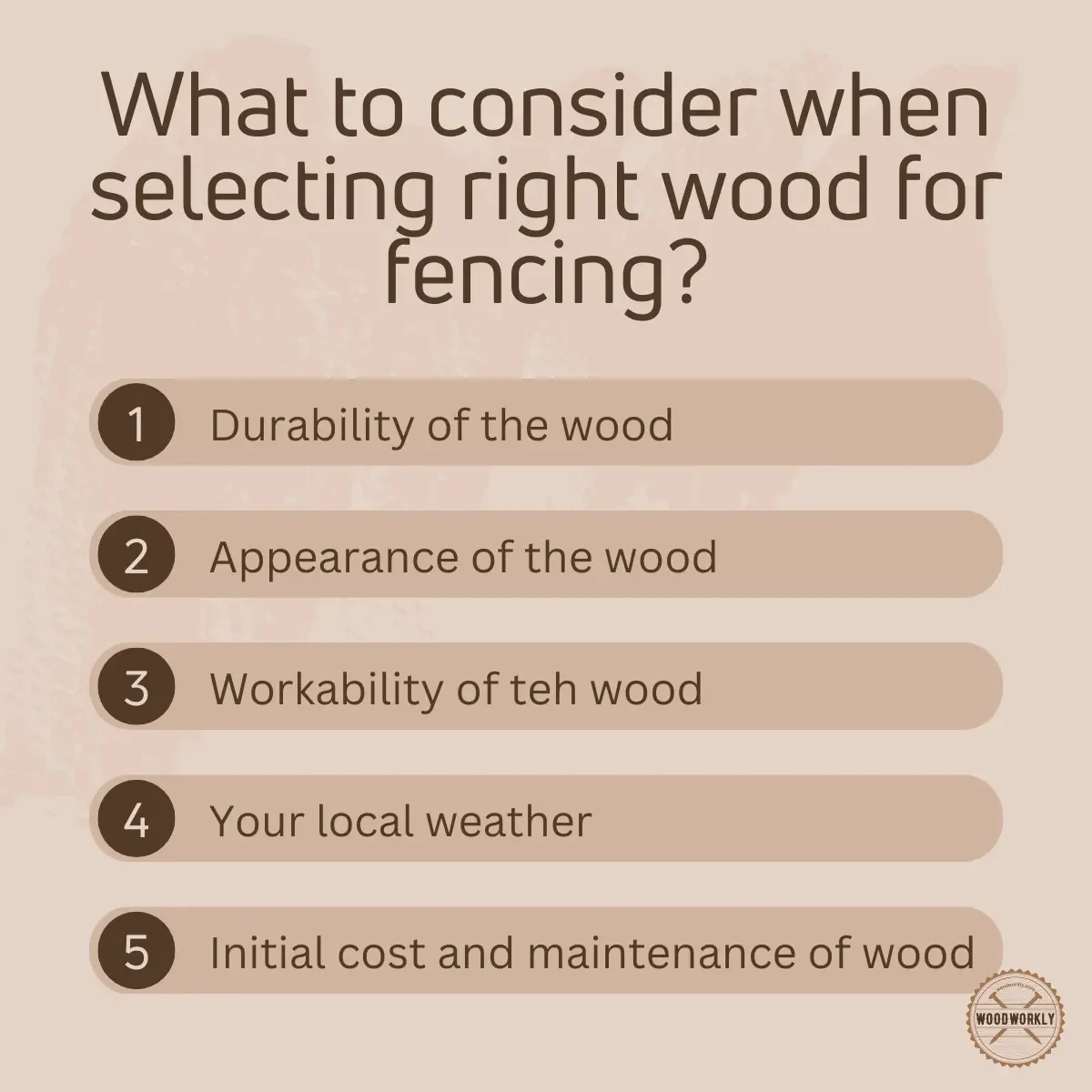
What Is The Cheapest Type Of Wood Fence?
Pressure-treated Pine or Spruce is the cheapest type of wood fence. These softwoods are more affordable than hardwoods or exotic species because they are abundant and grow more rapidly.
Keep in mind that while these options are cheaper upfront, they may require more maintenance and have a shorter lifespan compared to other, more expensive wood species.
How Long Will A Wooden Fence Last?
Wooden fence will last anywhere between 10 to 30 years if it is well-built and properly maintained.
But the lifespan of a wooden fence depends on various factors such as the type of wood used, the quality of construction, and the level of maintenance provided.
Here’re the average lifespans of some popular wood fences,
| Fence Material | Average Lifespan |
|---|---|
| Pressure-treated Pine | 10 to 20 years |
| Spruce | 10 to 20 years |
| White Cedar | 15 to 30 years |
| Redwood | 15 to 30 years or more |
| Ipe, Teak, Black Locust | 50 years or more |
To prolong your fence’s life, it’s essential to perform regular maintenance, such as sealing, staining, or painting, and to address any signs of damage promptly.
What Are The Best Wood For Fence Rails?
The best wood for fence rails are Cedar, Redwood, Pressure-treated Pine, and Black Locust since they are strong, durable, and resistant to decay and insect damage.
The choice of wood for fence rails will depend on factors such as budget, availability, and the desired aesthetic.
It’s essential to consider the local climate and environmental conditions when making your decision, as this can impact the wood’s performance and longevity.
What Are The Best Wood For Painted Fence?
- Pine
- Cedar
- Spruce
- Cypress
- Pressure-treated wood
make sure to restore them at least once per two years with a new coat of paint to keep them fresh and new and protected from outdoor elements for so long.
Spruce Fence Vs Pine Fence
| Spruce | Pine | |
| Price | More affordable | Moderately priced |
| Color | Lighter | Light to medium |
| Resistance | Less resistant | Pressure-treated |
| Lifespan | 4-7 years | 10-15 years |
What Are The Best Wood For Fence Posts?
- Black Locust
- Osage Orange
- Pressure-Treated Pine
- Cedar
- Redwood
How Do I Maintain A Wooden Fence?
To maintain a wooden fence, regularly inspect it for any damage or rot, clean it with a mild soap solution or a specialized wood cleaner, apply a water-repellent sealant or stain, and repaint or re-stain it as needed to protect the wood from the elements.
Additionally, ensure that vegetation and debris are cleared away from the fence to prevent moisture damage.
Did I cover all you wanted to know about Best Wood For Fence
In this article, I have deeply explained about 16 different options to select the best wood for fence with characteristic features of each wood with their advantages and disadvantages.
Best wood for fence are Pine, Redwood, Sweetgum, Spruce, Cedar, Cypress, Black Locust, Osage Orange, Douglas Fir, Ipe (Brazilian Walnut), Bamboo, Balau, Oak, Teak, Composite, and Pressure-Treated Wood. They have excellent durability, appearance, workability, and resistance to insects and rot.
Furthermore, I’ve answered some frequently asked questions as well.
So, we’ve gone through a whole bunch of awesome best wood for fence projects, and now you’re all set to make a well-informed decision.
No matter if you’re a woodworking pro or just starting out, this article is packed with valuable info to help you pick the ideal wood for your fence.
Now, how about taking the plunge and building a DIY fence using one of these fabulous wood types?
Trust us, the right wood can truly transform your fence into a long-lasting, gorgeous masterpiece.
So, go on, let your inner artist shine, and get those creative juices flowing – the wonderful world of wood fencing is waiting for you! Best of luck, and most importantly, have a blast!